- BACKPACKERS WANDERLUST - AN AWARD WINNING TRAVEL BLOG
- Work With Me

- DISCLOSURE & PRIVACY POLICY
- United States
- Cook Islands
- New Caledonia
- New Zealand
- Accommodation Goals
- Budget And Cost Of Travel
- Foodie Goals
- Packing & Planning
- Travel Inspiration
- Volunteering Abroad
- Working & Studying Abroad
- Other Travel Tips

Exploring The Imperial City Of Hue, Vietnam
Find out about spending a day exploring the Imperial City of Hue in Vietnam. Learn about how to get there, the history, important information, my experience, and more in this Hue Imperial City guide!
Visiting the Imperial City of Hue when in Vietnam will no doubt be a highlight of your trip. With amazing architecture, an impressive history, and the most stunning grounds you will certainly be in awe.
The Imperial City of Hue is the biggest draw for tourists coming to this area. We made the surprisingly comfortable overnight train journey from Hanoi just for this reason! The city of Hue itself is full of culture and history and the Imperial City just adds to this even more. It is easy enough to spend a whole day exploring. Though under the hot Vietnamese sun you probably wouldn’t want to. So let’s get into everything you need to know for your visit, that way you know what to expect and can have an enjoyable experience.
Visiting The Imperial City Of Hue (The Citadel): All You Need To Know
- The History Of The Imperial City
Imperial City Of Hue Entry Fee/ Ticket Costs
The imperial city of hue opening hours, how to get to the imperial city, hue, what to wear at the imperial city, what to expect inside the imperial city of hue, diy or group tour, what to bring, hue travel tips.
🚗 How I Book Cheap Transport In Vietnam: Baolau & 12.Go Asia

The History Of The Imperial City Of Hue
The Imperial was built in 1362 and in 1993 was recognized as a UNESCO World Heritage Site. Between these two periods of time, the walls of the city have witnessed a lot of history. It even served as the capital of Vietnam from 1802 to 1945 during the reign of the Nguyen dynasty.
In the 19 th century, Gia Long was the first emperor of the Nguyen dynasty. He made this dynasty with questionable tactics of blood and attacking those other emperors and rulers in the region. The goal was to take over their land and unite them all into one single empire, which he was ultimately successful at.
This dynasty would be the last in Vietnam and would rule for 143 years. The city of Hue would be the capital and there was a reason they choose Hue as their base. Supposedly the river and mountains that surround Hue looked like snakes and lions, well at least it did according to the geomancers. It would be the perfect location to recreate a version of the Forbidden City of Beijing.
With that become the process of building the enormous complex envisioned. A 10-kilometer moat was dug on the outside with each 2 kilometers long and 6-meter high wall enclosing the square fortress we call the Imperial City of Hue.
On the inside was everything you would expect of a country’s capital. From offices, palaces to residences and gardens. Though, the most important part was built in the middle, The Purple Forbidden City. This is where the emperor and those closest to him would live and work.

The entry ticket to visit the Imperial City Of Hue costs $6.60 / 150,000 VND.
These tickets are purchased in the main building which acts as the entry point to access the inside of the citadel (pictured above). It is well worth the price, though if you have a little bit more money in your budget I would recommend hiring a guide to teach you about the amazing history.
SCAM ALERT! I have read numerous reports about the ticket sellers here exchanging notes and claiming you did not give them enough money and demanding more. An example is you pay 300,000VND, part of this is a 100,000VND note. They will quickly swap your 100,000VND note for a 10,000VND note under the table and say you did not pay the correct amount. The best way to prevent this happening is to look like you are recording (to put off the scam artist as you would have captured this on camera) and counting out the money as you hand it to them. This personally did not happen to me, though just something to be aware of.
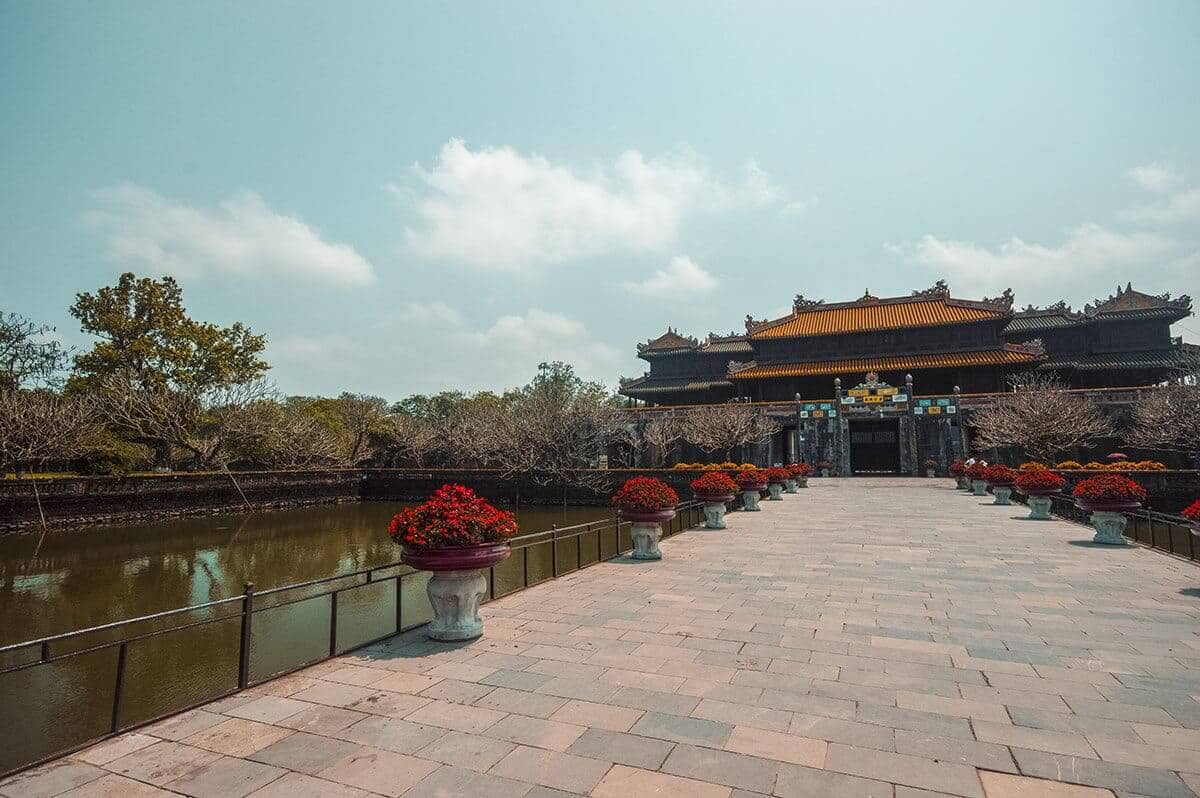
The opening hours for the Imperial City of Hue are from 8:00am-5:30pm Friday to Wednesday .
On Thursdays, the Imperial City of Hue opens at 8:00am and closes at 10:00pm . This allows visitors to experience the Imperial City of Hue by night and be able to see the grounds in a whole new way.

The Imperial City Hue is located at Thành phố, Huế, Thua Thien Hue, Vietnam. Likely you will be saying at the opposite side of the bridge to where the Imperial City is. This is because the majority of accommodation, restaurants and new buildings are on the other side of the river.
By Grab: If you haven’t yet downloaded the Grab app on your mobile phone I highly recommend you get it. This is basically the Uber of Southeast Asia and is super helpful for getting you from point A to point B. There’s no more haggling to get a decent fare, begging drivers to turn the meter on, or confusion over where exactly to drop you off. Depending on whether you are traveling with a group or solo you can either order a motorbike for one person or instead, a car for a group of people.
By Walking: This was the option I choose to get to the Imperial City and was certainly an easy way to do it. We decided to visit in the early morning simply because it would be cooler than at midday. It was a few kilometers from our guesthouse we stayed at, though the beautiful river views made time fly. If you are unsure how to get there I highly recommend downloading the Maps.Me app on your phone. On it, you will be able to use an offline map of the area to navigate there even if you do not have a local sim card.
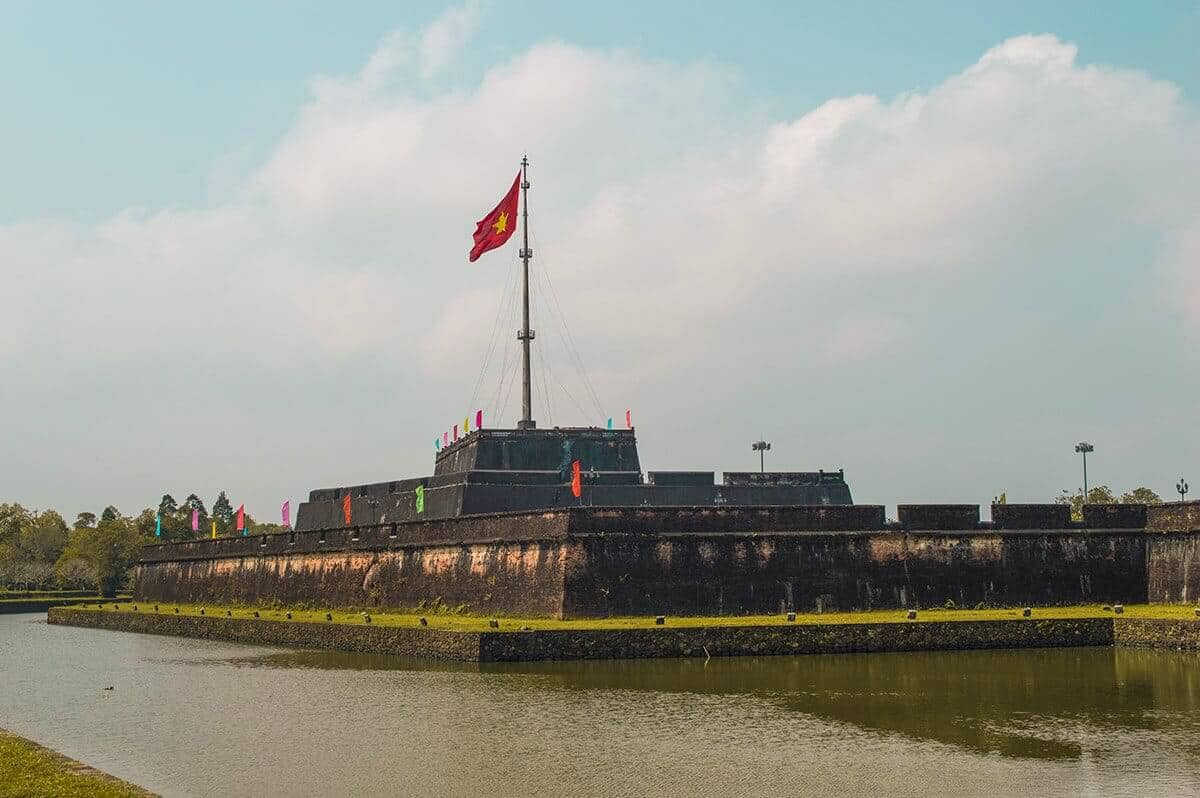
I was honestly not sure what to wear when I was visiting the Imperial City of Hue. Coming from Thailand where I was used to covering up when visiting religious and important buildings, I thought it would be necessary to cover up the shoulders and knees. Though, this proved irrelevant as people were wearing shorts and singlets everywhere with no worries.
So, you do not have to be like me, covered completely up and walking around in the Vietnamese heat.
I also recommend bringing a bottle of water with you as it will get quite hot exploring the citadel. We only found one building on the inside to buy extremely overpriced drinks and food.

These days the Imperial City of Hue is no longer what it was. Throughout time the buildings have suffered much damage and some of the grounds have become overgrown. The Forbidden City was never properly maintained and had issues with frequent termite infestations as well as typhoon damage.
Though, during the American War is when the Imperial City suffered the majority of the damage which has left it how it stands today. When the American forces entered Vietnam in 1968 they ordered the city be retaken, due to the communist takeover techniques implemented by the Nguyen dynasty to originally gain control of the land.
As a result, the Imperial City in Hue was badly bombed. Now only 20 of the 148 buildings which once stood on the grounds are still intact. Nevertheless, the restoration and reconstruction of the Imperial City of Hue is an ongoing task nowadays thanks to being recognized as a UNESCO World Heritage Site.

My Experience Visiting The Imperial City
I actually loved visiting the Imperial City in Hue. It was completely different from anything I had seen in South East Asia thanks to the Chinese-inspired architecture. Just be prepared to be walking around for a long time. The grounds are massive! We spent about three hours walking around and definitely could have spent longer if it was not so hot.
I recommend visiting when it opens in the morning to avoid the unbearable heat, especially considering there are not actually that many shady spots within the Imperial City. Also, bring water and food with you. We went to purchase bottled water within the city walls at one of the little cafes and it was ridiculously overpriced, about $4.00 for a small bottle!

My partner and I did a DIY self-tour of the Imperial City. This is oftentimes how we do travel to keep our budget low, but still, experience the highlights within a city. Though, this obviously has its limitations as you are not able to learn about the history, which there is a lot of here.
From the first look, the tours around the Imperial City may seem pricey. Though, they do include a lot, making the most out of your time in Hue. For example, this Hue City Group Tour includes lunch, a visit to the imperial city, a dragon boat ride, the popular Thien Mu Pagoda, and the tomb of King Khai Dinh. The tour starts at $50.00 and includes all entry fees. This is great value for money for traveling in Hue and allows you to see the best sights in the city (something we were not able to do due to the vast distances between them).
If you do not plan to visit Hue but are kind of regretting it now, don’t worry as there are day trips there from the popular tourist town Hoi An . For only $4.00 more the Hue Imperial City Tour From Hoi An And Da Nang include all of the above, plus return transfers on the beautiful Hai Van Pass.
BOOK YOUR TOUR:
The Imperial City of Hue is closed in, so you won’t be able to exit and then easily come back in to continue exploring. This place is also huge so expect to spend a good few hours exploring.
Camera: Make sure to bring your camera. This place is super beautiful and you will want to be snapping lots of photos!
Food & Water : Now I spent 3 hours exploring, and that was doing it fast with minimal reading of the information available. If you want to do this place justice then make sure to bring along some food and water so you can have a little picnic during your visit. There is a cafe on site but everything is ridiculously overpriced.
Sunblock: Yes, definitely bring sunblock. The sun in Vietnam is a scorcher. Though there are quite a few buildings in the Imperial City of can hide out in. The distances between these buildings can be a decent walk. No doubt you will want to be exploring the beautiful gardens as well.

Get ready for your trip to the Imperial City of Hue by checking out my top travel tips. This will allow you to have a fun and stress-free time exploring the city.
Where To Stay While In Hue?
When choosing where to stay in Hue you will be absolutely spoilt for choice. No matter your budget or the type of traveler you are there is something to fit all needs. Whether you want an affordable hostel, welcoming guesthouse, or luxury hotel
When To Travel Hue
As with most places in Southeast Asia, Hue has a wet season and a dry season. Depending on when you visit can seriously affect how your trip goes and honestly what you can do/see. Ultimately the best time to visit Hue is between January and April . The weather is good, but the temperatures are not too hot yet.
September To December is the wet season in Hue. During this time the temperature won’t be so hot, though you could be in for quite a bit of rain. This is also the typhoon season so the train can last from hours to days and shut down essential services if flooding begins.
January to August is the dry season as well as the high season. During these times temperatures can be anywhere from 30 degrees celsius to 40 degrees celsius.
How To Get To Hue
Depending on which direction you are traveling Vietnam can affect how you can get to Hue. Though it is likely you will either be traveling from the North or South of the city. Transport routes are great and you will have multiple different options for how to get there. Though for more detail I recommend checking out my Hanoi to Hue travel guide .
Tickets for all journeys can be purchased on Baolau or 12.Go Asia
Train : from Hanoi to Hue takes 14 hours to complete your journey. Even though this is the longest choice it certainly is the most comfortable if you happen to book a soft sleeper so it isn’t all bad!
Bus : The trip from Hanoi to Hue takes approximately 12 to 13 hours .
Plane : It takes approximately 1 hour to travel from Hanoi to Hue on a plane.
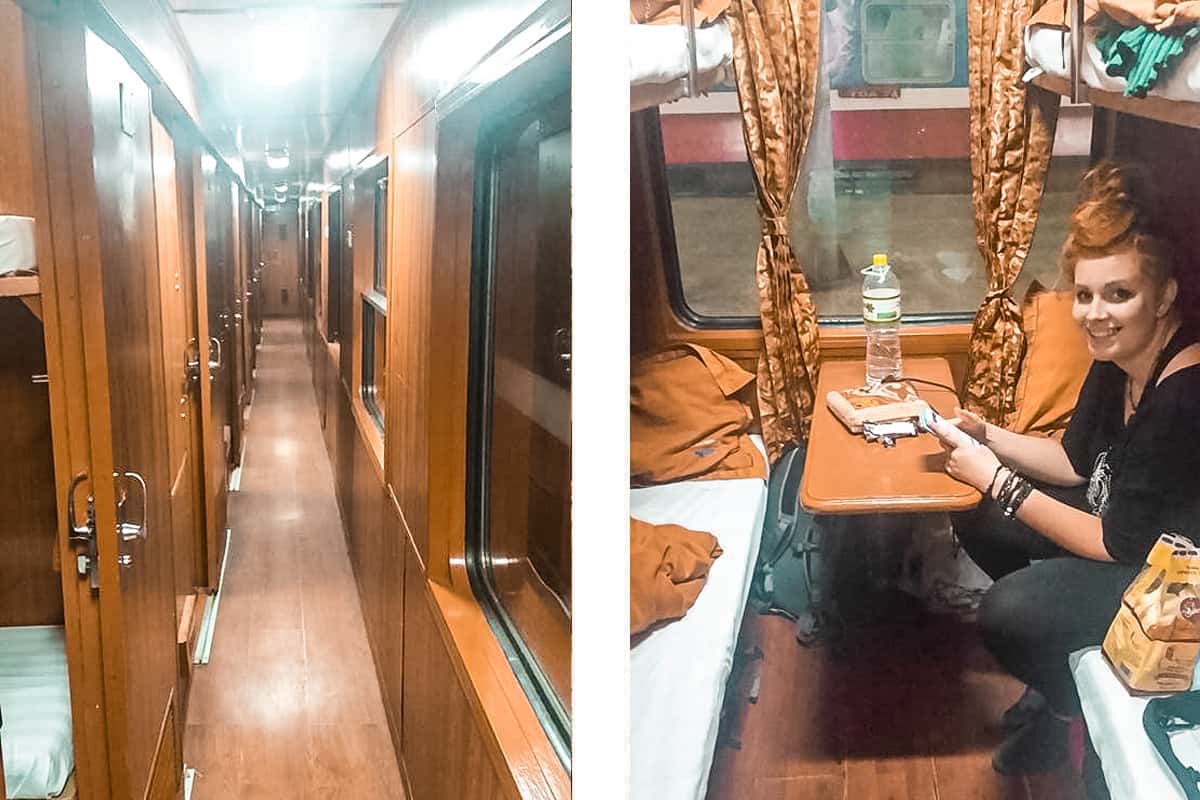
Staying Safe While In Hue
The main thing to remember is to just use your common sense. This should keep you out of dangerous situations. I wasn’t scammed or taken advantage of once in Vietnam. Though I put this down to doing my research in advance and becoming familiar with common scams.
Hue is a relatively safe place to explore with the exception of the many scams you will find in Asian countries. This mainly revolves around robberies and pickpocketing. In Vietnam motorbike snatch and grab is super common as well. Someone may see that your handbag, backpack, camera, or phone is not secure, so they will drive by on their motorbike and grab it. While in Sapa there did seem to be quite a lot of people offering us drugs while we would be walking along the street.
Don’t drink the water out of the tap. Many hotels and hostels will have water refill stations or minimarts sell bottles super cheap as well.

Where To After Your 3 Days In Hue Itinerary?
North: If you are traveling North from Hue, you could take an overnight journey to Hanoi . Hanoi to the perfect hub, where you could venture to Thailand or Laos via the international airport, or if you are wanting to stay domestic, then hit up Sapa or Ha Long Bay . You could also head to Ninh Binh which is between Hanoi and Hue. I haven’t personally been yet, but I have heard great things, and it’s on my bucketlist!!
South: Alternatively, you can end back down South towards some other Vietnam highlights including Hoi An , snorkel In Nha Trang , see the sand dunes in Mui Ne , and the tunnels in Ho Chi Minh . Vietnam is a huge country and there are so many things to do here!
LIKE IT? PIN IT!

Want more Vietnam Inspiration? Check out….
- EXPLORE HA LONG BAY ON A BUDGET, VIETNAM
- TRA QUE VEGETABLE VILLAGE IN HOI AN, VIETNAM
- 2 DAYS IN HUE BACKPACKING ITINERARY
- A MORNING AT THE MY SON TEMPLES IN HOI AN, VIETNAM
- EXPLORE THE IMPERIAL CITY OF HUE IN VIETNAM
- HANOI TO SAPA
- SURVIVING A VIETNAM SLEEPER TRAIN
- TAKING A VIETNAM SLEEPER BUS: WHAT YOU NEED TO KNOW
- HOW TO SPEND 3 DAYS IN SAPA
- TRAVELING FROM HANOI TO SAPA
Disclaimer: This post contains affiliate links. So, if you click on it and purchase something, I get a small percentage at no extra cost to you. As always all opinions are my own and your support is much appreciated.
Related Posts
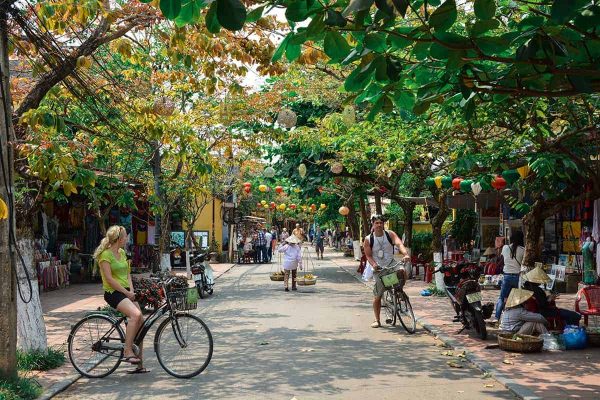
Backpacking Hoi An Itinerary: What To Do & Travel Tips
Come find out all you need to know about backpacking Hoi An to have the [...]

Best Beaches In Nha Trang Worth Visiting In 2024
Come check out crystal clear waters by exploring the best beaches in Nha Trang. Beach [...]

Find out about spending a day exploring the Imperial City of Hue in Vietnam. Learn [...]
12 Comments
Tasha Amy is a true backpacker at heart and has been discovering the world on a budget since 2015. Based in Gisborne, New Zealand she will spend many months each year traveling overseas as a solo female traveler before coming home and sharing her adventures online with you.
12 thoughts on “ Exploring The Imperial City Of Hue, Vietnam ”
What a great and useful article! I loved exploring Hue!
Hey David Thank you for your feedback. Agreed, Hue is a spectacular city and a must visit in Vietnam! Tasha Amy
Hue Imperial City is the rectangle ground, surrounded by the second wall with about 620mX580m, which protects the most important places of the royal court, living areas of royal family members, shrines areas of the Nguyen’s ancestor and the Forbidden City. https://adventurejourney.vn/vietnam-travel-blog/hue-imperial-city-information-of-vietnam-royal-palace-in-hue.html
Yeah, Hue is such a great city to visit and to live in. Everything is perfect for tourists from hotels, homestays, restaurants, street foods as well as world heritage sites. Transportation is easy to access and very affordable. I booked the https://culturephamtravel.com/tours/hue-city-tour/ and they provided very good quality. In my personal idea, if you visit the Hue Imperial Citadel or the royal tombs, you should book a tour or get a guide. You will learn a lot. We really love Hue.
Wow! 1362?! That’s crazy. I would loooove to see something like this. You covered everything perfectly. Adding it to the list.
I loved Hué! I was there a few weeks ago. We only got to spend two hours in the Imperial City as we did it in a day tour but I found it so interesting. Loved the throne room!
Can’t believe I haven’t heard of this place! I would probably want to hire a guide as you suggested so I could dig a little deeper. Thanks for the tips about how large it was – I wish I had known this when I visited Pompeii! It was the height of summer and also really hot and I wasn’t prepared!
This place is so gorgeous. I never realized how cheap it was to visit Vietnam – $7 for a private room with a private balcony?! That’s amazing! Also, loved the history bit at the intro – helped me learn so much more about Vietnam. :)
Vietnam is my big planned holiday next year so this is well handy. Thanks for the great post, parking for reference!
I’m planning on visiting Hue on my SE Asia trip next year and I’ve definitely put the Imperial City on the list now! Looking through your other posts for more inspiration now! I cannot wait for $7 private rooms!!
PS. Love your pictures!
I was in Da Nang, a little bit south of Hue this year and did not visit Hue. Now I wish I had. The pictures are really beautiful.
Your photos are so good and capture the place so well. I like that you covered so many important points. Had no idea you were able to reach the city by train from Hanoi. That opens a new world for me!
Leave a Reply Cancel reply
Your email address will not be published. Required fields are marked *

HUE IMPERIAL CITY
HUE IMPERIAL CITY - UNESCO WORLD HERITAGE SITE IN HUE

Right in the heart of the peaceful and poetic Hue city lies Hue Imperial City (Hue Citadel) which belongs to the Complex of Hue Monuments, recognized by UNESCO as a World Cultural Heritage. This Imperial Citadel is one of, if not, the most famous tourist attractions in this ancient city, that you shouldn’t miss when visiting Hue.
I - Outstanding architecture of Hue Imperial City
Ii - the impressive buildings inside the hue imperial city, 1 - ngo mon (hue noon gate or meridian gate), 2 - thai hoa palace in hue imperial city, 3 - duyet thi hall in hue citadel, 4 - can chanh palace in hue imperial city, 5 - dien tho palace in hue imperial city , 6 - long an palace in hue citadel, iii - essential information about the ancient imperial city of hue, 1 - how much is the hue imperial city entrance fee, 2 - how to travel inside hue imperial city, 3 - photography service inside hue imperial citadel, 4 - exploring “hue imperial city at night”.

Once the living and working place of the kings and the royal family, Hue Imperial City is also a place to worship ancestors and kings of the Nguyen Dynasty. This work includes more than 100 unique and ancient architectural buildings, preserving the memory of a powerful feudal period in Vietnam. Coming here, you can not only admire the breathtaking landscapes but also have the opportunity to learn about the rich history of this land.
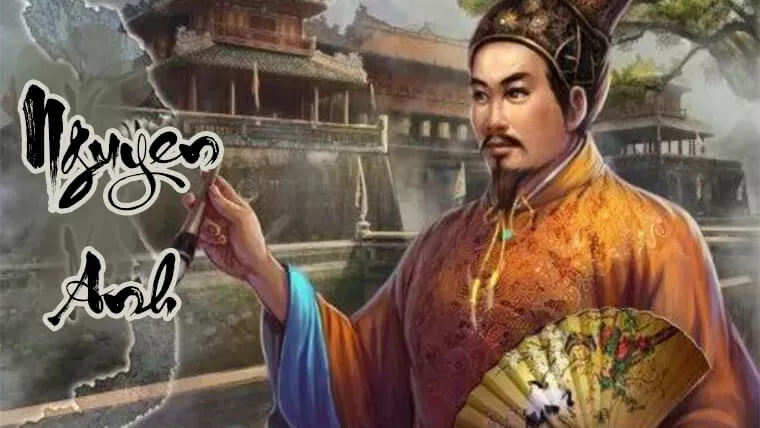
King Nguyen Anh - Source: Internet
As a massive work with high architectural value, Hue Citadel was built over a period of nearly 30 years - started in 1804 under the reign of King Gia Long and completed in 1833 under King Ming Mang. The construction is a unique combination of traditional Vietnamese architecture, Oriental philosophical ideology, and Yin-yang theory, influenced by a type of Western military architecture called Vauban.
Hue Imperial City was built in a square shape, arranged 4 doors in 4 directions, of which the main one is Ngo Mon and the remaining three are Hoa Binh, Hien Nhon, and Chuong Duc. In addition, inside the Imperial Citadel, there are Thai Hoa Palace, Dien Tho Palace, Hue Purple Forbidden City… which are divided into many different areas with different purposes. The entire inner construction system is arranged according to the symmetrical axis, in which the center is arranged mainly for the King.

Lotus lake inside the citadel - Source: Vntravellive
Although in Hue Imperial City, there are many buildings of various sizes, all are interspersed with lakes, gardens, stone bridges, islands, and green trees, in harmony with nature. Overall, the palaces in the Imperial City of Hue are roofed with special tubular-shaped enameled tiles, often called Thanh Luu Ly (if they are blue) or Hoang Luu Ly (if they are yellow). Buildings were built on high stone bases, seamed with Thanh stones, tiled with green or yellow Bat Trang enameled tiles, with pillars painted according to the motif of Dragon-Clouds.
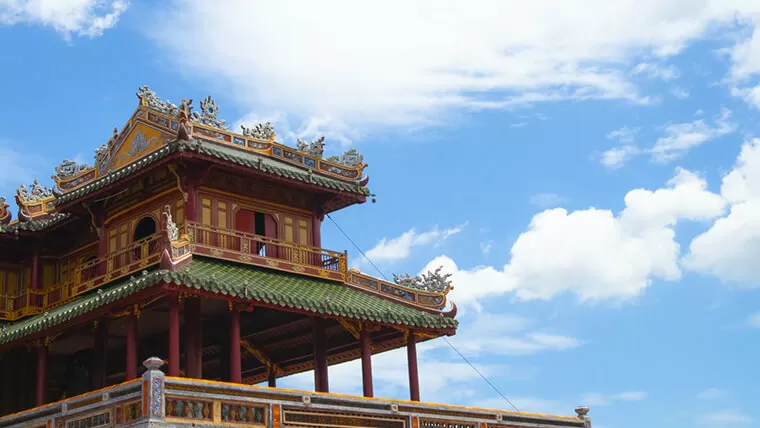
A corner of Hue Imperial Citadel - Source: Veronica Reverse
During war periods in the 20th century, many royal architectural works in Hue were seriously destroyed by natural disasters and bombing, including the Imperial Citadel in Hue. Overspending fluctuations and time, many buildings are badly damaged, only less than half of the impressive original constructions still exist include:
Located in the South of the Hue Imperial City, the Noon Gate is the main gate with two levels, used to be a king-only entrance or to welcome foreign messengers, now a ticket booth. The ground level has five entrances, of which the center one was always reserved for the king while mandarins entered through the two smaller side entrances. The two remaining small arched doorways were for the soldiers, horses, and commoners.
The second level of Noon Gate in Hue Imperial City was called Lau Ngu Phung (Five Phoenix Pavilion) with two floors completely structured of Lim wood with 100 pillars. The roofs of the Pavilion are decorated with shapes of various animals and creatures, including phoenix to ward off evil, making the building look light and elegant. The lower roof is connected to cover the hallway while the roof of the upper floor is divided into 9 sets, in which the middle set is covered with yellow lapis lazuli tiles, and the remaining eight seats are covered with blue lapis lazuli tiles.
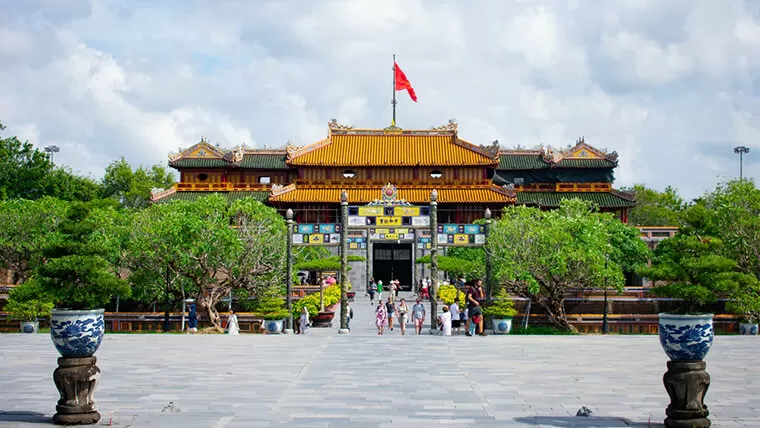
Thai Hoa Palace - Source: Kon Karampelas
Located in the center of Hue Imperial Citadel, Thai Hoa Palace is the place used for important court ceremonies, symbolizing the power of the Nguyen Dynasty. The superstitious palace was built on a 1-meter high base with an area of 1360m², overlooking a large yard. This building is supported by 80 Lim-wooden pillars, which are painted and decorated with rattan dragons - a symbol of the encounter between the Emperor and the Mandarins.
The roof of Thai Hoa Palace in Hue Imperial City Vietnam consists of Hoang Luu Ly tiles, not linked into a strip but is divided into three-layer overlaps, avoiding the heaviness and creating a false sense of height for the building. Decoration as well as the architecture of Thai Hoa Palace is usually associated with the numbers 5 and 9, which appear not only in the interior decoration of the building but also on the platforms of the palace.
Through several restorations and repairs, Thai Hoa Palace in Hue Imperial City has more or less changed, the ancient look has been reduced apart. However, its basic characteristics are still preserved, especially the architectural structure and fine art decoration.
Considered the oldest theater of the Vietnamese theater industry, Duyet Thi Hall is not only a royal theater for the king, the royal family, and the mandarins, but also where foreign tourists and envoys were invited to enjoy theater performances. The rectangular theater of Hue Imperial City has a curved edge roof, supported by 2 rows of Lim-wooden pillars, painted with dragons and clouds symbols.
Duyet Thi Hall has been repaired and embellished many times, making its structure no longer the same as before. Over the years of war, natural disasters, and human neglect, this ancient theater has been seriously degraded and it took 7 years (1995 - 2002) for the theater to be completely restored. Since 2004, Duyet Thi Hall in Hue Imperial City has been put into operation for tourists, introducing Nha Nhac Cung Dinh Hue (Hue Royal Music). Nowadays, you have a chance to experience unique theater plays of the Nguyen Dynasty, along with the charming taste of a cup of lotus tea and Hue’s traditional cakes and jams when visiting Duyet Thi Hall in Hue Royal Citadel.
- Performance time: 10am - 10:40am; 3pm - 3:40pm
- Ticket price: 200,000 VND / person ($8.8)
Situated in the Hue Purple Forbidden City, the palace of Can Chanh is where the Emperor set up the court of the Nguyen dynasty, welcomed foreign envoys, and held royal banquets. The palace has the largest and most beautiful wooden structure in the Imperial City of Hue with a platform of nearly 1m high and a surface area of nearly 1000m2. Most of the upper frame structure of Can Chanh Palace is sophisticatedly carved and decorated.
This building was completely destroyed in February 1947. Fortunately, Hue Monuments Conservation Center and Waseda University in Japan preserved and fully restored the palace in 1990 - 1991.
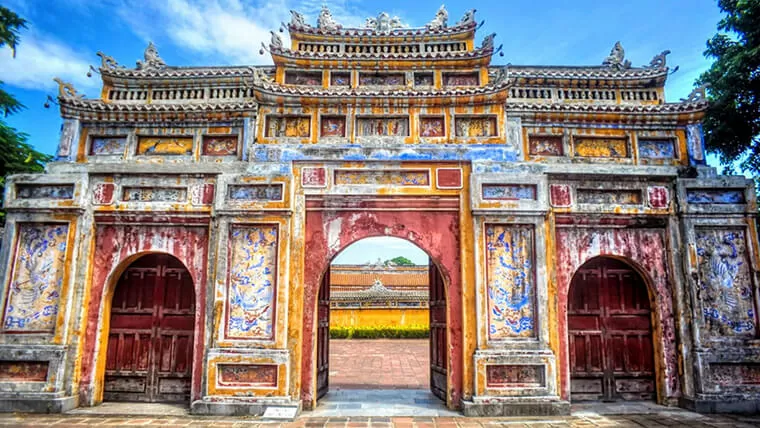
Dien Tho Palace - Source: Homeaz
As the largest palace architecture system in Hue Forbidden City remaining to this day, Dien Tho Palace was once the residence of the Nguyen Kings’ mothers and grandmothers. In the area of about 17,500m2 of Dien Tho Palace, there are about 20 large and small existing architectural works, both rich in types and diverse in architectural styles. Connected to each other by a system of corridors, some of these works are Dien Tho Main Hall, Tho Ninh Palace, Tinh Minh Pavilion, Truong Du Tower, and Khuong Ninh Temples.
As the central work of Dien Tho Palace in Hue Imperial City, Dien Tho Main Hall is built in a rectangular shape, made of bricks and black wood. This massive building has a meticulously and elegant carved roof system, decorated with phoenix birds, roofed with golden lapis lazuli tiles.
Although Long An Palace is outside the scope of Hue Imperial Citadel, it still belongs to the overall Complex of Hue Monuments. What makes this palace different from others is the wooden details that are not painted and gilded, only for carpentry and decorated with sophisticated carving techniques.
Built in 1845 during the reign of King Thieu Tri, Long An Palace of Hue Imperial City was destroyed by the French in 1885 and relocated to its present location in 1909 under King Duy Tan’s reign. The palace used to be King Thieu Tri’s resting place after conducting the plowing ceremony every spring, and also where he used to go to read books, write poems,… Currently, Long An Palace, also known as Hue Museum of Royal Fine Arts - one of the best museums in Hue , is a place to display Hue royal antiquities.
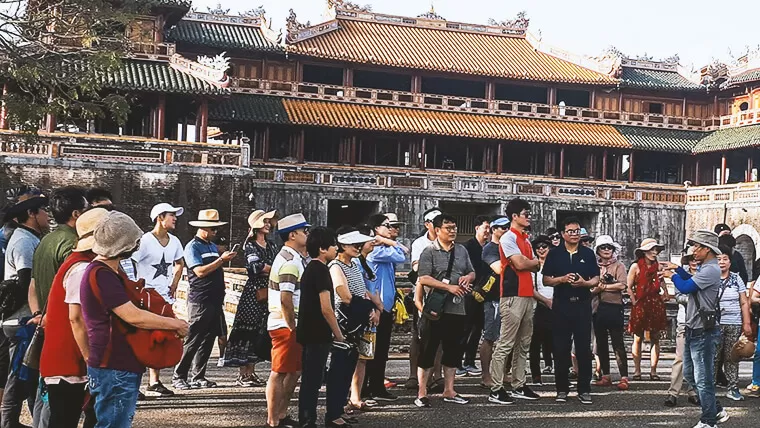
Tourists at Hue Citadel - Source: Le Chung
The entrance fee to the citadel is listed as below:
- Adults: 200,000 VND / person ($8.8)
- Children: 40,000 VND / person ($1.75)
The fee of interpretation service: Booking sightseeing tour that included guide
- Relic site: 150,000 VND / site ($6.6)
- Sightseeing route: 300,000 VND / route ($13.2)
Notes about Hue Citadel opening hours:
- In summer: 8am - 5:30pm
- In winter: 7:30am - 5pm
Walking is always the simplest and the most convenient way for you to sightsee, there will also be stops for you to rest and drink water. You can also refer to the cycle service:
- Price: 30,000 - 50,000 VND / person ($1.3 - 2.2)
- Contact: 088 628 40 44 (Hue Tourist Cyclo Union)
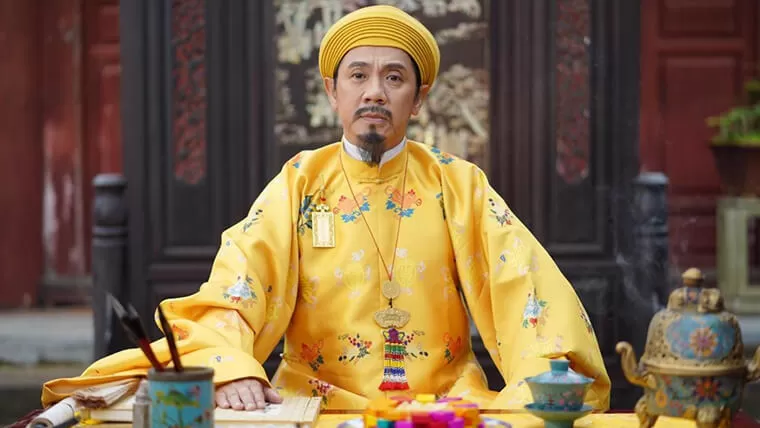
Source: Tuoitrethudo
Sitting on the throne (with 2 maids):
- Adults: 195,000 VND / ticket ($8.55)
- Children: 140,000 VND / ticket ($6.14)
Sitting on the throne in Hue Forbidden City (without maids):
- Adults: 115,000 VND / ticket ($5.04)
- Children: 80,000 VND / ticket ($3.5)
Additional photo (sitting on palanquin): 50,000 VND / ticket ($2.2)
Sitting on rickshaw (adult only): 55,000 VND / ticket ($2.4)
The night is also an extremely ideal time to be able to see the beauty of Hue Citadel when it is lit up with extremely brilliant lights. In particular, the program “Imperial Citadel at Night” officially opened on April 22, 2017, with the desire to create one more highlight in the heritage tour in Central Vietnam.
By booking the program, you have many opportunities to have interesting experiences with Hue Heritage. The program offers tours to luminous landscapes of the Imperial City of Hue such as Ngo Mon Gate, Thai Dich Lake, the Purple Forbidden City Hall, etc. You can also watch royal rituals and art performances including Guard ceremonies, martial arts training, and so on. The “Hue Imperial Citadel at night” program also gives you a chance to experience cultural exhibitions and traditional works.
Opening hours: 7pm - 10pm
Ticket price:
- Haven’t visited the Imperial Palace during the day: 150,000 VND / person ($6.6)
- Have visited the Imperial Palace during the day: 75,000 VND / person ($3.3)
Performance highlights:
- Noon Gate Hue: 7pm; 8pm
- Thai Hoa Palace: 7:10pm - 7:25pm; 8:10pm - 8:25pm
- Can Chanh Courtyard: 7:30pm; 8:30pm
- Hue Purple Forbidden City Hall: 7:35pm; 8:35pm
- Thai Binh Lau Stage: 7:40pm - 8pm; 8:40pm - 9pm
- Duyet Thi Hall: 8:05pm - 8:25pm; 9:05pm - 9:25pm
- Department of Internal Affairs: Experience Hue Traditional Crafts
Traveling to Hue , you must definitely visit Hue Imperial City to admire and immerse yourself in the space of numerous buildings imprinted with ancient architecture. The timeless beauty of Hue Royal Citadel is still there waiting for you to explore, helping you rediscover the memory of a powerful feudal period in Vietnam.

SAME CATEGORY NEWS

Tombs in Hue

FROM HUE TO HA NOI

From Hue To Hoi An

HUE AIRPORT

HUE MARKETS

HUE WEATHER

FROM HUE TO HO CHI MINH CITY

HUE CUISINE

LANG CO BEACH RESORT

Perfume River

HUE RESTAURANTS

THIEN MU PAGODA

KHAI DINH TOMB

Tam Giang Lagoon

Museums In Hue

TU DUC TOMB

HUE BEACHES

LANG CO BEACH

MING MANG TOMB

From Hue To Danang

Bach Ma National Park

Lap An Lagoon

Tu Hieu Pagoda

VIETNAM IN JANUARY

VIETNAM IN FEBRUARY

VIETNAM IN MARCH

VIETNAM IN APRIL

VIETNAM IN MAY

VIETNAM IN JUNE

VIETNAM IN JULY

VIETNAM IN AUGUST

VIETNAM IN SEPTEMBER

November In Vietnam

VIETNAM IN DECEMBER
ARE YOU INTERESTED IN VIETNAM?
Please enter email to get further information for your travel plan
Vietnam Travel Memories
Best memories in vietnam.
Besides nature's beauty, historical relics,.. Vietnamese souvenirs especially handcrafted gifts with unique and catchy processes, also attract tourists a lot. This following article may be the best answer for the question “What souvenir to buy in Vietnam?”
- Visiting the Imperial City of Hue
The dynasties that lived in the Imperial City of Hue didn’t just influence Vietnam, they changed the world.
Written by Michael Turtle
Michael Turtle is the founder of Time Travel Turtle. A journalist for more than 20 years, he's been travelling the world since 2011.
Michael Turtle is the founder of Time Travel Turtle and has been travelling full time for a decade.
Updated: November 24, 2023
The Hue Imperial City was one of the most important political centres of the country and tells a fascinating story about the history of modern Vietnam.
There's lots to see within the Hue Citadel, so I've put together some information to help you plan your visit.
The story of the Imperial City of Hue
- Things to see at Hue's Imperial City
- The international significance of the Hue Citadel
- Some tips for visiting the Imperial City of Hue
Remember the name Gia Long. It’ll be important. And it will relate to more of history than you realise.
This man, born 250 years ago, may not be a household name. He may not be someone you spend hours studying in school. But here in Vietnam, he is integral to the story of the country.
Gia Long was the first emperor of the Nguyen Dynasty. He created this dynasty with blood, attacking self-styled emperors and rulers of different tracts of land in the region – bits that had previously been taken from Siam ( Thailand ) or Khmer ( Cambodia ).
He took their land over a number of years and united them into a single empire. The date was 1802.
What was the shape of this new country? Well, it looked like Vietnam today.
Gia Long had created what we know as modern Vietnam and the Nguyen Dynasty – which would be the last of the dynasties in the country – would rule over it for the next 143 years.
The capital of the Nguyen Dynasty was in the city of Hue, and the Imperial City of Hue was at the heart of it.
Why is the Imperial City of Hue important?
The Imperial City of Hue was the capital of Vietnam during the Nguyen Dynasty, which ruled until 1945. As well as being politically important, the city is also significant because of its exquisite architecture and the way it is blended with the natural setting.
When was the Imperial City of Hue built?
The Imperial City of Hue was constructed from 1803 by Emperor Gia Long of the Nguyen Dynasty. Much of it was damaged in the second half of the 20th century and has been rebuilt in recent years.
Is it worth visiting the Imperial City of Hue?
The Imperial City is not just a highlight of Hue, it’s one of the most impressive heritage sights in all of Vietnam. It’s worth visiting the Hue Imperial City for its art and architecture, and to explore the history of this pivotal era.
The Imperial City still takes up quite a large area of central Hue and it’s certainly the most important thing to see in the city. Within the old walls are a collection of important public buildings, opulent residences, and places of worship.
Much of it has been rebuilt after being damaged in wars, but that’s been done authentically enough that it has still been listed as a World Heritage Site.
What you’ll discover when you visit the Imperial City of Hue are excellent examples of historical buildings from the period of Nyugen Dynasty, offering an insight into this period of the country’s story, and an opportunity to explore why Vietnam is the way it is today.
Gia Long founded the Imperial City of Hue in 1803, less than a year after he had proclaimed himself as emperor of a unified Vietnam and moved the capital to Hue from Thang Long (modern day Hanoi).
The city was once an enormous complex full of all the executive and bureaucracy you would expect from a country’s capital. It was enclosed within a square fortress (also known as the Hue Citadel), with each of the four walls about 2 kilometres long and a wide moat on the outside.
There’s lots to see at Hue’s Imperial City and I would recommend this excellent tour of the site so you don’t miss anything.
The Hue Citadel site was chosen by experts of geomancy, a spiritual science that looks for good omens in the natural landscapes. It was decided that the Perfume River and the mountains here would protect the city, because they looked like snakes and lions.
All through this huge city were temples, palaces, offices, gardens, and residences. The most important bit was in the middle.
It was called the Purple Forbidden City and it was where the emperor and his closest confidants lived and worked. Once, it would have been inaccessible to most people. Now, of course, we can all walk through it and see what remains.
I say ‘see what remains’ because much of the Imperial City of Hue has been destroyed since the Nguyen Dynasty lost control of the country in 1945.
Although natural disasters and the hand of time played their part, it was really the Vietnam War that caused most of the damage.
The North Vietnamese Army attacked Hue in January of 1968 and the Allied forces responded with bombings. Of the 160 significant buildings within the site, only 10 major ones survived the battle.
It wasn’t until the very end of the 20th century that there was a push to restore the Imperial City to some of its former glory. It was named a World Heritage Site in 1993 and work began to rebuild the damaged buildings and preserve those that remained.
Things to see at the Imperial City of Hue
It takes a long time to walk through the Imperial City as a tourist. Partly because of the sheer size but also because there are quite a few different sections to look at.
Buildings in the Hue Citadel have gradually been restored over the years and you can see that more continual work is taking place to restore even more. Although there are large parts of the site that are still empty, there are plenty of things to see.
The first thing you’ll see as you arrive is the Ngo Mon Gate , the enormous structure on the edge of the moat that I think is one of the most impressive parts of the site.
Through to the other side, you’ll find the main Thai Hoa Palace near the main entrance, where the emperor would have conducted much of his official business.
Continuing straight on is Can Thanh Palace , with its beautiful covered alcoves glowing in red and gold.
Along the west of the site are a collection of smaller compounds where some of the main residences once were, including Dien Tho , which was where the queen mother lived.
Make sure not to miss the Hien Lam Pavilion , one of the Imperial City’s most important buildings, which has nine large urns representing the emperors of the Nguyen Dynasty.
The eastern side of the site has fewer things to see, but you will find several significant temples here, as well as the Royal Treasury .
Perhaps the most impressive sight is the East Bastion , another colourfully decorated gate.
There are maps of the Hue Imperial City on display throughout the site to help you get your bearings, and they even have suggested routes to follow. But I found the suggestions to be a bit confusing and it was easy enough just to methodically make your way across the city.
The international significance of the Hue Imperial City
One of the reasons the Nguyen Dynasty was able to come to power in the first place, and remain there for so long, was because of its alliance with France.
French forces helped Gia Long (remember him?) unify Vietnam in the first place through the Versailles Treaty of 1787 (different to the famous treaty after the First World War).
As France expanded its influence in Indochina during the 19 th century, it gradually took more and more control of different territories within Vietnam.
In simple terms, though, the real objective of the French was China and so they were relatively happy for the Vietnamese to keep their emperor as the titular head of the country, even if they had little actual power.
It was this relationship between the emperors of the Nguyen Dynasty and the French that facilitated European control for so long, that led to the First Indochina War, which led to the Vietnam War.
Ok, that’s an extremely basic description of decades of history, but I hope you see the point I’m making.
An event like the Vietnam War, something we consider to be ‘modern history’, can in many ways be traced back to Gia Long taking the assistance of France to create his unified empire.
This is what makes the Imperial City of Hue so interesting to me.
It seems like a part of an old Asian history that you visit because that’s what you do when you’re a tourist in Vietnam. But look at it from a broader perspective and its significance reaches a lot closer to home.
I spend about two hours in the Hue Imperial City – and that’s just wandering around on my own. If you had a guide, telling you the stories and giving detailed information, it could take even longer.
That’s because, remember, the Nguyen Dynasty lasted for 143 years.
If you’re interested in having a local expert show you around, I think this private guided tour is the best option.
There are also some other good options here that offer slightly different ways to see Hue.
It’s also easy enough to visit independently, although I feel like there aren’t enough information signs offering interpretation through the site.
There’s no official dress code for the Imperial City of Hue, although I would suggest avoiding particularly short shorts or singlets that show your shoulders. I would also recommend bringing a hat or some kind of sun protection.
Where is the Imperial City of Hue?
The Hue Imperial City is on the northern side of the Perfume River, across from the central part of the city. You enter through the Meridian Gate, which is off Le Duan street. You can see it on a map here .
How do you get to the Imperial City of Hue?
The Hue Imperial City is across the river from the main train station, if you are coming from another city on the train line. From Hoi An, there are regular buses to Hue. You can easily walk from the tourist area to the main entrance gate (it will take less than 15 minutes).
When is the Imperial City of Hue open?
The Hue Imperial City is open every day from 06:30 – 17:30 in summer and 07:00 – 17:00 in winter.
How much does it cost to visit the Imperial City of Hue?
Admission to the Hue Imperial City for adults is 200,000 VND (US$8.39) and 40,000 VND (US$1.68) for children.
Are there tours of the Imperial City of Hue?
You’ll get a lot more out of a tour of the Imperial City of Hue – and it could also be a convenient way to visit from other cities. I would recommend this tour from Hoi An , or this tour from Da Nang .
Although I think the Imperial City is the highlight, there are some other things to do in Hue as well that you might be interested in.
The most popular sights in Hue other than the citadel are the tombs of the emperors. They are spread out along the Perfume River south of the city. You can get a taxi to take you to see them, you can ride a bike, or you can go on a boat cruise.
Another lovely sight is the Thien Mu Pagoda , which is on a bank of the river and offers a lovely view of the area from the top. It’s a rather tall and striking building and there are a few things to see within the pagoda itself. But it’s really about the scenery here.
Speaking of views, you can also head up to Bunker Hill , which used to be a military vantage point, to get a great perspective of the city.
Like most cities in Vietnam, there are opportunities to see the vibrant and bustling local markets. I would suggest heading to Dong Ba Market if you’re interested in that.
Hue is a great place to do something like a street food tour . Have a look at some of these cool guided experiences around town:
And if you’re looking for a bit of adventure, you might like to head out to this cool abandoned waterpark in Hue .
THE BEST ACCOMMODATION IN HUE
Many tourists pass through Hue quickly but it actually has some spectacular accommodation options if you want to relax.
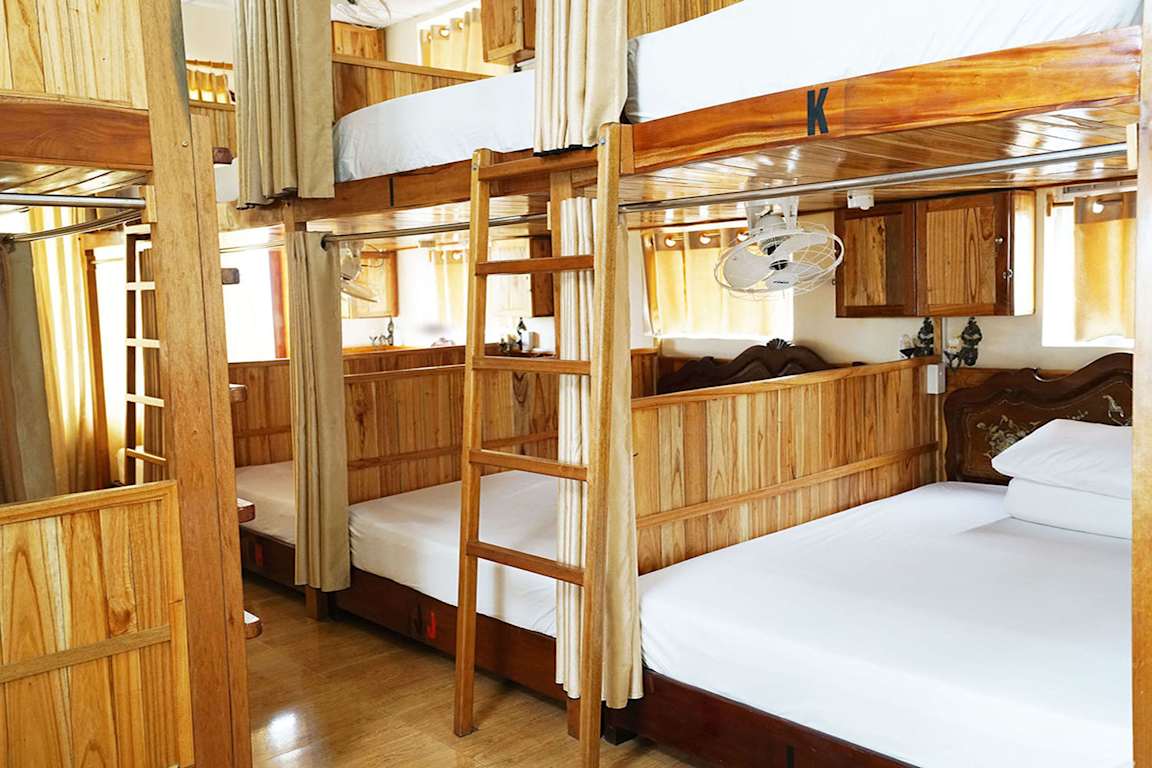
For a good backpacker option, I would suggest staying at Why Not? . (Yes, that’s its real name.)
A good choice for a budget hotel in a great location is the Four Seasons Hotel .
For a relaxing ecoresort, Pilgrimage Village Boutique Resort & Spa is wonderful.
And for luxury by the beach, try Ana Mandara Hue Beach Resort .
This site is on the UNESCO World Heritage List ! I'm on a mission to visit as many World Heritage Sites as I can. Only about 800 more to go... eek!
More stories about Vietnam
- The best places to visit in Vietnam
- A two-week itinerary for Vietnam
- The best things to do in Hanoi
- How to choose a Ha Long Bay tour
- What to do in Ho Chi Minh City
- Things to see in Hoi An
- A tour to the My Son ruins
- The enormous caves of Phong Nha
- All the World Heritage Sites in Vietnam
10 thoughts on “Visiting the Imperial City of Hue”
Excellent piece, Michael.
We didn’t get to Hue on our recent two-week trip to Vietnam – and now I really regret that.
Oh well, next time! 🙂
According to Vietnamese history, Hue Imperial City is the most bulky and large project with the ten thousand people who took part in building, and this complex has been lasted during 30 years under two kings is Gia Long King and Minh Mang Kinh.
Awesome pictures! Exploring the Forbidden City is such a voyage back in time! It’s an amazing place that is so steeped in history and so captivating. Your information was very interesting, I had never thought about how Gia Long’s decisions played a role in shaping such recent history.
I had never thought about the impact of Gia Long either. In fact, I hadn’t even really heard of him. I suspect most people haven’t. But these are the interesting kinds of things you discover along the way! 🙂
The Hue Citadel is the reason why every Vietnamese surname is Nguyen. Because Vietnamese sometimes change their surname to the emperor’s that reigned at that time.
That’s really interesting! I didn’t realise that… but does explain it a bit. I have to admit, it can be a bit confusing to have such a common surname!! 🙂
Really excellent, concise summary of the history! I was just at the Citadel, and this consolidated all the stories for me even more. I linked it with my photos when I posted on fb. 🙂
Also, thanks for mentioning the impact and destruction of the Vietnam War, *and* for connecting it back to earlier history, but for not dwelling on it like sometimes happens (as it becomes the only way us non-Vietnamese think about Vietnam).
Thanks so much! I really appreciate the comment. I always try to make the story of a site interesting and easy to read, without trying to oversimplify it. Glad you found it useful.
Great writing Mike. I love history and, it’s one of the reasons I get to constantly visit Vietnam. One of my favourites is visiting the Citadel. You could easily spend a day in the former walled city of the Nguyen Dynasty.
Leave a comment Cancel reply
In vietnam, i recommend:.
🏨 Hotels: Booking.com 👩🏫 Tours: GetYourGuide 🚌 Bus & train: 12Go
Find me on the socials:
Subscribe for news and deals:.
top stories:
- Top Things To Do In...
Top Things to Do in Hue, Vietnam's Imperial City

Explore the centuries-old citadel, marvel at the Thien Mu pagoda and tuck into sizzling street food while exploring Hue, once home to the emperors of Vietnam. While Hanoi and Hoi An draw in the crowds, the former capital of Vietnam has plenty to attract travellers looking to discover the country’s heritage. Ornate temples and gilded palaces line the banks of the Perfume River, while street vendors serve up a sumptuous array of Vietnamese delicacies. Considering a trip? Read on to discover the best things to do in Hue, Vietnam.
Enjoy a street food tour, cooking class and visit to the Imperial Citadel in Hue as part of Culture Trip’s specially curated 12-day Vietnam adventure, led by our Local Insider .
Explore the Imperial Citadel

Start your time in Hue at the Imperial Citadel, a Unesco World Heritage site comprising a vast complex of temples, palaces, monuments, gardens and pavilions – enclosed by a 6m (19ft)-high wall and moat. Built in the early 19th-century, it was formerly home to the Vietnamese emperors during the Nguyen dynasty, which lasted until 1945. Although restoration work from the First Indochina War and Vietnam War is still ongoing, there are many impressive structures to admire – such as the Thai Hoa Palace and the Forbidden Purple City.

Once you’re finished exploring the Imperial Citadel, stop by this small but beautiful museum which houses a collection of artwork, furniture and textiles from the Nguyen dynasty – it offers a fascinating window into Hue’s storied past. Step inside the main exhibition hall within the Long An Palace, originally built for emperor Thieu Tri in 1845 and converted into a museum in 1923. Entry is included with a ticket to the Imperial Citadel.
Sample the local cuisine
You’ll eat well wherever you go in Vietnam, but Hue is especially renowned as a foodie gem. Bun bo Hue is the city’s signature dish, comprising an intensely flavoursome oxtail broth, vermicelli noodles, beef, pork and fresh herbs, infused with lemongrass, chilli and shrimp paste. Banh khoai, banh beo and nem lui are also ubiquitous. One of the best ways to experience Hue’s culinary delights is to join a street food cyclo tour – which is part of Culture Trip’s 12-day Vietnam adventure .
Visit Thien Mu Pagoda

Built atop a small hill overlooking the Perfume River, just 10 minutes west of Hue, Thien Mu Pagoda is considered the city’s unofficial symbol. It’s one of the most important Buddhist landmarks in Vietnam. The temple itself was founded in 1601, but the most recognisable structure is the 21m (68ft)-high octagonal Phuoc Dien Tower – whose seven storeys each represent a different reincarnation of Buddha – built under Emperor Thieu Tri’s reign in 1844. A giant marble turtle sculpture, with stone steel on its back, is another standout sight. You can easily get here by car, bike, or boat. Entry is free.
Float down the Perfume River
No trip to Hue is complete without taking a boat trip along the Perfume River – whether it’s an organised tour on a wooden dragon boat or a romantic dinner cruise. The river offers magnificent views of the most iconic landmarks in Hue – where it’s particularly idyllic in autumn when bright scarlet flowers bloom along its banks, producing a fragrant aroma. Alternatively, take a stroll along the promenade in the evening, as the river is illuminated by colourful floating lanterns and local performers sing traditional folk songs.
Visit the tombs of former emperors
Mausoleums dedicated to the former Vietnamese emperors are scattered throughout the countryside around Hue, showcasing an eclectic array of architectural styles. The tombs of Minh Mang – which contains 40 monuments surrounded by ponds and pine trees – is a standout one to visit, alongside Tu Duc, with its own lake and gardens and Khai Dinh, featuring extravagant mosaics and sculptures in a mountainside setting.
Snap photos at Thanh Toan Bridge

Instagrammers: make a beeline for this 245-year-old bridge, also known as the Japanese Bridge. The intricately carved gateways open onto a covered roof that arcs over a canal. Aside from snapping photos at the bridge, visit the local market where you can buy fresh fish and local crafts. The journey from Hue is peppered with rice paddies and pagodas, giving you an insight into rural Vietnamese life.
Take a day trip to Bach Ma National Park
Get out of the city and spend a day exploring the Bach Ma National Park, just an hour’s drive from Hue. Forming part of the Annamite Range – a chain of mountains stretching between Laos, Vietnam and northeastern Cambodia – it’s a hiker’s paradise with trails leading through thick jungle, past cascading waterfalls and rock pools, as well as numerous crumbling French villas. Over 1,400 animal species live here, including langur monkeys, leopards and saola – an antelope species considered one of the world’s rarest mammals. Buses regularly run from Hue to Cau Hai village, just outside the park.
Since you are here, we would like to share our vision for the future of travel - and the direction Culture Trip is moving in.
Culture Trip launched in 2011 with a simple yet passionate mission: to inspire people to go beyond their boundaries and experience what makes a place, its people and its culture special and meaningful — and this is still in our DNA today. We are proud that, for more than a decade, millions like you have trusted our award-winning recommendations by people who deeply understand what makes certain places and communities so special.
Increasingly we believe the world needs more meaningful, real-life connections between curious travellers keen to explore the world in a more responsible way. That is why we have intensively curated a collection of premium small-group trips as an invitation to meet and connect with new, like-minded people for once-in-a-lifetime experiences in three categories: Culture Trips, Rail Trips and Private Trips. Our Trips are suitable for both solo travelers, couples and friends who want to explore the world together.
Culture Trips are deeply immersive 5 to 16 days itineraries, that combine authentic local experiences, exciting activities and 4-5* accommodation to look forward to at the end of each day. Our Rail Trips are our most planet-friendly itineraries that invite you to take the scenic route, relax whilst getting under the skin of a destination. Our Private Trips are fully tailored itineraries, curated by our Travel Experts specifically for you, your friends or your family.
We know that many of you worry about the environmental impact of travel and are looking for ways of expanding horizons in ways that do minimal harm - and may even bring benefits. We are committed to go as far as possible in curating our trips with care for the planet. That is why all of our trips are flightless in destination, fully carbon offset - and we have ambitious plans to be net zero in the very near future.

See & Do
A guide to hue festival, vietnam's cultural bonanza.

Architecture
Beautiful photos of hue, vietnam's lost imperial city.

Top 10 Things To Do at Hue Festival, Vietnam
Culture trip spring sale, save up to $1,100 on our unique small-group trips limited spots..

- Post ID: 1002100283
- Sponsored? No
- View Payload

GUIDE TO THE IMPERIAL CITY IN HUE [VIETNAM]
WHAT TO SEE IN IMPERIAL CITY IN HUE? WHAT IS THE BEST WAY TO VISIT THE CITADEL IN HUE?
Hue was the capital of Vietnam throughout the 19th and early 20th centuries. The center of the Nguyen Empire still exists: the Imperial City of Hue. With its high stone walls and the elaborate palaces and temples behind it, The Citadel was the center of Vietnamese governance and politics during the reign of the Nguyen Kings.
If you’ve visited the Forbidden City in Beijing, then think of it as something very similar.
Listed by UNESCO in 1993 , It is the most famous and visited monument in Hue. In this post we tell you all you need to know about your visit to the Imperial Citadel, a must see in Hue and Vietnam!
READ: 13 AMAZING THINGS TO SEE IN HUE, VIETNAM

Key Takeaways from a visit to the Imperial City in Hue:
– Hue Citadel covers approximately 520 hectares, located near the banks of the Perfume River. – The inner sanctum is still open to the public as it undergoes continuous renovation. – Most of the buildings were destroyed during the Tet Offensive in 1967, with US bombs helping push back invading North Vietnamese troops in Hanoi .
Some beautiful impressions of the Imperial City in Hue:
IMPORTANT INFORMATION FOR VISITING THE IMPERIAL CITY IN HUE

How to get there : From your hotel in Hue you can easily access the the Imperial City by taxi, cyclo or your own bicycle.
Visiting Hue on a day trip from Da Nang or Hoi An : it is possible to visit Hue on a day trip, either private or with a group. There is 2.5 to 3h drive to get to Hue, but it’s absolutely worth it if you did not plan to spend the night in Hue. More info here .
- Where is the citadel: click here to open the map
- Entrance fee to Hue Citadel : 150,000 vnd, children 7 to 12 years old 30,000 vnd
- Opening hours : The citadel is open every day (6:30 a.m. to 5:30 p.m. in summer and 7:00 a.m. to 5:30 p.m. in winter)
- Duration : Visiting Hue Citadel will take you about two hours and involves a fair amount of walking.
To fully enjoy your visit, you will need:
- Comfortable shoes
- Water; Alternatively, you can also buy water at some of the many refreshment stalls in the Citadel Park.
Guide: to fully appreciate your visit and understand what you are actually seeing inside the Citadel, we highly recommend taking a guide with you. Prices are usually very affordable and it will make your visit much more interesting for such an important sight in Vietnam. You can book a guide here
THE HISTORY OF THE IMPERIAL CITY

The Citadel in Hue was where the 9 Nguyen Kings of the Nguyen Dynasty chose to live and rule the country. To be precise, in 1803 Emperor Gia Long himself surveyed the land to choose a suitable place to build this massive complex. In fact, it took 31 years to complete, from 1802 to 1833. The Imperial City is located inside the Citadel. It was recognized in 1993 as a UNESCO World Heritage Site .
The city of Hue will be the capital, as this place was chosen very carefully. The river and mountains surrounding Hue were said to resemble snakes and lions. It was the perfect place to recreate a version of Beijing’s Forbidden City.
In addition, the emperor planned the architectural system according to the principle of good proportion. In addition, around Hue Citadel, there are a total of 10 gates and a 7 km long moat for decoration, protection, and as a natural air conditioner.
This dynasty will be the last in Vietnam and will reign for 143 years.
THINGS TO SEE IN THE IMPERIAL CITY
1. first stop in the imperial city in hue: the majestic ngo mon gate.
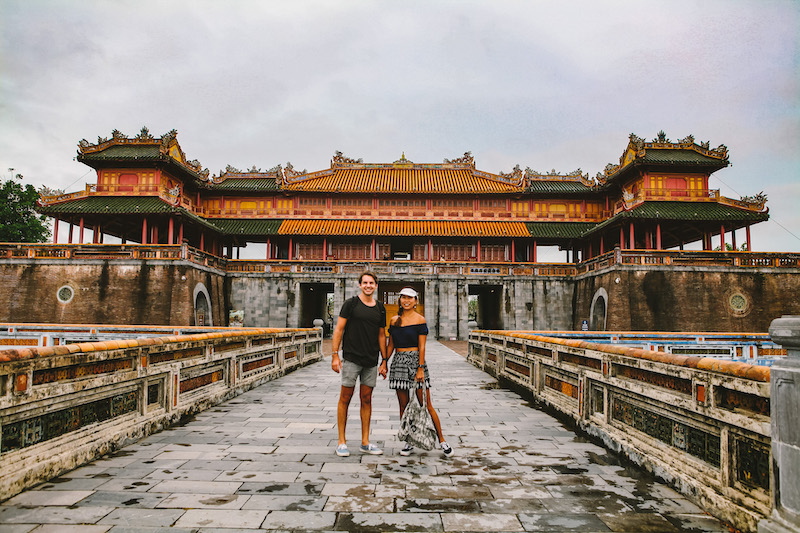
The Ngo Mon Gate is a massive structure that also served as a royal viewing platform for court ceremonies. The gate has some interesting architectural elements, each playing an important role in court ceremonies.
The gate can also be called Meridian Gate or Moon Gate.
Here are the main elements:
- The Doors: two of the five entrances that pass through the thick stone ramparts serve as entry and exit points for tourists. The largest door in the middle is barred (it was reserved for the use of the emperor). The two entrances flanking the Emperor’s Gate were reserved for mandarins and court officials, while the outermost entrances were reserved for soldiers and war material.
- The Observation Deck : The “Belvedere of the Five Phoenixes”, the Emperor’s private observation deck at the top of the gate, hosted the Emperor and his retinue during important court ceremonies . No women were allowed at this level; from this point of view, the emperor and his mandarins observed the military exercises.
- Flag Tower : In front of Ngo Mon Gate, on the other side of Ngo Mon Square, you can see the Vietnamese national flag waving from the flag tower. The three terraces that make up the platform of the Flag Tower were built in 1807.
The Ngo Mon Gate was by far the big highlight of the Imperial City in Hue. The building is absolutely stunning.
After passing this Gate, you are inside the Citadel. Here there are many buildings to visit and a huge park.
2. THE PALACE OF THE SUPREME HARMONY
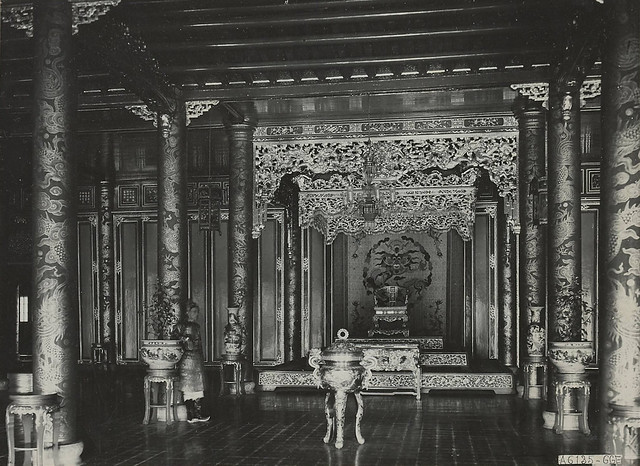
Directly in line with the Ngo Mon Gate along the central axis of The Imperial City in Hue, the Throne Palace can be reached after walking 100 meters over a bridge known as the Trung Dao (Central Path) which crosses a pond known as Thai Dich.
Immediately after crossing the bridge, you will enter the Court of Great Rites, where mandarins used to gather to pay homage to the emperor. The lower half, farther from the throne palace, was reserved for village elders and lower-ranking ministers. The upper half of the courtyard was reserved for high-ranking mandarins.
The Throne Palace (which was unfortunately under renovation during our visit (September 2022), also known as the Palace of Supreme Harmony, was the nerve center of the Emperor’s court during its heyday. Built in 1805 by Emperor Gia Long, the Throne Palace was first used in 1806 for the Emperor’s coronation. Over the years, the throne palace has become the privileged setting for the most important ceremonies of the Empire, such as the coronation of emperors and crown princes, and the reception of foreign ambassadors.
The throne palace was built to host large ceremonies: the building is 44 meters long, 30 meters wide and almost 12 meters high, supported by red lacquered columns intertwined with golden dragons. On the throne hangs a carved board bearing the words “Palace of Supreme Harmony”.
3. THE MANDARIN BUILDINGS
Immediately behind the Throne Palace, visitors can pass a giant replica of the Emperor’s Great Seal and enter the plaza flanked by two Mandarin buildings. These buildings were annexed to the throne palace; they served as administrative offices for the cream of the Imperial civil service and as staging areas for important meetings with the Emperor.
National exams (inspired by those in China) were also held here for students wishing to enter the imperial civil service. The emperor took a personal interest in the examinations and himself assigned positions to those who passed the imperial examinations, in a grand ceremony in front of the Ngo Mon gate.
Today, the buildings house souvenir shops; the Mandarin building on the right houses a museum of imperial trinkets.
4. ROYAL READING ROOM

The Royal Forbidden City stood on the grassy field just past the Mandarin Buildings; the Emperor’s private quarters stood here before American bombs destroyed them in the 1960s. The Royal Reading Room (Thai Binh Lau) is the only building to survive the ravages of the 20th century. French reoccupation failed to destroy it; American bombs failed to bring it down.
Thai Binh Lau was built by Emperor Thieu Tri between 1841 and 1847. Emperor Khai Dinh then restored the temple in 1921, and civil authorities continued restoration efforts in the early 1990s. In the old At the time, emperors would retreat to Thai Binh Lau to read books and write letters.
5. THE QUEEN RESIDENCE: DIEN THO
From the grassy field that was once the emperors’ private quarters, turn southwest and you’ll find a long covered hallway, that leads to a complex housing the Queen Mother’s residence: the Dien Tho Residence.
Dien Tho Residence has several important buildings within its walls: Dien Tho Palace, Phuoc Tho Temple and Tinh Minh Building.
Dien Tho Palace: Built in 1804 as the home and audience hall of the Queen Mother, the importance of the building grew in proportion to the growing influence of the Queen Mother in Vietnamese affairs.
The palace was partially damaged during the wars of the 20th century but underwent extensive renovation between 1998 and 2001. The current appearance of the palace approximates its condition during the reign of the last Emperor Bao Dai. The front apartment looks like it did when Queen Mother Tu Cuong lived there in the 1st half of the 20th century, a sumptuous living space finished in dark lacquer and gold. Most of the other items were possessions of the Queen Mother’s household.
Phuoc Tho Temple : Located behind the Dien Tho residence, this temple served as a Buddhist temple and the Queen Mother’s personal shrine. Here, the Queen Mother celebrated religious anniversaries and performed rituals on auspicious days of the lunar month. The upper floor is called the Khuong Ninh Pavilion.
Tinh Minh Building : Standing on the side of Dien Tho Residence, this fairly modern looking building stands on the site of a wooden building named Thong Minh Duong.
6. TO MIEU TEMPLE
The large ornate gate in front of the Dien Tho building takes you out of the complex; turn right and follow the road for about 70 meters, then turn right at the corner and walk about 100 meters until you come to another beautifully decorated gate on your left (Chuong Duc) which serves as the entrance into the Mieu and Hung Mieu complex.
Two temples still stand within the walls of the enclosure: the To Mieu, where the Nguyen emperors are honored, and Hung To Mieu, built to consecrate the memory of the parents of Emperor Gia Long. On the death anniversaries of emperors, the reigning emperor and his retinue would perform the appropriate To Mieu ceremonies. The lacquered altars in the main gallery each honor one of the Nguyen emperors.
Originally there were only 7 altars: the French lords prevented the Nguyen emperors from installing altars to honor the anti-French emperors Ham Nghi, Thanh Thai and Duy Tan. The three missing altars were included in 1959, after the French left.
8. HIEN LAM PAVILION
In front of the Hien Lam Pavilion are nine urns: dynasty urns honoring emperors who have completed their reigns. The nine dynastic urns were cast in the 1830s. As they represent the reigns of successive Nguyen emperors, the urns were designed with massive proportions: each urn weighs between 1.8 and 2.9 tons, and the smallest urn is 1.90 meters high. Traditional designs representing the reign of each emperor were chiseled on each urn.
The Hien Lam Pavilion, also known as the Pavilion of Glory to Come, commemorates the lives and achievements of important commoners who helped the Nguyens rule their empire. The gate that leads outside the temple compound is right in front of the Hien Lam Pavilion. Turn left, walk about 200 meters and you will arrive where you started, at Ngo Mon gate.
OTHER THINGS TO SEE IN HUE
Hue was one of the main highlights of our trip to Vietnam , thanks to its historical and cultural values. We learned a lot from our guide about the history of Vietnam and the Kings. It was fascinating.
There are many things to see in Hue, which we listed in this post .
Some of the highlights are:
- THIEN MU PAGODA
- TAKING A CRUISE ON THE PERFUME RIVER
- MAUSOLEUM OF EMPEROR KHAI DINH
- THE TOMB OF TU DUC
- THAN TOAN JAPANESE BRIDGE
BEST HOTELS IN HUE?
There are many amazing places to stay in Hue , some are big resorts by the river, some are charming homestays and you can even find beautiful villas all to yourself!
Here is a selection of a few of our favorite hotels in Hue.
Pilgrimage Village Boutique Resort & Spa – $$$$

This is probably the most amazing place in Hue! If the nightly rate fits your budget, then without a doubt this is for you! The hotel is just breathtaking at every aspect. This luxury resort, just a few minutes from the main attractions in Hue, has a beautiful pool, serves amazing breakfast, the rooms are spacious and comfortable and the entire service top notch!
If you are looking for the best hotel in Hue, this one would be hard to beat!
Saigon Morin Hotel – $$$$
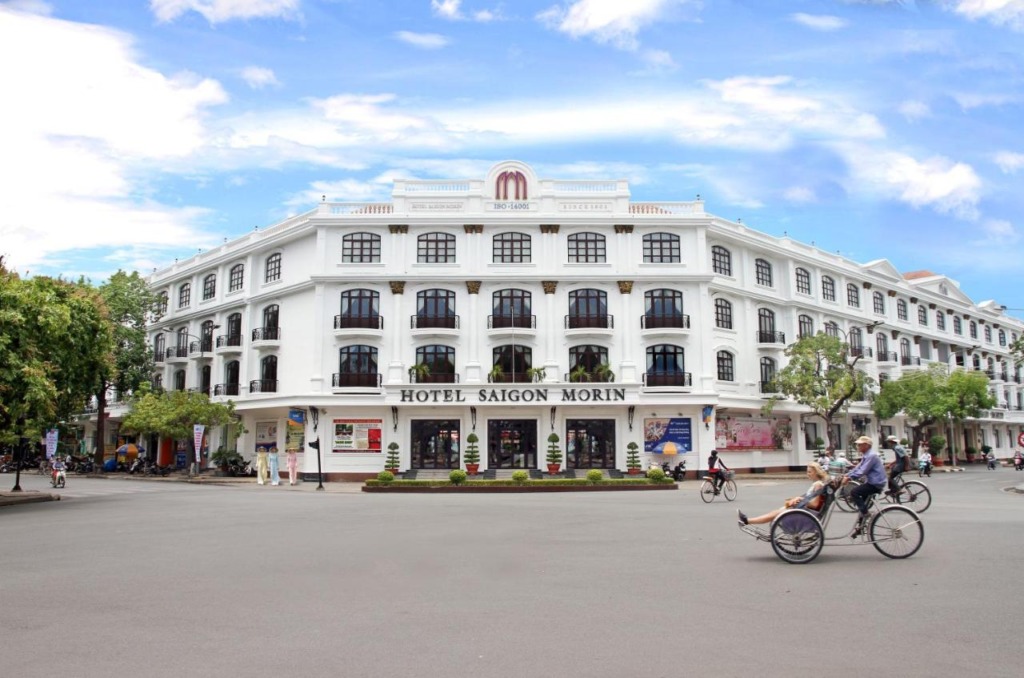
Saigon Morin Hotel is another beautiful hotel located in the center of Hue near the Imperial Citadel, which makes it a very convenient place to visit Hue.
This Hotel is a fantastic piece of history, as the building is a historical place featuring French colonial architectural style. We love this place too and would recommend it to anyone coming to visit Hue.
Hue River Side Villa – $$$

Why not stay in your own villa during your visit to Hue? The villas are located by the Perfume River, featuring a magnificent view from the garden! The location is perfect; you are in the center of Hue but still out of the hustle and noise of the city.
Le Robinet Homestay – $$
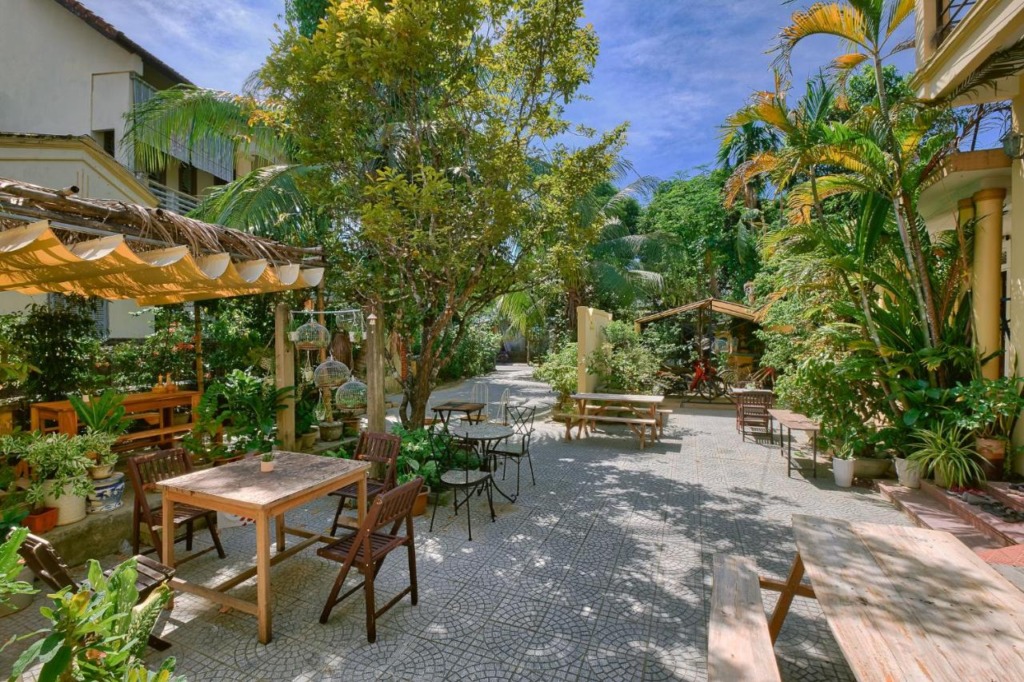
If you are more on a budget during your trip to Vietnam , then we recommend the charming Le Robinet Homestay. This is one of the best value for money. The place is super clean and the staff is super friendly! This place has a lot of character, reflecting how wonderfully unspoiled Hue is, and its wonderful slow pace.
Related Posts
- 13 INCREDIBLE THINGS TO SEE IN HUE, VIETNAM
- 16 BEST THINGS TO SEE IN DA NANG, VIETNAM
- 25 AWESOME THINGS TO SEE IN HANOI, VIETNAM
- ULTIMATE GUIDE TO VISIT THE MARBLE MOUNTAINS IN DA NANG, VIETNAM
- 16 AWESOME THINGS TO SEE IN HOI AN, VIETNAM
- 25 BEST THINGS TO SEE IN HO CHI MINH CITY, VIETNAM
We are Hammer and Guillaume, a fun couple traveling the world. We will take you to some of the most amazing places on earth. Hammer is a yoga instructor and Guillaume a true water baby, enjoying all kinds of water sports. Follow-us to get the latest update about our travels.
Similar Posts

10 BEST PARKS IN SEOUL – YOUR FULL GUIDE
Enjoy some of the beautiful parks in Seoul. Here is your full guide fo visiting Seoul’s best park (Seoul Forest, Hangan Parks, Yeouido etc.)
![hue imperial city trip DISCOVER BANGSAR IN KUALA LUMPUR [MALAYSIA]](https://afuncouple.com/wp-content/uploads/2023/08/Discover-Bangsar-in-Kuala-Lumpur-1-768x512.webp)
DISCOVER BANGSAR IN KUALA LUMPUR [MALAYSIA]
Known for its amazing culinary scene and lively nightlife, Bangsar has emerged as one of the most sought-after areas in Kuala Lumpur.
![hue imperial city trip 35 AWESOME THINGS TO DO IN JEJU [KOREA GUIDE]](https://afuncouple.com/wp-content/uploads/2020/10/Jeju-71-768x512.jpg)
35 AWESOME THINGS TO DO IN JEJU [KOREA GUIDE]
Jeju Island, often nicknamed the Hawaii of Asia, is a beautiful island situated in South Korea. Expect volcanos, beautiful beaches, great hikes etc.
![hue imperial city trip 15 AWESOME THINGS TO DO IN LANGKAWI [MALAYSIA]](https://afuncouple.com/wp-content/uploads/2023/05/Best-things-to-do-in-Langkawi-4-768x512.webp)
15 AWESOME THINGS TO DO IN LANGKAWI [MALAYSIA]
Langkawi is one of the best islands in Malaysia. Enjoy a mangrove tour, sunset tour, the skybridge, explore the jungle and so much more!
![hue imperial city trip 15 INCREDIBLE THINGS TO SEE IN GALLE [SRI LANKA]](https://afuncouple.com/wp-content/uploads/2022/08/Best-things-to-see-the-south-of-Sri-Lanka-49-768x512.jpg)
15 INCREDIBLE THINGS TO SEE IN GALLE [SRI LANKA]
Galle is a magnificent fortified city with strong colonial heritage which you must absolutely visit during your trip to Sri Lanka!
![hue imperial city trip 20 AMAZING SURF SPOTS IN ASIA [ULTIMATE GUIDE]](https://afuncouple.com/wp-content/uploads/2023/10/Best-surf-spots-in-Asia_Cover-768x512.webp)
20 AMAZING SURF SPOTS IN ASIA [ULTIMATE GUIDE]
WHERE TO SURF IN ASIA? WHERE ARE THE BIGGEST WAVES? Asia, with its diverse landscapes and breathtaking coastlines, offers…
Leave a Reply Cancel reply
Your email address will not be published. Required fields are marked *
You should caution that cars are not permitted to enter the Citadel. The walk from the closest drop-off point would have tired me out before I got to the first attraction within the wall. I could have walked between the buildings, but this was too much, and I missed everything. Pity.
Hi Dave, thanks for your remark. Indeed the entire citadel must be visited on foot… Sorry to hear about your unpleasant experience at the citadel in Hue…

Hue Imperial City and Forbidden City
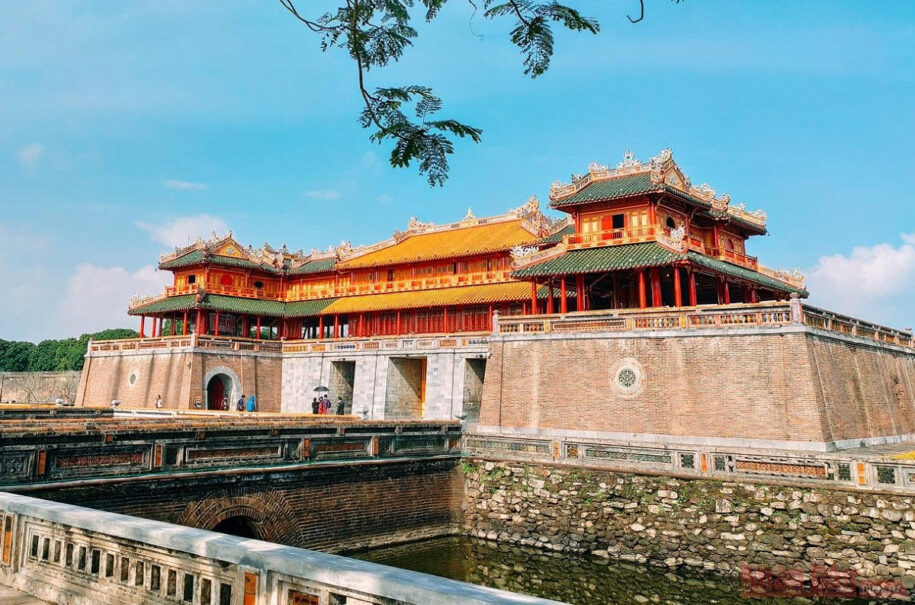
Located by the Perfume River, Hue Imperial City and Forbidden City are the 2 nd and 3 rd walls of the Citadel, seat of Vietnamese power from 1802 to 1945. These are home of luxury-decorated palaces, residences, theatre and pavilions, for Nguyen emperor and his family. The king also added lovely landscaped gardens to relax and grand temples to worship his father and ancestors. Due to recent wars and fire, visitors only see a small part of it, instead of over 150 buildings like in the past. Now, international and local associations have been funding for restorations and reconstruction. In 1993, it became a Unesco world heritage site, as a part of the Complex of Hue Monuments.
The Imperial City of Hue is a must-see. In the busiest year, 4,3 million visitors purchased its entry and now, there are over 10,000 TripAdvisor users and 26,600 Google accounts left their reviews about it. City tours can exclude it in the itinerary. This article outlines what travelers need to know before visiting it.
- Hue Royal Tombs
- T hien Mu Pagoda
- Perfume River Cruise
- Hue Day Trip from Da Nang or Hoi An

Table of content
- 1.1 The Imperial City (Hoang Thanh)
- 1.2 The Forbidden Purple City (Tu Cam Thanh)
- 2.1 Location Selection
- 2.2 Construction and Destruction
- 2.3 Restoration and Reconstruction
- 3.1 Hue Imperial City Ticket and Price
- 3.2 Hue Imperial City Combo Ticket and Price
- 3.3 Ticket Counters
- 3.4 Audio and Tour Guides
- 4.1 Hue Imperial City Opening Hours
- 4.2 Dress Code
- 4.3 Best Time to Visit Hue Imperial City
- 4.4 How Much Time Do I Need to Visit?
- 5.1 Buildings in the Front of Imperial City
- 5.2 Ngo Mon Gate (Meridian Gate Hue)
- 5.3.1 The King Throne
- 5.4 Hue Forbidden Purple City
- 5.5.1 The Nine Dynastic Urns
- 5.6 Dien Tho Palace
- 5.7 Duyet Thi Duong (The Royal Theatre)
- 5.8 The Pavillions and Gardens
- 5.9 Hue Museum of Royal Antiquities
- 6 Visit Route Recommended by Local Guides
- 7.1 Hue Court Music – Nha Nhac
- 7.2 Photo Portrait in Royal Costumes
- 7.3 Hue Traditional Handicraft Making Class
- 8.1 Where is Hue Imperial City?
- 8.2 From Center of Hue
- 8.3 From Hue Airport to Hue Imperial City
- 8.4 From Da Nang to Hue Imperial City
- 8.5 Parking Lots and Fee
- 9.1 Walking
- 9.2 Shuttle Bus
- 10.1 Restaurants
- 10.2 Coffee and Beverages
- 10.3 Souvenir Shops
- 11.1 Hue Day Trip from Da Nang
- 12 Hue Imperial City on Google Maps
- 13 Related Posts
- 14 Thieu Tri Tomb: The Peaceful Royal Tomb of Hue
- 15 Bach Ma National Park: Hiking, Trekking in Da Nang and Hoi An
- 16 Hue to Da Nang By Train: The Best Train Ride in Vietnam
- 17 Hue Royal Tombs: A Complete Guide and What is Best?
- 18 The Hue Abandoned Water Park (Thuy Tien Lake Waterpark)
- 19 Minh Mang Tomb Complete Visitor Guide
- 20 Tu Duc Tomb Complete Visitor Guide
- 21 Hoi An or Hue: Which is Better?
- 22 Lang Co Vietnam Travel Guide
- 23 Thien Mu Pagoda: Guide to Hue’s Most Famous Buddhist Temple
- 24 Perfume River Cruise: Guide to Best Boat Tour in Hue Vietnam
- 25 Tomb of Khai Dinh: The Most Unique Royal Tomb of Hue
- 26 Hai Van Pass Da Nang: Map, Route, Weather, History, Tour
- 27 Hue Imperial City and Forbidden City
- 28.0.1 Golden Bridge and Ba Na Hills Night Tour
- 28.0.2 Golden Hands Bridge Tour In Sunrise or Sunset (1/2 Day)
- 28.0.3 Cam Kim Island Bicycle Tour From Hoi An
- 28.0.4 Cham Island Tour From Hoi An (Group Tour)
- 28.0.5 Cham Island Tour From Da Nang (Group Tour)
- 28.0.6 Hoi An Vegetarian Food Tour
- 28.0.7 Hoi An Evening Walking Food Tour Through Laneways
- 28.0.8 Private Hoi An Basket Boat Tour (Shuttle Bus, Bicycle, Bike)
- 28.0.9 Half-day Am Phu Cave Tour (Private)
- 28.0.10 Hoi An Countryside Tour (Bicycle, Car, Electric Shuttle)
- 28.0.11 Da Nang Tour Package From Singapore
- 28.0.12 Hoi An Evening Tour From Da Nang
- 28.0.13 Hoi An Walking Food Tour Through Laneways
- 28.0.14 My Son Sanctuary and Hoi An Old Town Tour with Thu Bon River Cruise
- 28.0.15 My Son Day Trip From Hoi An including Marble Mountains and Basket Boat
- 28.0.16 Half Day Hoi An City Tour With River Cruise
- 28.0.17 Son Tra Peninsula Tour with Marble Mountains (Private/Small Group)
- 28.0.18 Hue Day Trip From Hoi An with Hai Van Pass, River Cruise & Lunch
- 28.0.19 Hoi An Ancient Town and Countryside Tour (Bests of Hoi An Tour)
- 28.0.20 Hoi An Tour From Da Nang Airport (Private, Optional Lunch)
- 28.0.21 Hoi An Day Trip From Da Nang (Marble Mountains, Basket Boat, Old Town)
- 28.0.22 Da Nang City Tour From Airport (Private, Optional Lunch)
- 28.0.23 Hoi An City Tour with Lantern Class, Lantern Boat, Night Market & Local Food Sampling
- 28.0.24 Marble Mountains, Basket Boat Ride & Hoi An Old Town Walking Tour
- 28.0.25 Marble Mountains & Golden Bridge Day Tour with Buffet Lunch
- 28.0.26 Marble Mountains & Monkey Mountain Tour (Half-day, Private)
- 28.0.27 Private Golden Bridge Sunrise Tour (Half-day, Optional Lunch)
- 28.0.28 Hoi An Ancient Town & Golden Bridge Day Tour (Private/Small Group)
- 28.0.29 My Son Sanctuary & Golden Bridge Day Tour (Private/Small Group)
- 28.0.30 Private My Son Sanctuary Sunrise or Sunset Tour
- 28.0.31 Full Day Hoi An Ancient Town & Countryside Experience With Local
- 28.0.32 Full Day My Son Sanctuary & Hoi An Countryside Tour With Local
- 28.0.33 Full Day Hoi An Ancient Town & Coconut Village Experience
- 28.0.34 Son Tra Peninsula, Marble Mountains and Hoi An City Tour
- 28.0.35 Half-day Marble Mountains Tour from Da Nang or Hoi An
- 28.0.36 Da Nang Cave Tour (Half Day Underground Tour in Da Nang)
- 28.0.37 Hoi An Old Town & Lantern Making Class (Morning Tour, Half-day)
- 28.0.38 Full Day Bests of Da Nang & Hoi An Old Town Walking Tour
- 28.0.39 Full Day My Son Tour From Da Nang with Da Nang City Tour
- 28.0.40 My Son Sanctuary Tour From Hoi An or Da Nang With Local Guide
- 28.0.41 Hue Day Trip from Da Nang or Hoi An via Hai Van Pass with Lunch
- 28.0.42 Full Day Golden Bridge & Ba Na Hills Tour With Buffet Lunch
- 28.0.43 Full Day My Son Sanctuary Tour & Hoi An Old Town With Local
- 28.0.44 Half Day Da Nang Museums and Bridges
- 28.0.45 Da Nang City Discovery
- 28.0.46 Da Nang at a Glance (The Best Half Day Da Nang City Tour)
- 28.0.47 Full-day My Son Tour From Da Nang or Hoi An & Marble Mountains
What are Imperial City and Forbidden Purple City?
The imperial city (hoang thanh).
The Imperial City (Hoang Thanh, Hoang Cung or Dai Noi) is a squared enclosure protected by a 4-meters-tall brick wall and ringed by a moat. It opens to the outside by 4 gates, the largest in the south and there are three fortifications on the other sides. Within its 36-hectares-wide ground, the king builds palaces to meet up with mandarins, residences to reside, temples for worshipping, constructions for entertainment and more. Historians say that the number of constructions might be up to 150. As a rule, yellow tiled roof ones are exclusive for the emperors and green tiled roof ones for other people. Inspired by Beijing Forbidden Purple City, this later complex features more green spaces with lush vegetation and ponds. It faces south which direction is thought to be exclusive for the emperors.
The Forbidden Purple City (Tu Cam Thanh)
Forbidden Purple City is the final and innermost enclosed area of Hue Citadel. Featuring a rectangular ground protected by walls and without moat, it has 10 gates to allow regulated entry. The main (largest) gate is to the south, just behind Thai Hoa palace but now can’t be seen anymore. Its main role is to support the life of the emperor and his family, from meeting with mandarins, living, eating, curing, entertainments, relaxation to sports. In feudal times, besides royal members, only guardians, eunuchs and imperial servants had been around. Highly damaged by fire and bombings, much of its buildings are destroyed and restoration of some buildings is on-going.

Hue Imperial City History
Location selection.
Overally, the Imperial City of Hue faces south, the direction for the kings in ancient books. In its front, Ngu Binh mountain shelters it from bad spirits. To the right and the leff, there are two river islets looking at each other, preventing evils from two sides. To know further information, read our article via centralvietnamguide.com/hue-citadel.
Construction and Destruction
Construction of Hue Imperial City and Forbidden Purple City started from summer in 1804, in the reign of Nguyen Dynasty’s founder Gia Long. He builds a 4-meters-tall wall with 4 gates, enclosing a ground of 36 hectares. Within it, there is a palace for his coronation, a temple for worship of his parents and his family ancestors, and residences to reside. In 1833, his son Minh Mang replans the area, based on the inspiration from Forbidden Purple City in Beijing. The south entrance Ngo Mon is enlarged, the location of the Crown palace and temples is moved and many new constructions were added. After this replanning, the Imperial City becomes a very grand ensemble that is unprecedented in history.
In 1947, the architectures in Hue’s Imperial City were burned, according to scorched-earth policy of the League for Independence of Vietnam (shortly Vietminh). Nearly all of the buildings in the Forbidden City were destroyed, including four palaces. In 1968 and 1975, major battles between American-led and communist-led armies in the Vietnam war, occured in Hue citadel. As a result, many structures were fallen down or ruined by bombs and there are buttle holes in the walls.
Restoration and Reconstruction
After Unesco recognition in 1993, restoration and reconstruction works have been started. There are many funds and action plans established, aiming to regain the integrity and glory of the buildings in the Imperial City. Thanks to history books and photos taken by French, information about some large buildings makes sense. Now, some palaces in the Forbidden Purple City have been reconstructed and open their doors soon to tourists.
Hue Imperial City Entrance Fee and Tickets
Hue imperial city ticket and price.
Hue Imperial City entrance fee is 200,000 VND for adults and visitors above 12 years old, 40,000 VND for teenagers from 7 to 12 years old, and free of charge for smaller ages. This price includes entry to all places to see within the walls of Imperial City and the Museum of Royal Antiquities near its exit. Vietnamese and foreigners pay the same and on some commemoration days, the entrance fee is free to locals, such as Vietnam’s Independence Day.
Note: It’s not necessary to reserve a Hue Imperial City ticket in advance, even during high tourist seasons. Just come to the counters to purchase.
Hue Imperial City Combo Ticket and Price
If planning to see the Imperial City and some other places in the Unesco list, visitors can buy ticket combos, to save a bit. At the present, there are three choices: Three Sites, Four Sites and All Sites. The first charges 420,000 VND and 80,000 VND for adults and teenagers from 7 to 12 years old. It covers the admission to the Imperial City, Minh Mang and Tu Duc Tombs. With additional Khai Dinh tomb, the price is 530,000 VND and 100,000 VND, for adults and teenagers from 7 to 12 years old. The last ticket combo is 580,000 VND and 110,000 VND, encompassing most Unesco-listed places. For ages under 7 years old, it’s free. No matter which combos, the validity is 3 days from the day the visitor purchases. Remember to keep the ticket from being torn or lost.
*Places in the Unesco list:
-Ticketed places: Tombs of Khai Dinh, Minh Mang, Tu Duc, Dong Khanh, Duc Duc and Gia Long emperors, Nam Giao esplanade, An Dinh palace, Hon Chen temple.
-Non-ticked places: Thien Mu Pagoda, Temple of Literature, Royal Arena and Voi Re temple.
Ticket Counters
There are two ticket counters in the front of Ngo Mon Gate, the Imperial City’s entrance. English-speaking cashiers, price boards, tickets and bills if requested, are all available in each counter. Cash is only accepted, and when visitors would like to exchange other currencies, the cashiers may help.
Audio and Tour Guides
Team of tour guides in Hue Imperial City is among the largest in the country, including nearly 60 people. A half speak English fluently and the others are good at French, Chinese, Russian and Japanese. All are well-trained, professional and knowledgeable. Especially the women who always wear a traditional long dress at work, with a conical hat on the head. As a Unesco heritage, visiting with an “expert” guide is necessary if sightseers would like to deepen understanding about the Cities. Remember to book in advance, especially in high seasons, to avoid overbooking. Tipping depends on each person, and qualities from the guide.
On the other hand, it’s possible to book a guide who knows many about different attractions, not just the Imperial City. One day with him/her is perfect, to get insight into Hue’s history and culture. If looking for one, visitors can come to a tour operator near the hotel or ask for recommendations from friends. Text us if you don’t mind, our whatsapp is +84968009827 and email is [email protected].
In addition to tour guides, visitors can choose to travel by themselves with an audio guide. It’s available in 11 languages: English, French, Chinese, Japanese, Spanish, Korean, Thai, German, Russian, Italian and Portuguese, and 5 sights in Hue. In the Imperial City, the duration is from 150 to 180 minutes. For further information, ask the staff in the ticket counters.

Times and Dress Code
Hue imperial city opening hours.
In the summer, Hue Imperial City opens from 6:30 a.m to 5:30 p.m and 7 a.m to 5 p.m the winter. The counters sell the ticket during the times too, so if you would like to go and see in the afternoon, you should come before 3:30 p.m to avoid missing many things. The last tickets are sold around the closing time.
There are no strict regulations for what visitors should and shouldn’t wear in the Imperial City. But in major attractions, dress code is required, such as palaces, temples and pagodas. First of all, it’s needed to cover the armpits, navel and knees, like requirements in the past. This keeps the respect to emperors and ancestors. Secondly, visitors have to remove sunglasses, hats, raincoats and umbrellas. A coat rack is available near the entrance to hang up the coats. While visiting the buildings, taking photos by camera or phone with flashlight is not allowed. The main purpose is to preserve better decorations and valuable objects.
Best Time to Visit Hue Imperial City
Hue city’s climate features two seasons: the dry from March to August, and the wet from September to the end of February. The highest temperatures are in June and July, and the lowest degree is in January. Especially, from October to January, typhoons occur and there are heavy rains, floods followed by. So, the best time to visit Hue Imperial City is January to February, and August to the end of September. During the span, the summer heat has not come yet and the wet season hasn’t started. It’s absolutely possible to expect sunny hours to marvel at ancient architecture, photograph, watch performances and see pretty gardens.
In the dry season, visitors are advised to start their visit in the morning or after 3 p.m, to avoid the hotness and tourist crowds in the midday. The first tickets are sold at 6:30 a.m. In the rest of the year, checking the weather forecast in advance is the top tip. On typhoons or floody days, the City may be closed to ensure visitor’s safety. Before leaving the hotel, remember to bring raincoats or umbrellas and waterproof shoes.
How Much Time Do I Need to Visit?
Sightseers should spend at least 2 hours in the Hue Imperial City. This minimal time is enough to visit highlights, walk around and take a break. If aiming to see everything or being a history lover, it’s longer. Many travelers plan a half-day, to have a fully-enjoyable trip to learn about the Vietnamese royal court from 200 years ago. However, visitors on shuttle buses or in group tours often have a shorter time budget.
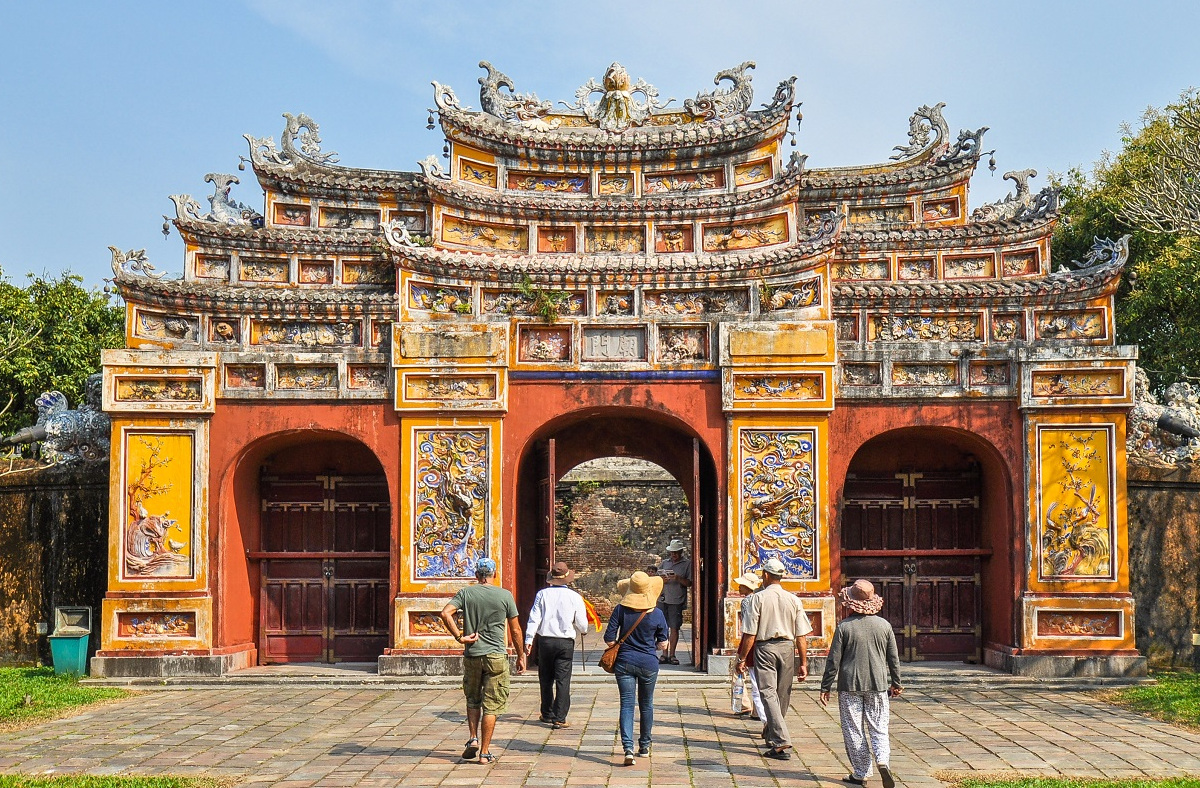
Places to Visit in Hue Imperial City
Buildings in the front of imperial city.
Before purchasing a ticket and visiting the Imperial City, visitors can see several buildings between it and the Perfume River. From the shore, there are Nghinh Luong Dinh Pavillion, Phu Van Lau (Pavillion of Edicts), Cua Ngan and Cua Quang Duc Gates in the Citadel, The Nine Holy Cannons, the Flag Tower and Ngo Mon Square. Read our ultimate guide to Hue’s Citadel for further details, via centralvietnamguide.com/hue-citadel.
Ngo Mon Gate (Meridian Gate Hue)
This main entrance (South gate) of the Imperial City was built by the dynasty founder Gia Long in 1804, under the name “Nam Khuyet Dai”. But current grand architecture is dated back from 1833 when his son replanned the City. Because of facing south, its name is Ngo Mon. There are five passageways, the middle is exclusive for the emperors and now still closed. The left one is for literature mandarins, today allowing access for international visitors and the right is for military mandarins where domestic tourists enter the City. Two other passageways are used for imperial guards, elephants and horses. In some walls, bullet holes left from wars are still visible.
The upper section of Ngo Mon Gate is called “Five-phoenixes Pavillion ”. Its roof is covered by tiles in two colors: yellow for king zones and green for mandarins and guards. Under the roof, the emperor sits to witness important events or commemorations of the country. That may be publishing a new calendar, or list of national winners in royal examinations. In 1945, the last king ever Bao Dai made his abdication there. His wife Nam Phuong queen also was the first woman standing in the pavilion.
Fact: Ngo Mon Gate is the emblem of Hue city.
Thai Hoa Palace
This first royal palace was built from February to October in 1805 by the founder Gia Long, to hold his coronation and meetings with the mandarins twice a month. In each meeting, literature and military mandarins stand in the courtyard outside, to the right and left respectively. Position of the mandarin is regulated by three different terraces and two rows of stone steles on either side. Supported by 80 red-lacquered ironwood columns, this building includes back-to-back houses. The throne is placed in the middle of the front house and looks outside. Since it’s crafted and plated by gold, it never moved anywhere. Moreover, the palace served for king’s birthdays, receptions to welcome foreign ambassadors or an office in the 1970s and 1980s.
Around the roof frame above the head, the decoration follows a rule, one picture one poem (a part of a poem). The words were composed mainly by the emperors, to praise the peace, prosperity and unity of the country. Thanks to being unique (especially to Chinese palaces) and rich content, Unesco added these literature works in the world documentary heritage list. In the back house, visitors can sit and watch a digital restoration of Hue imperial city. An overall miniature of the entire enclose is seen nearby, next to maps showing maximum extensions of Vietnamese territory in 20 th century.
Note: Thai Hoa is the only standing palace after the French and American wars today.
The King Throne
In the center of Thai Hoa Palace “the Supreme Harmony Palace”, this is a national treasure titled by the Prime minister. The first king sits on it is the founder Gia Long, the longest is Tu Duc (36 years) but the shortest is his successor, only 3 days. Due to being highly-symbolized, people never moved it to anywhere, even during the wars. Film crews claps hands to pray, and ask for acceptance before starting acting with. Today, it’s only one of the kind.
Hue Forbidden Purple City
Walking across the yard behind Thai Hoa Palace, visitors will see the first buildings of the Forbidden Purple City, the innermost enclosure. Huu Vu (right) was for military mandarins and Ta Vu (left) served literature mandarins during meetings with the emperor. There are four times that the meeting was held, on the 5 th , 15 th , 20 th and 25 th days in each lunar month. Now, both halls are converted into an exhibition of Hue’s world heritages, souvenir shelves, and place a fake throne for photos. In the outside, large copper cauldrons were casted in 17 th century, by Nguyen lords. As a whole, symbolizing the power and permanence of the dynasty.
On the higher terrace, that is the foundation of Can Chanh Palace “the Palace of Audience ”, and four more palaces in a row behind it. Now just one (the last) has been restored thanks to reliable documents. Being newly-reconstructed, reddish corridors are instagrammable spots, with old photos taken by French. To the left of on-going restoration, there is a tennis court, allowing the final king Bao Dai to have fun with the ball.
The To Mieu Temple
In the southwest corner of the Imperial City, the dynasty founder established a temple for worship of his parents, on the current location. Later in 1821, his son Minh Mang king moved it to the north and built another temple but larger. The new addition is named The To Mieu (temple) and dedicated to honouring death kings. Before 1957, this ornate edifice was filled by altars of only 7 emperors but now, 10. Three emperors were not worshipped here, because they were dethroned or passed away after his abdication. The founder Gia Long’s altar is placed in the middle and the door in the front is always closed. If the successor is lost, that man will be to the left, and the next is to the right. On the outside, each one of the Nine Dynastic Urns corresponds to its owner and his name.
The Nine Dynastic Urns
Casted by Hue artisans under the request of Minh Mang king (2 nd king), this collection comprises 9 bronze urns, symbolizing the longevity and power of the Nguyen dynasty. Weight of these works is 2 tonnes on average, and the height is 2,4 meters. On the surface of each, there are 14 depictions of mountains, rivers, islands, specialties, weather, weapons, famous buildings and more, that represent different regions of the country. Historians say the collection is an atlas where people would see icons and hear stories behind.
Dien Tho Palace
To the northwest of the Imperial City, this residence is for the mother and grandmother of the kings. The main hall was earliest built, in 1804 and has a same name to its wider cluster. Behind it, there is another yellow tiled roof hall, supporting the lives of other wifes of the king’s father. Due to high humidity, the last king Bao Dai constructed a house close by with a French architectural style, for his mother. In the same ground, visitors can see Hue’s largest front screen, expensive furniture and household utensils, Buddhist temple, a souvenir shop and a café by a lotus pond. Read our article for Hue’s royal palaces via centralvietnamguide.com/hue-royal-palaces, for further details.
Duyet Thi Duong (The Royal Theatre)
Within the walls of Forbidden Purple City, this imperial theatre was built in 1826. It served solemn performances for the kings, royal family members, mandarins and foreign ambassadors. Tuong (aka Vietnamese opera) has most appeared on its stage and at many times, replaced by Nha Nhac court music. Things around it are exhibited in the ground floor today, including costumes of the actors, music instruments, masks, flags and more. To watch, the emperor sits on the best location, on the upper floor by close family members and special guests. Seatings for mandarins are arranged in the front of the stage. From 1995 to 2002, this survivor of the kind was renovated, and allowed performances again in March 2003. The show of court music can be booked, see more details below here.
The Pavillions and Gardens
Near the Red Corridors, there are pavilions and gardens which visitors should not miss out. Nhat Thanh Lau is easiest to realize, because of its height. Recently-reconstructed, its function is still in secret. To the north, Thai Binh Lau (the Peace pavilion) was built from 1919 to 1921, and boats of its intricate mosaic. Two pretty gardens Thieu Phuong and Co Ha are within a short distance. These are the most peaceful parts of the enclosed area.
Hue Museum of Royal Antiquities
Standing outside of the walls of Imperial City but this place is included in the ticket. Visitors can have a short walk (to 3 Le Truc St) or a free buggy transfer from the exit gate Hien Nhon. Established in 1923 after converting a palace, it was the first museum in Hue and named as Khai Dinh, the 12nd king. Today, around 10,000 antiquities and documents have been preserved here, and many of which are exhibited. When visiting by barefoot, visitors can expect to see emperor’s seals, elaborate gold objects, expensive mother-in-pearl furnitures, the costume the king used for Nam Giao esplande’s ceremony or instruments to play the court music.

Visit Route Recommended by Local Guides
The entrance of Hue Imperial City is Ngo Mon Gate (the south gate) and its exit is Hien Nhon Gate (the east gate). So, a visit clockwise is highly recommended to visitors. After the ticket check point, should turn left and follow the path by the wall, to see The To Mieu temple first. Seeking the way to get to its back gate, and then turn right, turn left at the first crossroad and keep walking. Gate to Dien Tho palace is to the left. Leaving this gate and turning left, it’s easy to see the entrance of Truong Sanh residence. Then, the next place should be the Forbidden Purple City with red-lacquered corridors, high pavilions, theatre and remains of palaces. Walking southwards to visit two mandarin halls Ta Vu and Huu Vu, and Thai Hoa Palace. Following the way in the back of the palace (to the right).
After standing outside of the walls, going along Doan Thi Diem and Le Truc streets to the Museum of Royal Antiquities that included in the ticket. Free buggy transfer is available, from the exit to the museum. Take it if you want to save time.
Activities in Hue Imperial City
Hue court music – nha nhac.
Nha Nhac means “the elegant music” that has history at least from 15 th century. It’s performed in coronations, anniversaries, official receptions, religious holidays and funerals throughout the dynasty. Now, this imperial music becomes a Unesco intangible cultural heritage and is taught in local academies. To know better about it, visitors can attend a free show at 10 a.m and 3 p.m daily in Duyet Thi Duong Theatre or book a ticket for a private show. The first lasts 40 minutes and the second choice may include a royal dinner.
Note: Visitors have the chance to see the imperial music band performing in Thai Hoa Palace at 8:45 a.m, “Changing the Guards” ceremony in Ngo Mon Gate at 8 a.m, and Ca Hue singing in Thieu Phuong Garden at 8:50 a.m and 3 p.m.
Photo Portrait in Royal Costumes
In the Hall of Mandarins (the left from Thai Hoa Palace), visitors can rent a royal costume and then get some fun photo prints. An adult will pay 115,000 VND to sit on the throne and 195,000 VND if would like to pose with two court ladies. Childrens just pay 80,000 VND and 140,000 VND respectively.
Hue Traditional Handicraft Making Class
Traditional handicraft classes are available in Phu Noi Vu (the Imperial Household Department) near the exit gate. In which, visitors and their little ones have hands-on experience in making conical hats, incense sticks, paper flowers, lanterns, kites, and more. Under the instruction from a local, steps to create these products are authentic to Hue’s own styles. Price is 100,000 VND per person. There are many souvenirs to buy in the shop nearby and a chance to taste good-quality teas.
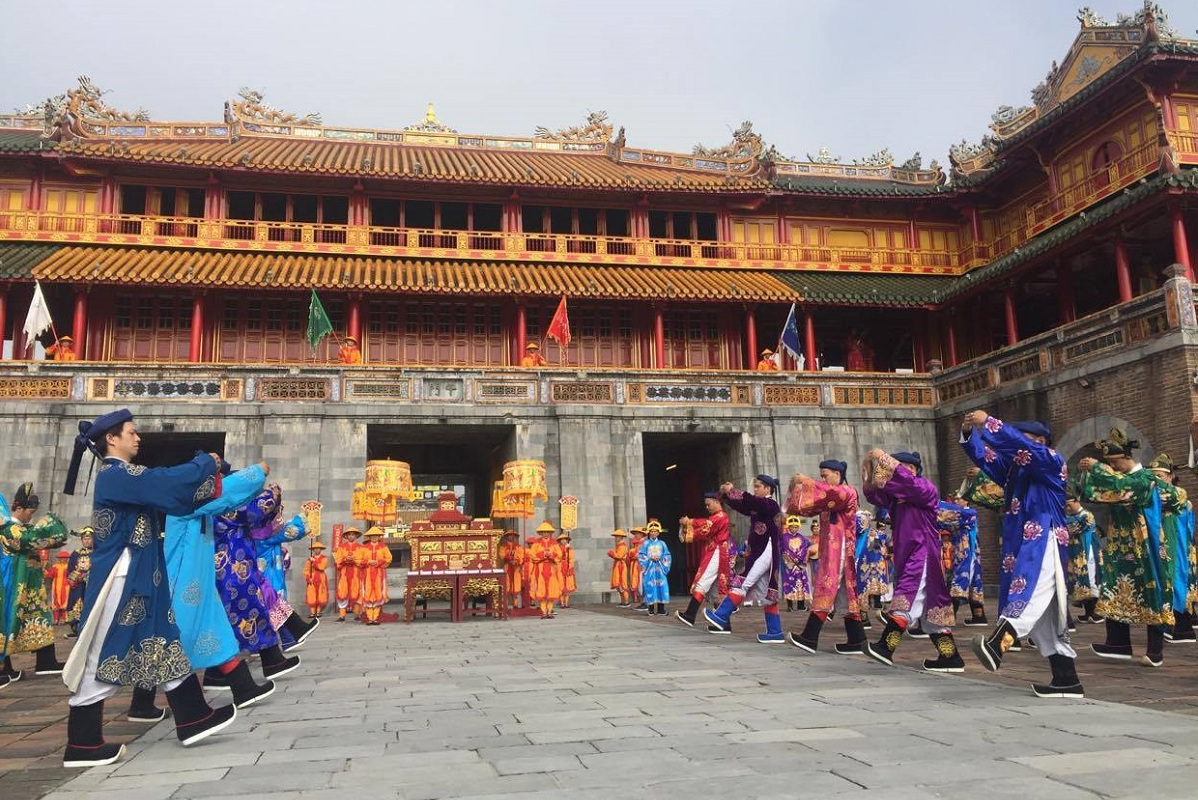
How to Get to Hue Imperial City
Where is hue imperial city.
Hue Imperial City is on the left bank of the Perfume River, or the north bank as locals call it. Thanks to the city centre location, the distance from hotels in the downtown to it is less than 5 kilometers. Further, this famous attraction is 95 km northwest of Da Nang center and 120 km from Hoi An, by the tunnel.
From Center of Hue
Visitors are convenient to get to the Imperial City from anywhere, and by most road vehicles if staying in Hue centre. Walking is popular because Perfume River and its riverside parks and cultural sights are pretty, stunning to see. Definitely, the time between the hotel and the Citadel is really well-spent. Instead of a short and cheap taxi transfer (around 60,000 VND), visitors can ride bicycles or motorcycles. A perfect cycling trip may include Dong Ba market, garden house and Thien Mu Pagoda. Motorcycle is easy to hire, with a price ranging from 100,000 to 200,000 VND (without fuel). Visitors can get to lots of places to see around the city within the day, not just Royal Palaces.
More specifically, cyclo riders (xich lo) provide a laid-back ride around shaded streets, and the chance to see local traffic culture and sights from a different perspective. It’s possible to book in the hotel and tour operator, remembering to make sense of the cost before starting. Thanks to being near the Perfume River, dragon boat ride to get to Imperial City is the next method, off the beaten track. If sleeping somewhere in the Western quarter (Pho Tay), coming to the pier at the end of Doi Cung St. The boat lands in a place 10 minutes walk to the ticket counters.
From Hue Airport to Hue Imperial City
Phu Bai International Airport is 15 km to the south of Hue Imperial City. It takes around 30 mins by taxi, private car or bus. Most conveniently, a four-seat taxi is easy to take, right after the arrival. The fare is not more than 250,000 VND. Luggage storage is not available in the City, so many travelers would like to come to the hotel first (to leave the suitcases or clothings) before purchasing a ticket.
From Da Nang to Hue Imperial City
The Imperial City of Hue is far away from Da Nang city, around 100 kilometers to the northwest. If traveling by car or bus, it takes visitors 2 hours. Because of the long distance, a day trip is popular and the best fit. In town, there is no hard to find one in which roundtrip transfer, entrance tickets, guide and lunch are included. Besides the City, emperor tombs or old Buddhist temples may be other attractions in the itinerary. On the other hand, visitors can hire transportation and local guides by their own way. The guide should be knowledgeable and fluent in English, as Hue is rich in history. For free information, tips and advice, contact us via whatsapp number +84968009827 or email [email protected].
See also: Hue Day Trip from Da Nang
Parking Lots and Fee
Near Hue Imperial City’s ticket counters, parking lots for bikes are many. Locals often leave in places that are close by the Gates of the Citadel and Holy Cannons. The fee is 5,000 VND. On the other hand, it’s possible to look for parking lots around the exit (Hien Nhon Gate), with the same price. If getting a parking lot there, visitors need to walk for a while to the counters, but immediately see the bike after finishing the visit.
Getting around Hue Imperial City
Walking .
If traveling by foot around the Imperial City, visitors will have an interesting visit, with historical buildings and shaded pathways. Local guides recommend sightseeing clockwise, from west, north, south and east in turn. Taking note that the walk there is long, therefore if going with wheelchairs or elders, should consider carefully or book a shuttle bus in advance. In the summer, visitors should bring sun cream, sunglasses, hat, water to drink and wear lightweight, sweat-absorbing clothes. The temperature is usually high at this time. At the end of the year, more layers and waterproof things are necessary.
Shuttle Bus
Visitors can save time or skip the long walks in Hue Imperial City by a shuttle bus. It stops at major sights, available in 30 minutes and 60 minutes now. If booking the first option, the price is 100,000 VND and 180,000 VND per person in 4-seat and 8-seat buggies respectively. About a one hour ride, it’s 150,000 VND and 280,000 VND. Remember to reserve in advance, no matter in low or high seasons, to make sure of your place.
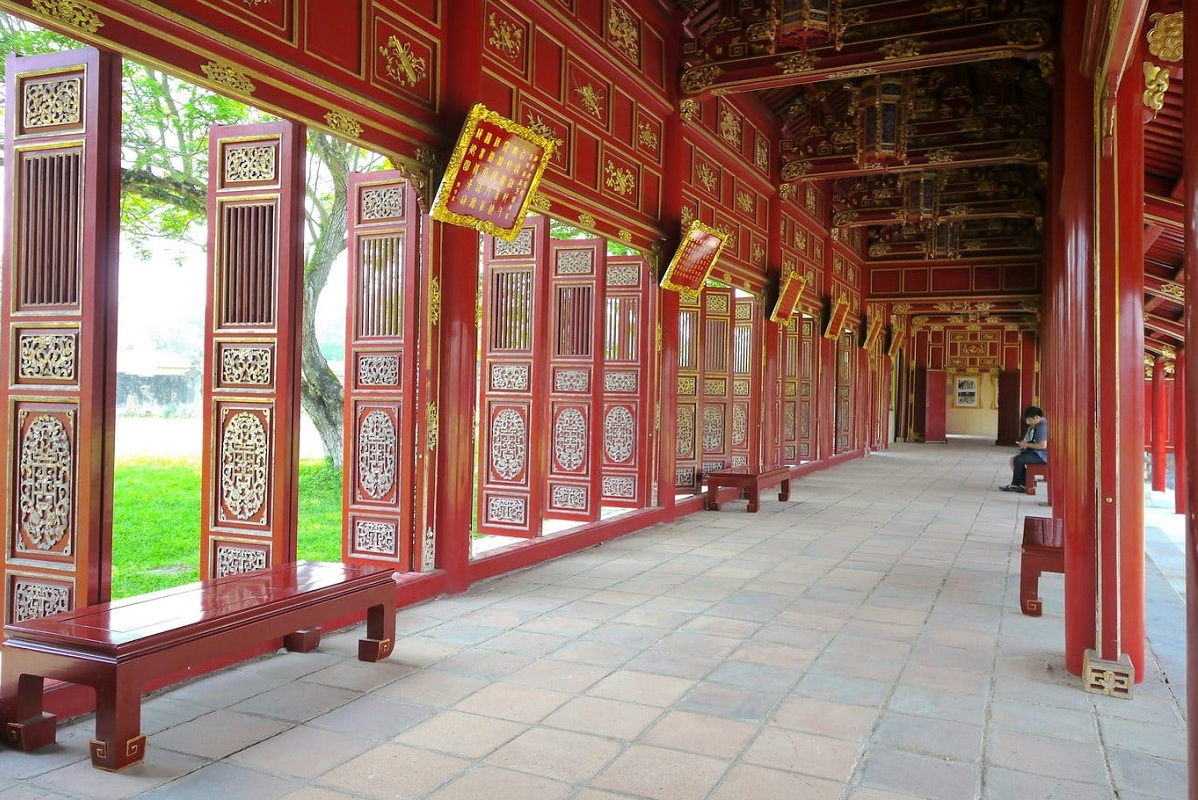
Eat, Drink and Shop
Restaurants.
There is no daily-run restaurant in the Imperial City, and if visitors would like to dine out there, having to book a royal dinner. It’s possible to be accompanied with Hue royal court music (a Unesco intangible heritage), available upon request. This imperial dinner is served in a handful of restaurants around the city.
Outside of the walls, visitors have many choices to choose from, to have lunch or pre-dinner dishes. A few minutes drive away, market stalls provide a variety of local foods and speciality dishes, with a local price. Some amongst them were visited by Anthony Bourdain in his show series. There are many shopping opportunities there also. If you are looking for crispy pancakes or rice noodle soup in Hue’s own style, it doesn’t take much time to find a good place. Foodies love to come to eateries near Thuong Tu gate (of the Citadel) or safari in chessboard streets. Western options are available in some kitchens that are within walking distance from the exit gate. Highlights of each type are listed as following below:
-Market: Dong Ba market.
-Vietnamese and local food restaurants: Lac Thien Restaurant, Banh Khoai Hong Mai (specialize in rice pancakes), Bun Bo Mu Roi (Nguyen Chi Dieu St).
-Western or fusion restaurants: Les Jardin de la Carambole (Dang Tran Con St), Bistro 34 (Dinh Tien Hoang St), Café 51 (Le Huan St).
Coffee and Beverages
Some coffee shops are established in the Imperial City, near Thai Hoa palace. There, visitors can call for a cup of Vietnamese or western coffee. Cakes and other bakeries are for sale but with a limited option. Air-conditioning seating is in most venues, allowing the visitors to cool down and enjoy the brews. If you don’t like coffee, beverage stores and fridges are also many to buy a cold drink. Price starts from 15,000 VND and in the surroundings, visitors can sit stone chairs under the shaded trees.
Souvenir Shops
Souvenir shops are in the Mandarin Hall (behind Thai Hoa Palace), Dien Tho Palace, or near the exit gate. Visitors can find gifts, handicraft objects, paintings, statues, wood works, and more, to buy something to bring home. Many of which are high quality or locally-sourced. Selling price is unclear and touristy. History books translated in English or French are for sale as well, all written by local historians and archaeologists.
Imperial City of Hue Tour
Hue day trip from da nang.
Taking a day trip is the best way to explore the Imperial City of Hue from Da Nang. The tour includes roundtrip transfer from the hotel, entrance tickets, lunch and a local knowledgeable guide. In addition to the walled city, visitors also have the chance to learn about Vietnamese history in 19 th and 20 th century in other places. There are Hue’s oldest Buddhist temple, tombs of the emperors and a dragon boat cruising on the Perfume River. It’s possible to choose to ride up to the top of Hai Van Pass or have a quicker ride to Hue via the tunnel.
Planning to visit Hue’s best attractions in one day? Contact us to know more tips and advice, and recommended tours for free. Our whatsapp number is +84968009827 and email is [email protected]. If you only need an English-speaking, knowledgeable and friendly guide, text us to seek one quicker.

Hue Imperial City on Google Maps
Related posts.
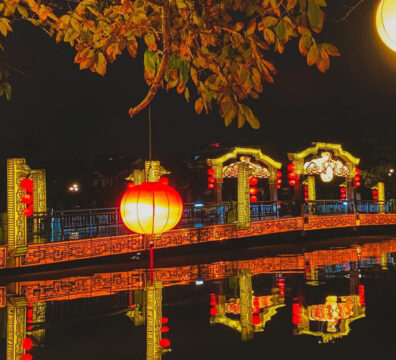
Thieu Tri Tomb: The Peaceful Royal Tomb of Hue
Thieu Tri emperor tomb is an unpopular place to visit in Hue. From the city centre, it’s closer than Khai Dinh tomb, Minh Mang tomb and Gia Long tomb, and

Bach Ma National Park: Hiking, Trekking in Da Nang and Hoi An
Two best places for trekking and hiking in and near Da Nang are Son Tra mountain (peninsula) and Bach Ma national park. Which one is better is actually personal because these

Hue to Da Nang By Train: The Best Train Ride in Vietnam
Like Hanoi to Sapa, many travelers choose to get from Hue to Da Nang by train. Not just a cheap deal, the experience on this ride is definitely stunning and
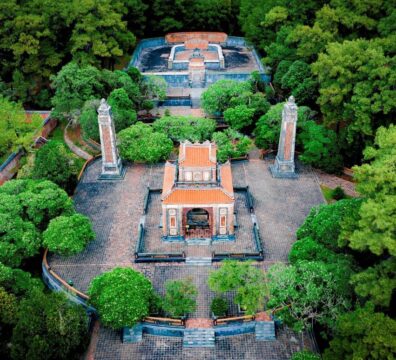
Hue Royal Tombs: A Complete Guide and What is Best?
The Nguyen dynasty existed 143 years, from 1802 to 1945 with 13 emperors, but only 7 of them had their own mausoleum. On the map, all of these buildings are

The Hue Abandoned Water Park (Thuy Tien Lake Waterpark)
Recently, the Abandoned water park in Hue is known by travelers worldwide thanks to social media and online magazines, just like the Golden hands bridge in Da Nang. It was

Minh Mang Tomb Complete Visitor Guide
Minh Mang is the 2nd ruler of the Nguyen dynasty, the king of Vietnam from 1820 to 1840. His contributions to the country can’t be counted, including the largest territory Vietnamese

Tu Duc Tomb Complete Visitor Guide
Tomb of Tu Duc emperor is one of three most visited royal mausoleums in Hue. Two others are Minh Mang tomb – the tomb of Tu Duc king’s grandfather and

Hoi An or Hue: Which is Better?
Both Hoi An and Hue cities are in the middle of Vietnam, and they’re not far from each other (about 130 km). Therefore, for those who travel from north to

Lang Co Vietnam Travel Guide
Lang Co was a lovely backwater town nestled at the foot of spectacular Hai Van Pass for some decades. Not yet widely known because of the popularity of beaches in

Thien Mu Pagoda: Guide to Hue’s Most Famous Buddhist Temple
Thien Mu Pagoda is in the itinerary of any Hue city tours and day trips from Da Nang or Hoi An, because of its various interests. In short, it’s really

Perfume River Cruise: Guide to Best Boat Tour in Hue Vietnam
Perfume River cruise is a popular activity in Hue, Vietnam. Different from other sightseeing rides, this experience is by a dragon boat that was used only for the king formerly.

Tomb of Khai Dinh: The Most Unique Royal Tomb of Hue
Tomb of Khai Dinh is the last emperor mausoleum built in Hue and Vietnam. It’s famous for one-of-the-kind architecture and art that was never seen in the country at that

Hai Van Pass Da Nang: Map, Route, Weather, History, Tour
Truong Son or Annamite Range is the most dramatic mountain ridge in Vietnam. When it juts out into the sea, spectacular Hai Van Pass is formed. This amazing sculpture of

Located by the Perfume River, Hue Imperial City and Forbidden City are the 2nd and 3rd walls of the Citadel, seat of Vietnamese power from 1802 to 1945. These are home of luxury-decorated palaces,
Featured Tours and Experience

Golden Bridge and Ba Na Hills Night Tour
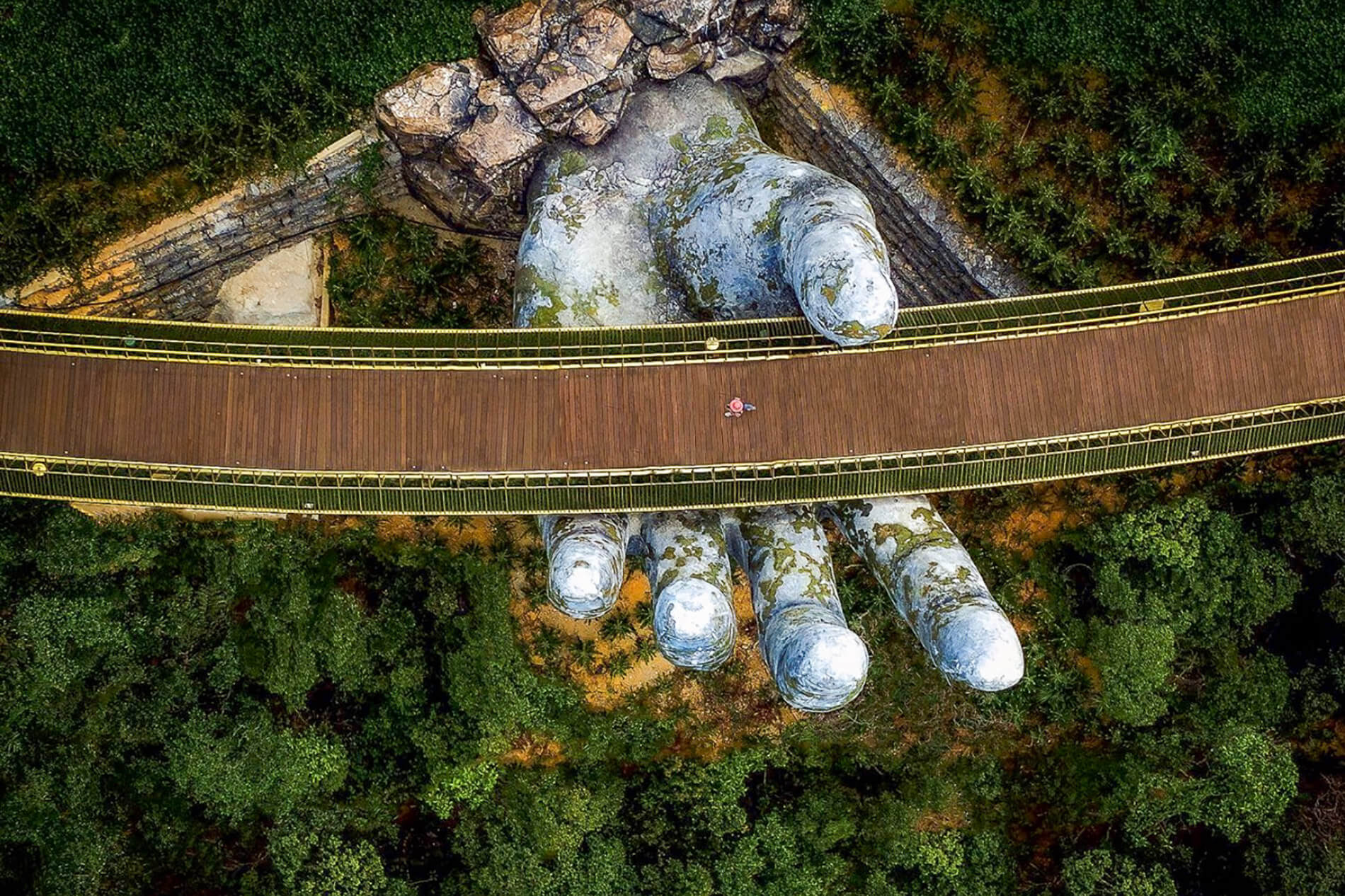
Golden Hands Bridge Tour In Sunrise or Sunset (1/2 Day)

Cam Kim Island Bicycle Tour From Hoi An
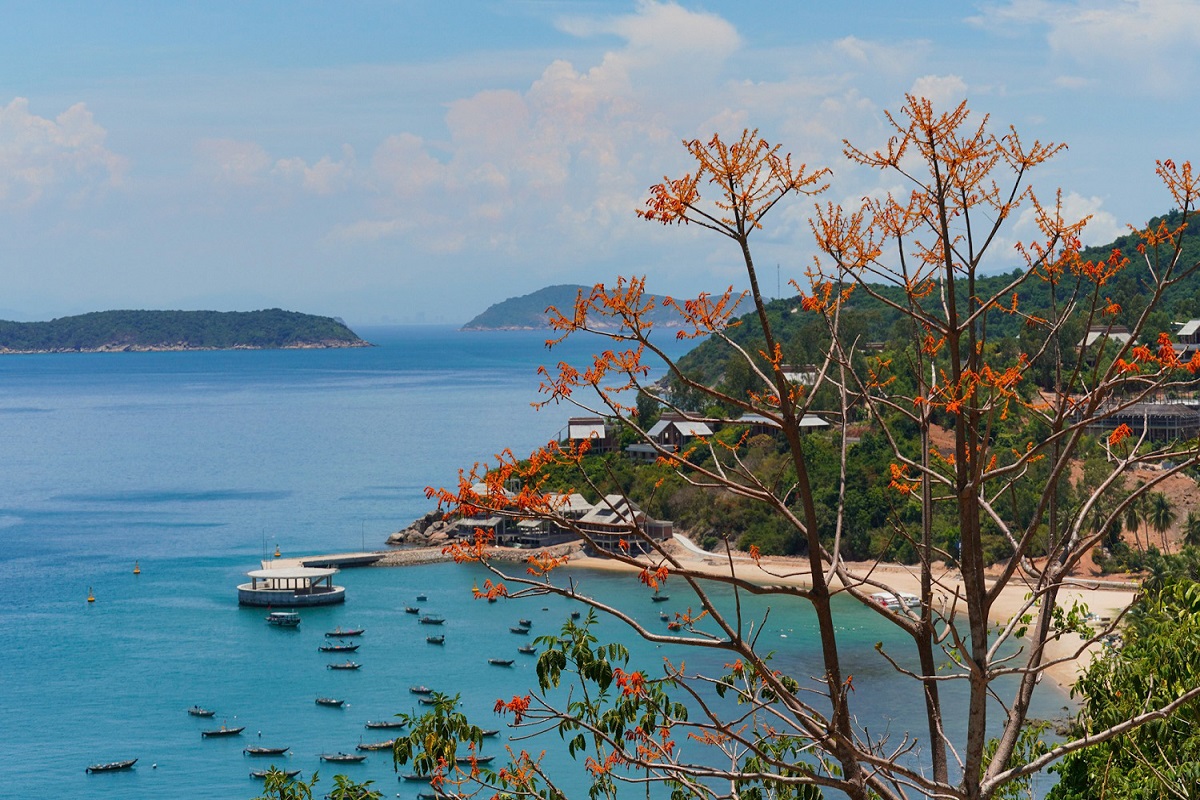
Cham Island Tour From Hoi An (Group Tour)

Cham Island Tour From Da Nang (Group Tour)

Hoi An Vegetarian Food Tour

Hoi An Evening Walking Food Tour Through Laneways

Private Hoi An Basket Boat Tour (Shuttle Bus, Bicycle, Bike)

Half-day Am Phu Cave Tour (Private)

Hoi An Countryside Tour (Bicycle, Car, Electric Shuttle)

Da Nang Tour Package From Singapore
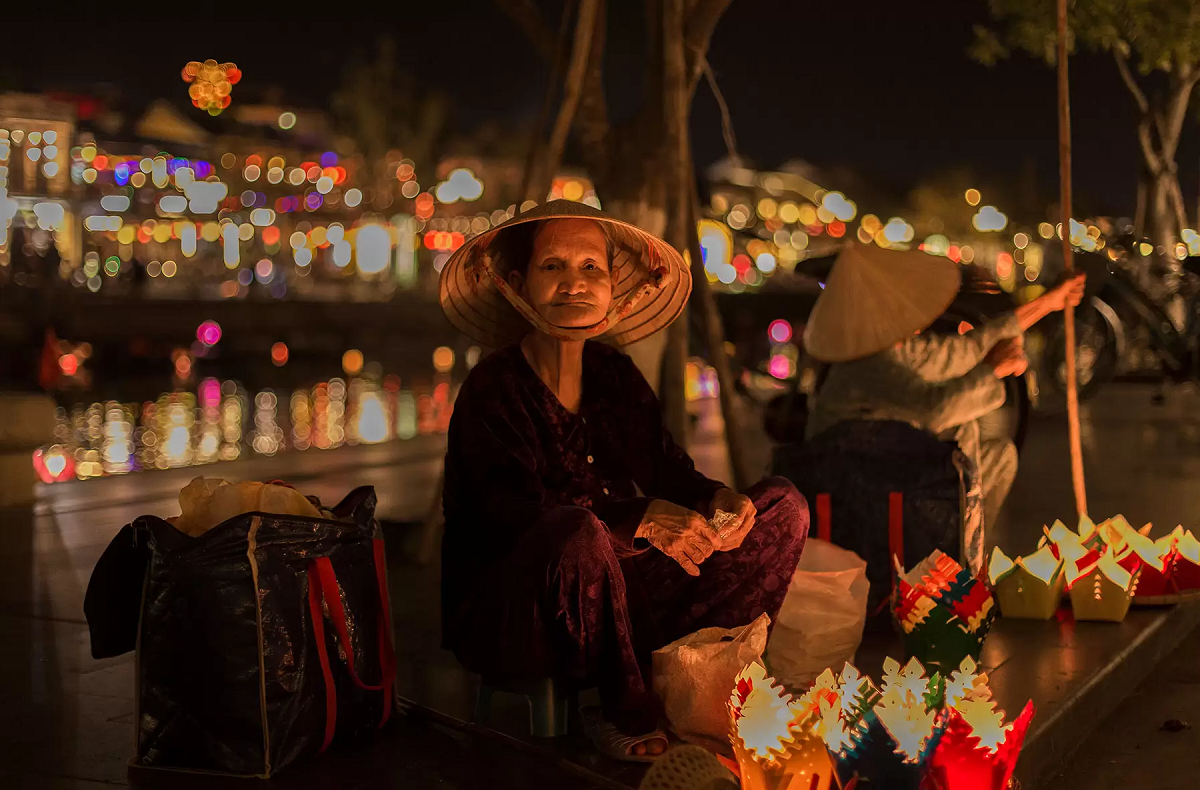
Hoi An Evening Tour From Da Nang

Hoi An Walking Food Tour Through Laneways
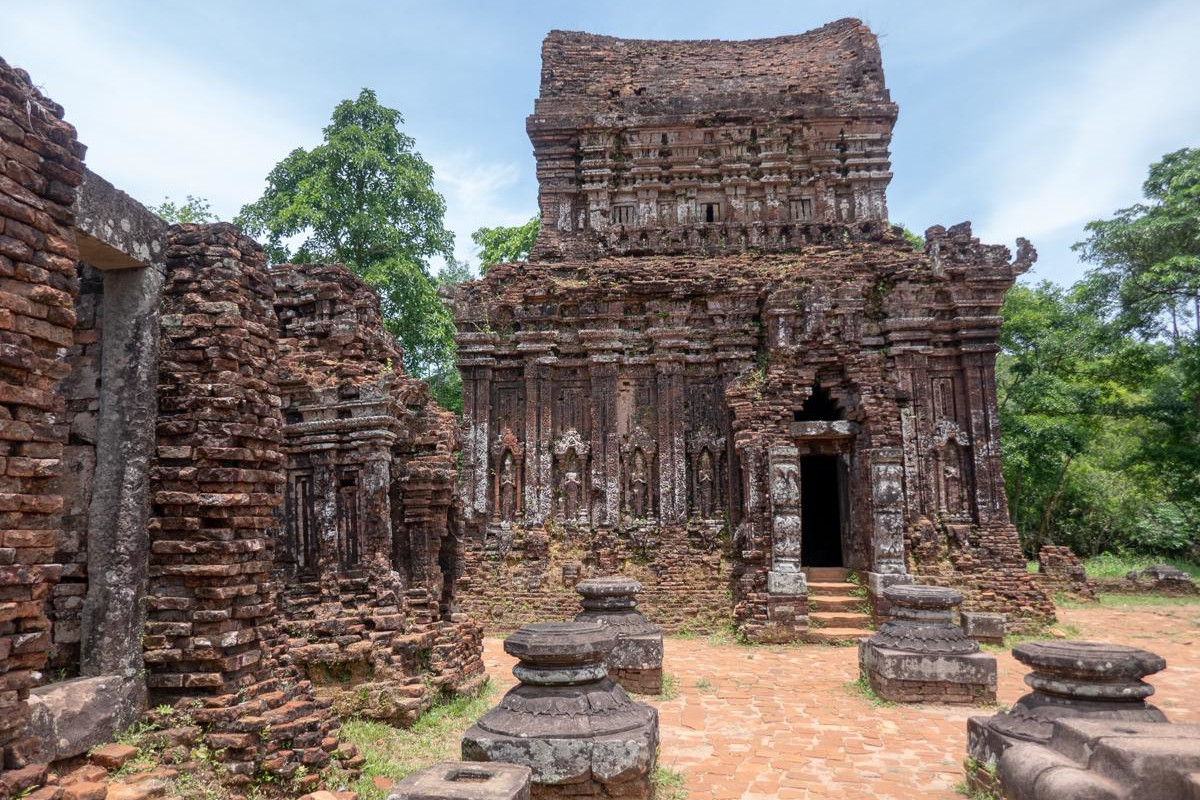
My Son Sanctuary and Hoi An Old Town Tour with Thu Bon River Cruise

My Son Day Trip From Hoi An including Marble Mountains and Basket Boat
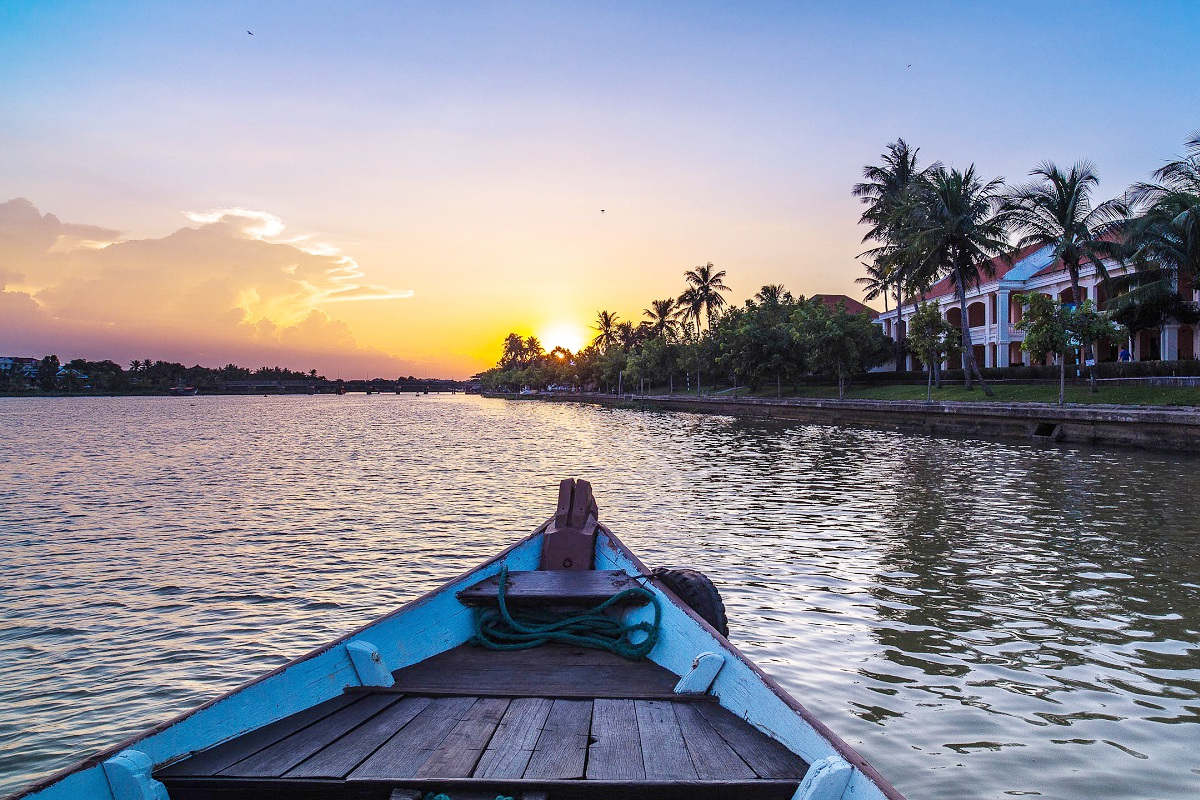
Half Day Hoi An City Tour With River Cruise

Son Tra Peninsula Tour with Marble Mountains (Private/Small Group)

Hue Day Trip From Hoi An with Hai Van Pass, River Cruise & Lunch

Hoi An Ancient Town and Countryside Tour (Bests of Hoi An Tour)

Hoi An Tour From Da Nang Airport (Private, Optional Lunch)

Hoi An Day Trip From Da Nang (Marble Mountains, Basket Boat, Old Town)
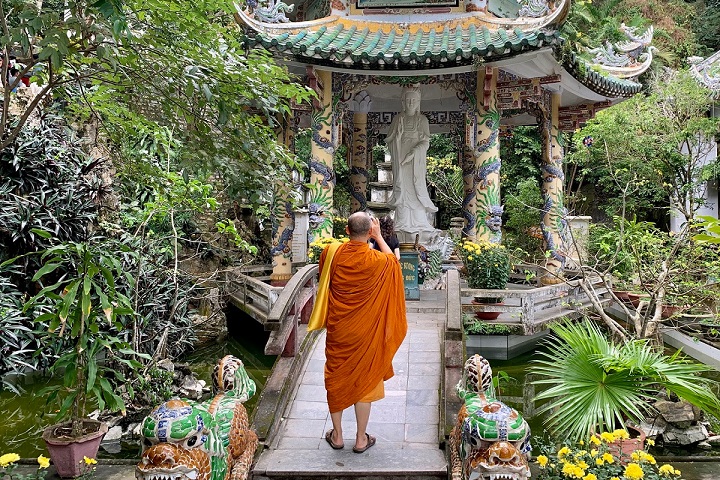
Da Nang City Tour From Airport (Private, Optional Lunch)

Hoi An City Tour with Lantern Class, Lantern Boat, Night Market & Local Food Sampling
Marble mountains, basket boat ride & hoi an old town walking tour.

Marble Mountains & Golden Bridge Day Tour with Buffet Lunch
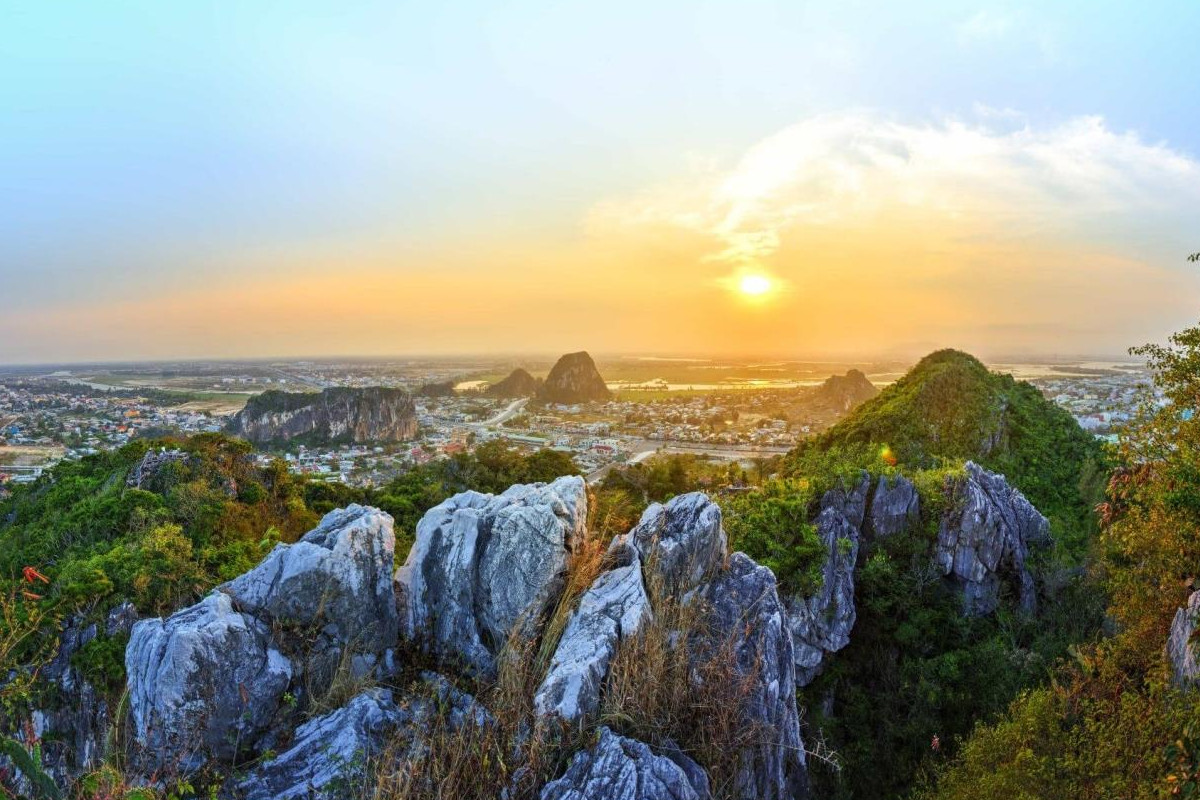
Marble Mountains & Monkey Mountain Tour (Half-day, Private)

Private Golden Bridge Sunrise Tour (Half-day, Optional Lunch)
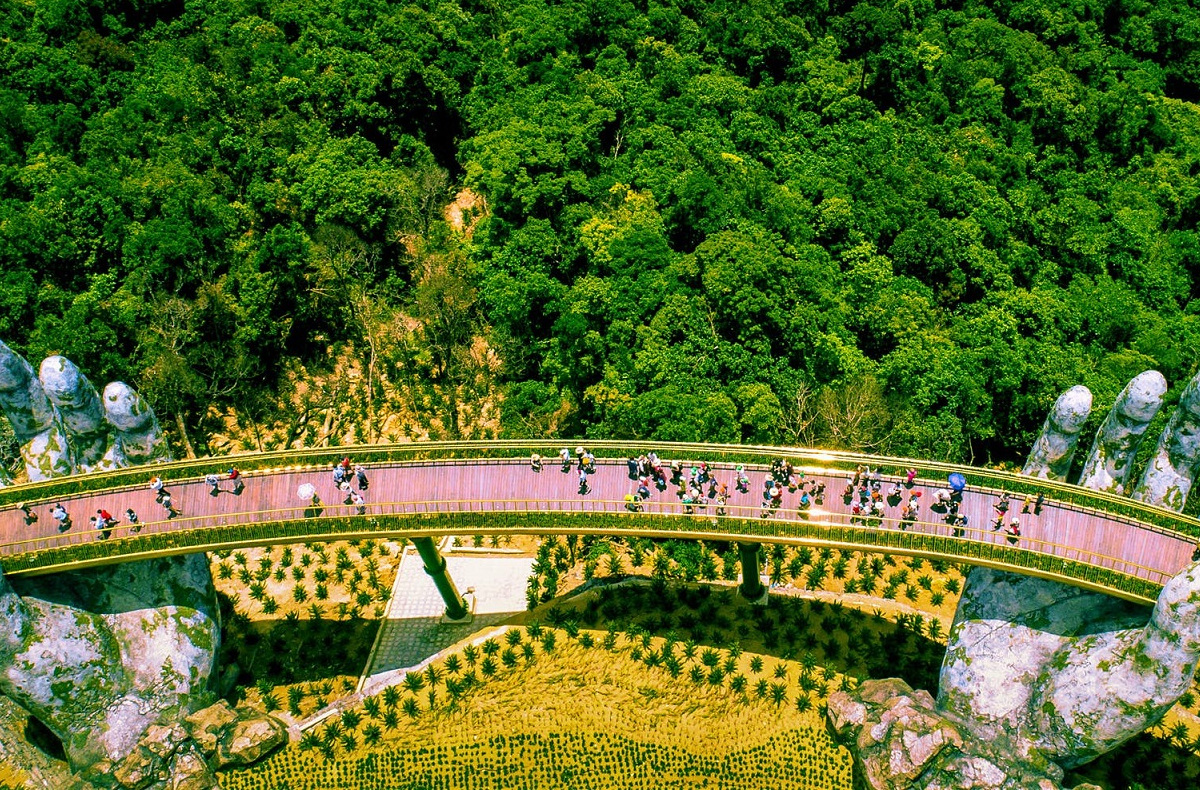
Hoi An Ancient Town & Golden Bridge Day Tour (Private/Small Group)

My Son Sanctuary & Golden Bridge Day Tour (Private/Small Group)

Private My Son Sanctuary Sunrise or Sunset Tour

Full Day Hoi An Ancient Town & Countryside Experience With Local


Full Day My Son Sanctuary & Hoi An Countryside Tour With Local

Full Day Hoi An Ancient Town & Coconut Village Experience

Son Tra Peninsula, Marble Mountains and Hoi An City Tour

Half-day Marble Mountains Tour from Da Nang or Hoi An

Da Nang Cave Tour (Half Day Underground Tour in Da Nang)

Hoi An Old Town & Lantern Making Class (Morning Tour, Half-day)

Full Day Bests of Da Nang & Hoi An Old Town Walking Tour

Full Day My Son Tour From Da Nang with Da Nang City Tour

My Son Sanctuary Tour From Hoi An or Da Nang With Local Guide

Hue Day Trip from Da Nang or Hoi An via Hai Van Pass with Lunch

Full Day Golden Bridge & Ba Na Hills Tour With Buffet Lunch

Full Day My Son Sanctuary Tour & Hoi An Old Town With Local

Half Day Da Nang Museums and Bridges

Da Nang City Discovery

Da Nang at a Glance (The Best Half Day Da Nang City Tour)

Full-day My Son Tour From Da Nang or Hoi An & Marble Mountains
Leave a reply cancel reply.
Your email address will not be published. Required fields are marked *
You may use these HTML tags and attributes: <a href="" title=""> <abbr title=""> <acronym title=""> <b> <blockquote cite=""> <cite> <code> <del datetime=""> <em> <i> <q cite=""> <s> <strike> <strong>
Save my name, email, and website in this browser for the next time I comment.

Expedia Rewards is now One Key™
Earn onekeycash when you sign in and book an activity.

Check availability
- About this activity
Hue Imperial City Sightseeing Full-Day Trip From Hue
- Free cancellation available
- Mobile voucher
- Instant confirmation
- Selective hotel pickup
- Marvel at Khai Dinh Tomb, one of Hue's spectacular Royal Tombs
- Check-in the traditional hat and incense village
- Enjoy Hue sightseeing tour
Activity location
- Hue, Thua Thien Hue, Vietnam
Meeting/Redemption Point
- Fri, Apr 19 -
- Sat, Apr 20 $58
- Sun, Apr 21 $58
- Mon, Apr 22 $58
- Tue, Apr 23 $58
- Wed, Apr 24 $58
- Thu, Apr 25 $58
- Fri, Apr 26 $58
- Sat, Apr 27 $58
- Sun, Apr 28 $58
- Mon, Apr 29 $58
- Tue, Apr 30 $58
- Wed, May 1 $58
- Thu, May 2 $58
- Fri, May 3 $58
- Activity duration is 8 hours 8h 8h
What's included, what's not
- What's included What's included Pickup and drop-off in the city center
- What's included What's included English speaking Tour Guide
- What's included What's included Dragon Boat
- What's included What's included Lunch at restaurant (local food)
- What's included What's included Water
- What's excluded What's excluded Entrance fees
- What's excluded What's excluded Beverages with lunch
- What's excluded What's excluded VAT and Personal Fee
Know before you book
- Not suitable for: People with mobility impairments
What you can expect
Our car and guide will pick you up at your hotel in Hue city center Get on a dragon boat along the Perfume river to Thien Mu Pagoda Visit Thien Mu pagoda – The oldest pogoda in Hue city Then you will transfer by car to visit: Hue Imperial Citadel – the home of Vietnam’s last royal dynasty – the Nguyen Dynasty
Having lunch with local Restaurant
Transfer by car to visit: Khai Dinh King’s Tomb – which is a blend of Western and Eastern architecture Minh Mang King’s Tomb – considered as the most majestic of all of the Royal Tombs. Renowned for its architecture, which harmoniously blends into its natural surroundings. Conical hat village and incense stick village Back to your hotel. Tour ends Finish 1-day Group tour in Hue .
- TRAVEL TIPS

NEARBY PLACES
Discovering hue: vietnam’s imperial city and unesco world heritage site.
Stop by, even if it’s just for a day, to travel back in time, learn about the country’s rich history and traditions and try unique regional delicacies. Explore breathtaking landscapes and scenery as you travel to the famous royal tombs in the city’s vicinity.
Table of Contents
Hue – A quick introduction

Located in the geographical center of Vietnam, Hue sits on the Perfume River, only a few minutes from the coast of the South China Sea. The surrounding hills and mountains made this the perfect location for Emperor Gia Long, the first ruler of the Nguyen Dynasty, to found his country’s new capital in 1802. From then on, Hue was the administrative and military center of a now unified Vietnam.
The proof of this history can still be seen very clearly today. The Citadel, Hue’s most important historical and cultural sight, occupies a prominent place in the middle of the city. It represents an excellent example of an eastern feudal city. Apart from this, there are numerous royal tombs, pagodas and temples inside and around the city, making it one of Vietnam’s most important cultural and historical centers. This is what got the attention of UNESCO who named the complex of Hue monuments a World Heritage Site in 1993.
The history of Hue imperial city
Since the beginning of the Nguyen Dynasty, Hue had been the growing influence of the French and the regular attacks by neighboring kingdoms – the Champa and the Khmer. This played an important role in Hue’s history and greatly influenced life in Vietnam.
The early Nguyen rulers did their best to minimize the effect of foreign influences on their country. But later on, Emperors Khai Dinh and Tu Duc are said to have been strongly impacted by the French. In particular, Tu Duc was considered more of a salaried employee of the French rather than a monarch.
With the end of Vietnam’s monarchy in 1945, the country’s capital was moved back to Hanoi. But Hue remained an important city nonetheless.
As the center of the Buddhist faith in Vietnam, Hue was and still is home to numerous monasteries. However, due to the strong missionizing efforts of the French, Catholicism started gaining followers, especially among people in influential positions.
In the early 1960s Buddhists were being systematically oppressed and were strongly discouraged from practicing their faith publicly. This lead to demonstrations and ultimately to several Buddhist monks burning themselves alive as a sign of protest.
Several years later, its geographical location close to the Demilitarized Zone (DMZ) made Hue the scene of bloody battles during the Vietnam War. The Tet Offensive of 1968 is most well-known. During this fight, the Forbidden Purple City, the innermost part of the Citadel was largely destroyed. Even today the damage can be seen as artisans are carefully working to rebuild and restore it.
When to travel to Hue
1. weather in hue.
Hue has a severe weather condition
Being a part of Central Vietnam, Hue has severe weather condition. Due to its location in the tropical monsoon belt, Hue receives a considerable volume of solar radiation, it’s about 70 – 85 Kcal/cm² per year. In addition, for being under the influence of Southwest wind blowing from Laos, Hue is considerably hotter than nearby regions such as Hoi An and Da Nang. The average temperature is around 25oC. The hottest month is August with the daylight temperature is up to 34oC. The coolest time is from December to January with the average temperature is around 20,3oC. The annual precipitation is estimated from 3,100 mm to 3,250mm. The Truong Son Mountains in the South bottle up all the moisture. That’s the reason why Hue is usually misty, and drizzly. Hue has pretty high humidity which is around 86.7%. Humidity is often higher than usual in the rainy season, especially from February to the end of March.
Hue’s climate is generally hot and humid. But if you can plan your trip between February and April, you will most likely experience cooler and drier weather. If you don’t mind the heat, June and July are an option as well but be prepared for the temperatures to be in the low thirties with high humidity. The time to avoid Hue is from August to December as this is the rainy season. During this time, you risk losing an entire day to downpours which make it very unpleasant to visit any of the city’s sights (they are all outdoors).

Hue has two indistinct seasons
Hue climate features common traits of the transition region between subequatorial climate and inter-tropical climate. Therefore, Hue has two indistinct seasons including winter and dry season. Summer often lasts from April to September. During these months, especially from July to August, Hue has the scorching heat. It’s also drier due to the winds blowing from Lao. It only gets a bit cold in the winter from October to March since when northeast monsoon. Like other regions in Central Vietnam, Hue suffers a lot of tropical storms which often appears from June and occurs in high density between September and October.
2. When is the best time to visit Hue, Vietnam
From February to March
The perfect time to visit Hue is from February to March. During these months, the weather is cooler. The average temperature ranges from 20oC to 22oC, which makes it more comfortable to go outside and explore the beauty of this city. In addition, the precipitation in these months is lowest throughout the year. So that you don’t have to worry that the rain may ruin your vacation.This time also concurs with the beginning of Lunar New Year. Therefore, it’s the ideal time to visit spiritual destinations such as Thien Mu Pagoda, Hung Khanh Pagoda, Bao Quoc Pagoda and Thien Lam Pagoda.
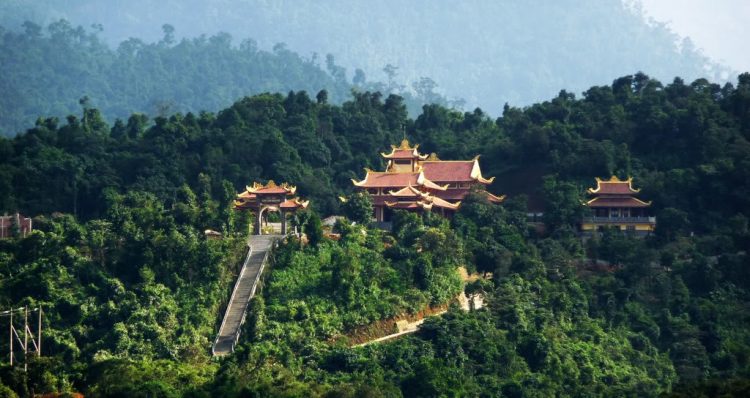
From October to January
From October to January is also an ideal time to visit Hue when it starts cooling off. During these moths, Hue suffers many heavy spots of rain, several ones even bear tropical storm. Heavy rains may prevent you from scrolling around the city. However, you still can visit historical sites such as An Dinh Palace, Temple of Literature, and Museum of Royal Antiquities. From October to January is also the time when many remarkable festivals are celebrated in Hue. Visiting Hue in these months, you can have golden chances to enjoy the Nha Nhac (Vietnamese Court Music), which is recognized as the Masterpiece of the Oral and Intangible Heritage of Humanity.
How to travel to Hue
1. getting to hue.
By airplane – the fastest way to travel

Phu Bai International Airport is 15 kilometers from Hue City and takes about half an hour to get from the airport to downtown Hue. In the past, Phu Bai International Airport was chiefly used by the French and the Americans. But since 1975, it has been transformed to server civilization purpose. As featuring limited size, Phu Bai Airport is able to receive only medium-sized planes such as Airbus A320, and Boeing 747. To travel by airplane, you can book the online ticket from one of the most popular OTA ( baolau.com or 12Go.asia ).
The cheapest way to travel from Phu Bai Airport to the center city is taking an airport bus which cost you from VND 30,000 to VND 40,000. If you have a lot of luggage, it’s better for you to take a private car ( Private Phu Bai International Airport Transfers (HUI) for Hue ).
By train –The most interesting way to travel

Hue Railway Station lays on the main North-South Railway. Constructed by the French colonial authorities during the French Indochina period, Hue Railway Station is considered one of the most beautiful stations in Vietnam. Nowadays, Hue Railway Station handles passenger and cargo transportation from the North to the South and is an important transit point of the Center of Vietnam.
To get more information of other train route and book the tickets, you can visit most popular OTA ( baolau.com or 12Go.asia ). Alternatively, you can purchase tickets from the ticket booths at the city train stations. However, you might face the risk of running out of tickets. Therefore, it’s better to book in advance.
By open bus – The cheapest way to travel
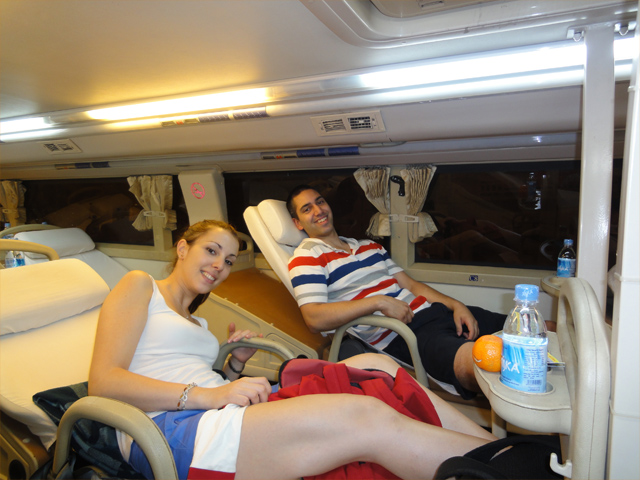
There is no doubt that getting to Hue by open buses is the cheapest way. Since this city is a popular destination in Central Vietnam, there is a considerable number of bus operators. That’s why you will have a lot of choices and able to travel to Hue at any times. There are two bus stations in Hue including The Northern Bus Station connecting to the Northern regions of Vietnam and The Southern Bus Station connecting to North Vietnam. To get more information of other train route and book the tickets, you can visit most popular OTA ( baolau.com or 12Go.asia )
Read more: How to Get from Da Nang to Hue (& Vice Versa)
2. Getting around Hue
By bus – The cheapest way
Hue has an extensive network of buses that reach every corner of the city. Thanks to the government subsidies, the bus ticket is amazingly cheap. It only cost you around VND 7,000 no matter where you go as long as your destination is one part of the bus route. That’s why the bus is considered the cheapest and most convenient way to get around Hue. Please take it into consideration that the buses often operate from 06:00 to 19:00. Therefore, if you want to explore the nightlife in Hue, or want to travel far away, you have to choose another means of transportation.
By cyclo – Must-try means of transportation

Cyclo is one of the most primitive means of transport dating back to the early 20th century of Vietnam. After the “motorbike –boom” at the beginning of 21st century, cyclo became redundant people needed to travel farther and faster. Nowadays, cyclo only remains in some cities of Vietnam and chiefly serves foreign tourists. With the low speed, cyclo offers you the best way to admire the charming beauty and enjoy the tranquility of Hue.
Normally, the total price depends on the distance, and sometimes on the weather condition. Remember to ask the price clearly to reach an agreement before setting off on the trip. You also have to watch out for any negotiating tricks, make sure that the amount negotiated covers the return trip.
By bicycle – The most interesting way

Hue has a pretty light traffic, that’s why Hue is a wonderful place to rent a bike and scrolling around. Many hotels rent out the bicycles for about VND 20,000 – VND 30,000/day. You also can rent a bike from the rental bike shop.
By motorbike – The most flexible way

Motorbike is the most common means of transport in Vietnam. It’s also the favorite way to explore the city of many foreign tourists. With a motorbike, you can travel to anywhere you like, and whenever you want. The traffic here is light and isn’t as crazy as the traffic in Hanoi and Ho Chi Minh City. Therefore, traveling around by motorbike is a great choice. You can rent a motorbike in your hotel for VND 120,000 – VND 200,000/day, depending on the kind of the motorbike.
- The requirement of renting a motorbike: Passport, ID, Driving License.
- Speeding & Speed limits: In the city, speed limit allowed is 40km/hour
What to do and see in Hue
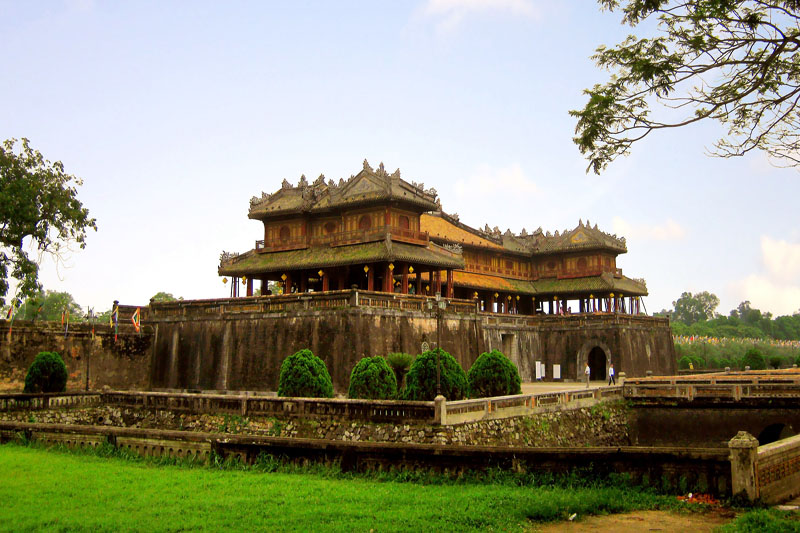
Hue is full of interesting historical sights that will bring the history of Vietnam to life in a very special way. When you come to this city, be sure to take enough time to see the wonderful places here, because quite honestly, if you just rush through, you will really miss out.
1. The Citadel
The history
Since the Vietnamese emperors and their families used to live in Hue, the evidence of their lives is still very present in the city today. To get an idea of what it was like and how imperial Vietnam was run, head over to the Citadel. It’s made up of several parts and covers quite a large area in the city center, so you can’t miss it.
The Citadel was the outer-most part of the city and is surrounded by impressive brick walls and a moat fed by the Perfume River. Today the inside of the Citadel is full of businesses, shops, and some remaining historical buildings. Back in the day, this is where the main administrative work was carried out and the military’s central commanders sat.
…and the Imperial City
The Imperial City is located inside the Citadel, where the emperors and their family used to live. On the map, it looks like a smaller square inside the Citadel, on its southern side. This space is also behind thick walls and was only accessible to selected guests and servants. Enter the Imperial City through the beautifully restored Noon Gate and imagine your surroundings bustling with high-ranking officials, foreign dignitaries and serving staff to get an idea of how grand this place once was.

Finally, at the very center of the Imperial City, you will find the Forbidden Purple City. This is where the emperor’s consorts lived. Back then, the only people who were allowed to access this place were the emperor himself and the eunuchs serving the royal consorts. It was the most safely guarded place in the entire country. Unfortunately, most of it was destroyed during the Battle of Hue, during the Vietnam War, but work is underway to restore as of it much as possible.
2. Hue’s Royal Tombs and Pagodas
Once you’ve explored the Citadel thoroughly, it’s time head to the outskirts of Hue and into the countryside to see the city’s other historical gems. The royal tombs and pagodas are located along the Perfume River and are dedicated to members of the imperial family. Each one is different and special in its own way, so be sure to visit the main tombs below.
Thien Mu Pagoda
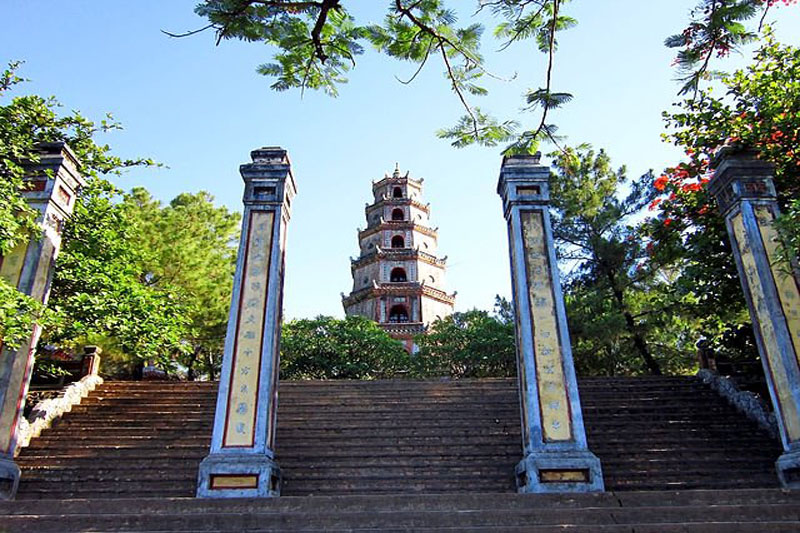
Thien Mu is located a short distance outside of Hue and overlooks the Perfume River. Its beautiful structure and design have become a symbol of the imperial city, known by local and international visitors alike. Built in 1601, this seven-story pagoda is an important religious site but also has a reputation for being at the center of various political demonstrations. Stop by to visit the pagoda , see the car used by the infamous burning monk and Buddhist martyr Thich Quang Duc, and learn his background story.
Emperor Minh Mang’s Tomb

In An Bang village, twelve kilometers outside of Hue, you will find Emperor Minh Mang’s tomb. It was built by his son and successor Thieu Tri and consists of several buildings, pagodas, and a lake. Climb up the steep staircase to enter the compound through its imposing, beautiful gate and reach the main courtyard. From there you can see the temple honoring the emperor and empress, visit Minh Mang’s sepulcher and go on a stroll around the expansive grounds.
Emperor Khai Dinh’s Tomb

Although Emperor Khai Dinh was quite unpopular with the Vietnamese people, his tomb is among the most visited sights in Hue. Made with rich decorations such as detailed ceramic and porcelain ornaments, this tomb is highly elaborate. It’s famous for its impressive mix of European and Vietnamese architectural styles which is said to stem from Khai Dinh’s travels to Europe where he was impressed by the style and designs of the buildings he saw.
Emperor Tu Duc’s Tomb

Emperor Tu Duc’s tomb is one of the most visited in Hue and should not be missed. Tu Duc was the Nguyen dynasty’s longest reigning monarch and he actually designed his tomb himself. It’s made up of several parts including the main hall, a lake with a small island, and expansive grounds covered in lush greenery. One thing that makes this place special is that Tu Duc was not actually buried here but requested to be laid to rest at an unknown location. Until today the exact place remains a mystery.
Perfume River
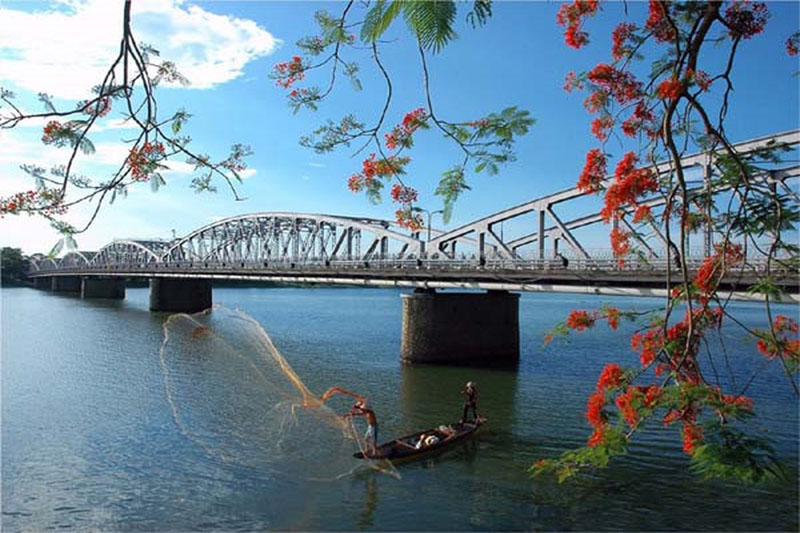
The Perfume river is as much a landmark as Hue itself. Originally named after the sweet scents of tropical flora and fauna, it quickly gained importance as a trade route that connected Hue to nearby cities and villages.
As the river gently winds its way through the city and the surrounding countryside, it offers a place of stillness and quiet, quite contrary to the hustle and bustle of the city. Come out here to take a walk along the river banks and spot several historical sites on its shores.
3. Vong Canh Hill

Vong Canh Hill, the 43-meter high hill, is located 7 kilometers from the center city. As its name suggests (“Vong” means “watch”, “Canh” means “scene”), Vong Canh Hill is the best place to catch a panoramic view of Perfume River. From the top of the hill, you can enjoy the natural beauty and the tranquility of Hue. In front of your eyes is a harmonious, attractive picture of peaceful villages stretching along the river banks, small boats quietly skimming and the green corn field inscribed by the pine trees.
Vong Canh Hill is surrounded by many royal tombs. Coming to Vong Canh Hill, you will have chances of visiting many royal tombs such as King Tu Duc’s, Dong Khanh’s, and Thieu Tri’s’ tomb. You can also visit the Water plant Van Nien which is the Oriental-styled building designed by a French architecture.
4. Nam Giao Esplanade

Nam Giao Esplanade is the monument where Nguyen Kings used to come to give offerings the God annually in the spring. In spite not being in the intact condition, Nam Giao Esplanade is still the largest one in Vietnamese history left.
This monument consisted of three terraces which symbolized three agents including heaven, earth, and man. The topmost terrace is “Vien Dan” symbolizing Heaven. Vien Dan has circle shape and is surrounded with blue-painted parapet. There is a stone called “Thanh” piercing with the circular holes on the surface. Right below the Vien Dan is Phuong Dan – the square terrace symbolizes Earth. This terrace is surrounded with yellow-painted parapet. The lowest terrace is also square and symbolizes human. All three terraces feature doors at very four sides: East, West, South, and North.
Vietnamese and Chinese people used to think that King was the son of the Gods. Nam Giao Ceremony was a ritual, solemn ceremony of Nguyen Kings to show the respect and to worship their parents (heaven and earth). The first ceremony was held in 1807 and from then on it was held annually in the spring until Thanh Thai times in 1907, it was ordered to hold every three years by the King because he realized this ceremony is too costly. Nam Giao Ceremony was also an occasion when the Nguyen Kings pray for timely rains and favorable weather as well as peace to their country. That’s the reason why for the Nguyen Kings, Nam Giao Esplanade was the most sacred place that needed to be kept well. Visiting Nam Giao Esplanade, you will have chances of understanding more about the history and culture of ancient Vietnam.
5. An Dinh Palace

Located by the bank of An Cuu Canal, An Dinh Palace was the palace where Bao Dai King, the last king of Vietnamese feudal court, and his family lived from 1945 to 1955. After several restorations and conversations carried out strictly to UNESCO standard, recently An Dinh Palace has been opened for tourists by the Center for Preservation of Hue Relics.
In the beginning, An Dinh Palace was built to be the private residence of the king Khai Dinh. After officially acceding to the throne, the King Khai Ding continued to renovate this palace in modern European style between 1917 and 1919. It’s the special aesthetic sense and eccentric mental sense of the king Khai Dinh that created the unique feature of this palace.
Come to this site, you are free to explore the beauty of the sophisticated decoration at Khai Tuong Pavilion. This pavilion consisted of three stories, all of which were designed in modern European style and were constructed by a modern material. At the first floor, An Dinh Palace features the wall paintings with many remarkable western style paintings survived in Vietnam from the early 20th century. In addition, this palace serves as a museum with over 40 photos, 100 original objects and 30 documents on display reproduces lives of this royal family.
6. Off the Beaten Path: Lesser-Known Sights Around Hue
Finished all the sights but still have some time on your hands? Then you’re in luck because Hue has some more great places that are not as well known to visitors but definitely worth a visit.
Ho Thuy Tien: Hue’s Abandoned Amusement Park
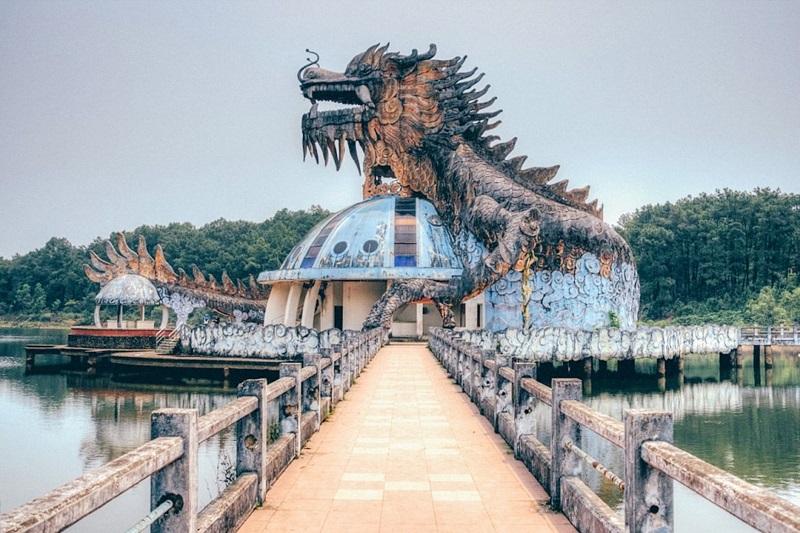
Opened in 2004, this water and amusement park was only operated for a few short years before being closed down. Originally it was planned as a place for families to come enjoy a weekend of fun rides, interesting aquariums, and entertaining shows. Today it has become a popular place for those who like the eerie feeling of all things abandoned. If you’re one of them, Ho Thuy Tien is a great way to spend a few spare hours.
Located just about eight kilometers outside of Hue’s main tourist area and clearly indicated by signs, it’s easy to find and get to. The park is open, so you don’t need to climb any fences or sneak past security guards to get in.
Once you reach it, stroll around the abandoned buildings, past the immobile rides and empty aquariums. Climb up inside the dragon in the lake and get a sweeping view of the park and its surrounding landscape. Seeing this place that was meant for fun in a silent standstill will make you feel like you’re in a disaster-stricken place that people deserted long ago.
For the best photos, go in the early morning or around sunset. That way you’ll get some cool visual effects and the long shadows will add to the park’s unnerving atmosphere. If you prefer to join an organized tour, you can opt for a Thien An Monastery, Ho Thuy Tien Park, and Thuy Bieu Village Motorbike Half Day Tour .
Hidden Paradise: Hue’s Beaches

If an abandoned theme park is not really your thing, there are plenty of more pleasant and vibrant places to visit around Hue. If you’ve just come from Ho Thuy Tien, you probably don’t want to feel like the world has ended. Instead, head over to some of Hue’s beautiful beaches to relax and take in a breathtaking sunrise.
While Da Nang and Hoi An usually get all the credit (and the visitors!) for their wonderful coasts, Hue boasts equally wonderful beaches that are not nearly as busy. For a refreshing swim, a wonderful view of the surrounding majestic mountains and a colorful sunrise, go to Luang Co and Thuan An. Soft white sands and blue waters welcome you there and you’ll probably be surprised why such a great place attracts so few tourists. So, pack your bathing suit and a towel, and get going.
Bach Ma National Park
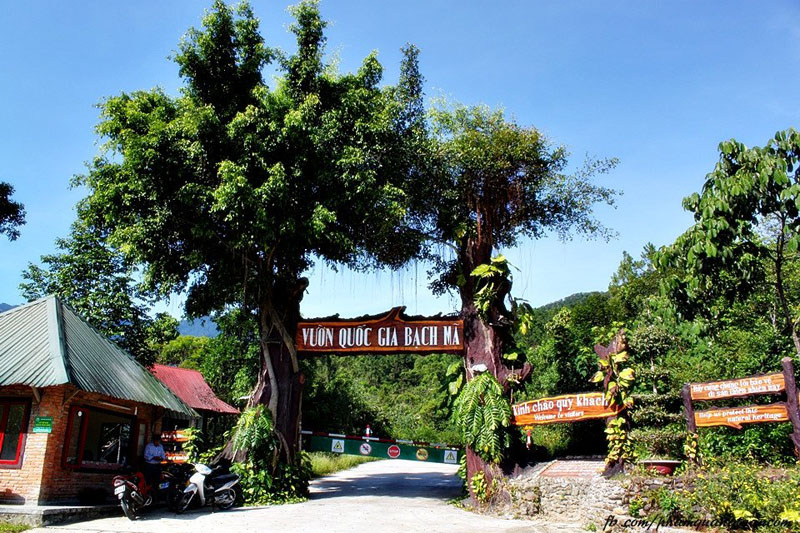
Outdoorsy and adventurous travelers will love a trip to Bạch Mã National Park. It’s about 45 kilometers from Hue but worth the drive if you love being out in nature. In Bạch Mã you can go for treks, walks and even some rock climbing to a stunning backdrop of verdant hills. Climb all the way to the top of the park’s main mountain at 1,500 meters and enjoy a sweeping view of the surrounding countryside, the Dam Cau Hai Lagoon and on days with good visibility, even the ocean.
Bạch Mã is also the home of many rare species of plants, birds and insects, so tread lightly and you might get to see some of its special residents. If this is something you are particularly interested in, get a local guide to show you the best spots for bird and animal watching. Get ready to see bulbuls, malkohas, herons and egrets to name only a few of the over 350 native species.
The park offers single day tickets or even an overnight camping option. So, if you’re not pressed for time you can spend the night under the stars in Bạch Mã.
Check the price for Bach Ma National Park Trekking Day Tour here
Picturesque Bunker Hill and Vibrant Incense Road

Off the well-worn path of this charming city, there hides a hill with mossy bunkers, from which you can see a beautiful bend in the gentle Perfume River and imagine how soldiers used to observe their region from this point. Despite its history, this hill has a romantic name: Vong Canh Hill, which means the hill to contemplate nature . Among the old pine tree lines, a cluster of concrete bunkers quietly reveal hints of the past to those that can find them. These bunkers were built by the U.S. army over half a century ago, in order to block this hill as a strategic geographic point in battle. And yet, today, these bunkers sit silently as old friends reminding us that wars pass and nature reclaims her earth.
The hill is only seven kilometers from the city, so you can reach it by car, motorbike, or even a bicycle if you want to be environmentally friendly! On the way to this hill, you will have a chance to pass through the vibrant incense-making village. The village is accessible through Huyen Tran Cong Chua street. It used to serve as the main incense supplier for Hue, however now it is a quiet place that sees a few tourists. You can learn about its history, maybe even make your own incense, as well as understand how the locals create colorful bunches of these celebratory artifacts. If you are interested, the artisans will he happy to show you how to make them yourself.
You should reach bunker hill at sunset. At this special moment, the Perfume River reflects the light with genuine royal beauty. If you have good eyesight or a camera, you can also zoom in to witness the boats floating leisurely. If you choose this moment to visit the hill, you should expect to arrive at the incense village no later than 4 PM.
Thanh Toan Bridge (Cầu Thanh Toàn)
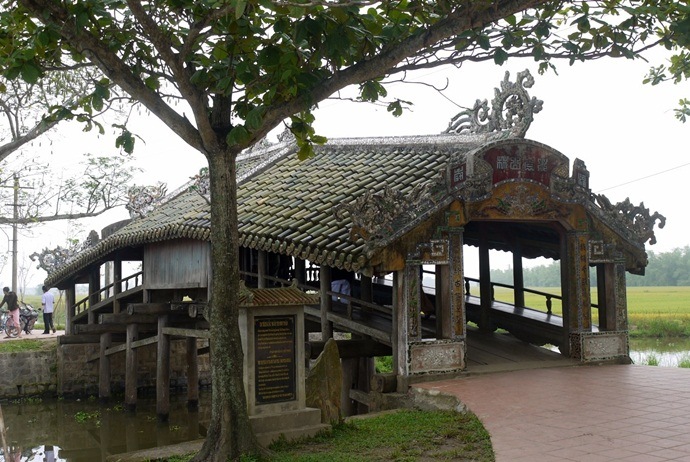
Thanh Toan Bridge is the sister bridge of the famed Japanese bridge of Hoi An . This bridge is arguably much more distinct as it has both Japanese and Chinese features, with rare squared timber arch dotted with ancient ceramics. This bridge is hard to find yet the countryside trek is really worth it.
Thanh Toan tile-roofed Bridge is about 18.75 meters in length and 5.82 meters in width. On both sides of this bridge, you will see rows of wooden platforms and parapets for visitors to lean against. Thanh Toan Bridge was often used as a place for relaxing for villagers after hard field work or tourists after sightseeing.
The thing that makes an interesting diversion of Hue lies in the classic covered Japanese footbridge put in picturesque countryside. From outside, this bridge looks like a house. The main decoration of the bridge is on its roof with patterns of “turtle, dragon, turtle, and phoenix”. The tile-roofed Thanh Toan Bridge is not just an ancient architectural construction with highly cultural and historic value but also one of well-known Hue attractions. Similar to most of other historical Hue attractions, Thanh Toan Bridge has been ruined a lot of times by floods, storms, and wars. Nevertheless, each time this bridge was damaged, the locals always repaired, renovated and preserved it well as the result of their high awareness of historical relic perseverance and their gratitude to its respectful founder.
Thanh Toan Bridge spans a canal in the suburb about 7 kilometers east of the city of Hue. You could go there by hiring a motorbike, a bike or a taxi. Whatever means you choose to travel, your trip will definitely take you through a peaceful and beautiful rural landscape. The bridge itself is renowned to have been established in the time of King Le Hien Tong (Lê Hiến Tông) right in the mid 18th century.
Check the price for Thanh Toan Village Half Day Tour here
Tam Giang Lagoon (Đầm Tam Giang)

The last one in this list of Hue attractions is Tam Giang Lagoon which is about 24 kilometers in length and covers an area of 52 km2. Belonged to Phong Dien (Phong Điền), Quang Dien (Quảng Điền), Huong Tra (Hương Trà), Thua Thien Hue province, Tam Giang Lagoon stems from Thuan An (Thuận An) harbor. Here, small boats sweeps on the river named O Lau, along the lagoon length. Passing over 15 km of fields and bridges along the lagoon, you could reach Thai Duong Ha village. Then, after traveling by boat for 30 minutes, you come to the island on Tam Giang Lagoon, in which there is an ancient village named Thai Duong.
The most beautiful moment on this lagoon is at sunset when the sky turns supple. Tam Giang local people survive thanks to catching shrimp and fish. Males will go fishing offshore. Before the sun breaks over the horizon, they have to collect shrimp and fish from traps. At dusk, they reset nets and traps. At the same time, females toil to catch calm and oysters because they have to soak their own body in the water for a few hours in order complete their work.
The lagoon itself is also home to a lot of birds’ species and various fauna and flora species. It is also like a huge air-conditioning area, contributing to present storms in Hue. Locals call Tam Giang – Cau Hai (Cầu Hai) an unopened treasure.
If you want to visit Tam Giang Lagoon, consider a recommended tour below. Such tours help connect you with the locals and supply you with some basic services and guiding information about this region.
Best things to do in Hue
1. shop at dong ba market.
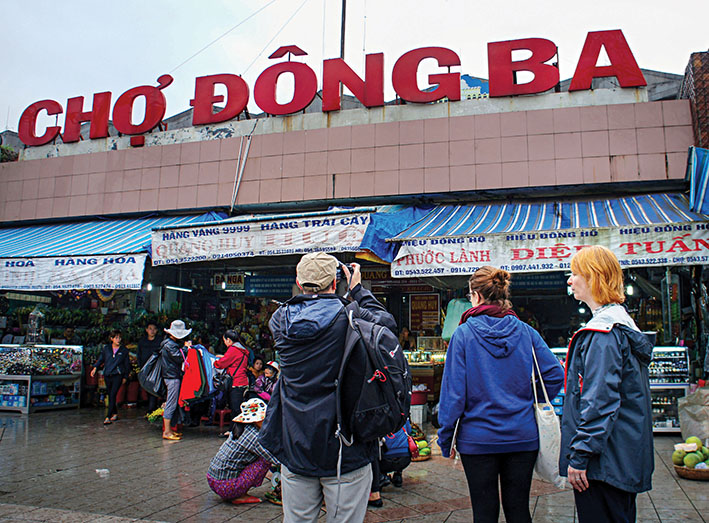
This may be one of the most relaxing things to do in Hue. If you are keen on discovering Hue city via the traditional products, it is highly recommended to visit Dong Ba (Đông Ba) Market. Considered as the largest market place in the central area of Vietnam, Dong Ba market is a definite place to immerse yourself in the culture of people here. Once visiting here, tourists hardly get out soon as they are strongly absorbed by myriad items as well as local specialties. You could see various features of a traditional Vietnamese market, like the bazaars, the bus station, the sampan landing. A variety of traditional crafts which reflect the ancient cultural features of Hue could be found here like Hien Luong (Hiền Lương) scissors, Phu Cam (Phú Cam) conical hats, Ke Mon (Kế Môn) jewelry, Phuoc Tich (Phước Tích) pottery, Nam Thuan (Nam Thuận) sweets, Tinh Tam (Tịnh Tâm) lotus, and bamboo products. In addition, Dong Ba market is an abundant source of many local daily dishes, for instance, beef noodles, bean puddings, shrimp cakes, pancakes, clam rice, sour shrimps and so on.
Here, you will also see a lot of everyday activities and shop everything from souvenir items to Hue sesame sweetmeat, bronze goods, conical poem hats, etc. If you are really interest in Vietnamese culture and food, you should come here to explore. Despite a few new markets have emerged within Hue City, Dong Ba market still remains its crucial role as the biggest market where various commercial activities happening daily.
2. Climb up the Ho Quyen, Tiger Fighting Arena and Long Chau Temple

One of the most interesting things to do in Hue is visiting Ho Quyen (Hổ Quyền), the tiger fighting arena. This site was established in 1830 during the regime of Emperor Minh Mang to stage battles between a tiger and an elephant annually. This is an Asian version of the Roman coliseum. It was used for entertaining the Emperor and his family and nobility. Sadly, today, it is overlooked by many tourists. The arena contains two circular, thick walls around an earthen rampart, with the stairs leading to the highest position of the wall, one being reserved for the Emperor as well as his family while the remaining for the rest of the court along with commoners. In opposite to the royal rostrum, there are five tiger cages with the claw marks visible in the walls. The fight was like a professional wrestling. Prior to the fight, the tiger was manipulated drugged, and had it fangs and claws removed. If the elephant sent into fight could not do the job, another one was sent to support. Then, the elephants always won. Why? The tiger was symbolized rebellion while the elephant was symbolized the monarchy.
Another suggestion you can consider among many things to do in Hue is to visit Long Chau (Long Châu) temple, which is located on the south bank of the Huong River. This is a royal temple in which the kings’ war elephants were respectfully buried and worshiped. It is also known locally as “Dien Voi Re” (Điện Voi Ré), meaning the “Palace of the Crying Elephants”. This site is situated about 200 meters from the Ho Quyen arena, where tigers and elephants dueled to the death. The temple looks out over the big pond filled with lotus where it is said the triumphant elephant went to relax after having a successful fight. Up to now, the spot is not maintained well and needs to be conserved carefully. Ho Quyen arena and Long Chau temple are very much worth including in your list of things to do in Hue if you want to explore more historic aspects of the ancient city of Hue.
3. Enjoy the Brass Works
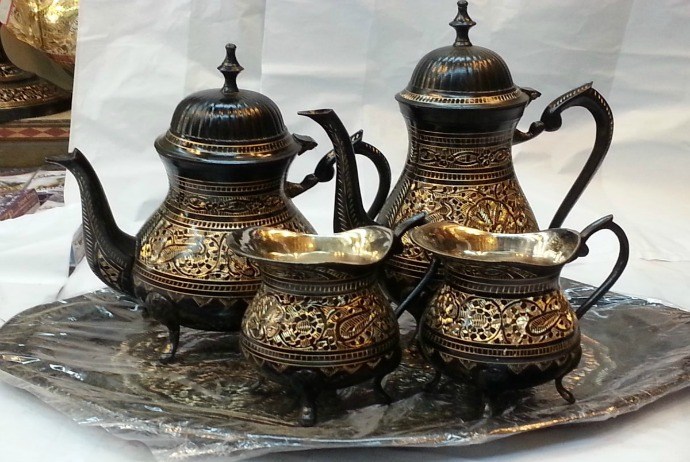
This is one of little-known things to do in Hue for many tourists coming Hue. But, it is worth a try. From Tu Duc tomb, you can take a stop at the Brass Works. The outfit used here makes massive brass statuary for purchasers worldwide. The smiting and forging are done by using the fundamental techniques. The craftsmanship is very impressive.
- Opening hours : 8 am – 5 pm
- Location : No.48 Huyen Tran Cong Chua (Huyền Trân Công Chúa), Hue (Huế) City, Thua Thien Hue (Thừa Thiên Huế) Province, Vietnam (Việt Nam)
4. River Cruise
A journey to Hue will not be complete if without a cruise on the Huong River. With two options of different styles of cruise that cater to all tastes, this idea of things to do in Hue is very interesting for most tourists. You could not walk along the bank of Huong River without paying attention to the dragon boats that putter past. The morning route could be hopping onto a small yet long dragon boat to start your sightseeing. In this route, Thien Mu (Thiên Mụ) pagoda is the first stop (taking about 25 minutes to reach), Minh Mang (Minh Mạng) mausoleum is the next (taking about 1 hour to reach). Along the way meandering up the river, you can see many fantastic views. Just simply rest back in the seat and feel the cool breeze blowing along the boat’s side.
Another romantic idea is to enjoy a relaxing tradition large dragon boat cruise whilst comfortably sipping champagne in the late afternoon. From the harbor, you head towards the pagoda before turning around to have a cruise down the river under both the Phu Xuan (Phú Xuân) and Truong Tien Bridges. Before coming back to your hotel, you can still immerse yourself in a traditional custom of locals: lighting and releasing the candlelit lantern.
If you want to visit Huong River, consider Traditional Singing Performance on Huong River Ticket in Hue .
5. Visiting Hue Night Market and discovering the daily life of the locals
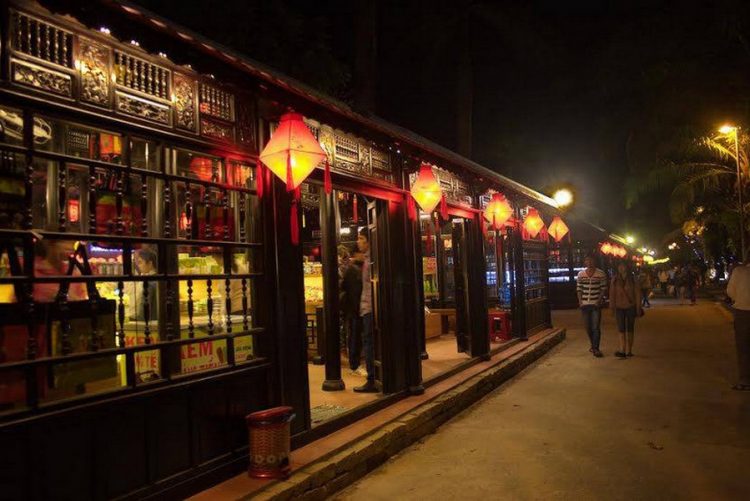
Located on the Nguyen Dinh Chieu walking street, Hue Night Market has busy, the animated atmosphere which is completely contrasted to the tranquility of Hue in the daylight. Hue Night Market often opens from 17:00 to 23:00. Hue Night Market has more than 122 stands divided into three sections including traditional handicrafts, consumer goods, and cuisine.
Visiting Hue Night Market, you will amaze at a variety of sophisticated handicraft, eye-catching souvenir, and lovely decorative items. In addition, Hue Night Market is the perfect places to enjoy tasty local cuisines such as com hen (mussel rice), bun bo hue (Hue beef noodle), and banh la (leaves cake). Hue Night Market is also a place where most quintessence products of Thua Thien Hue Province gather including Phu Cam conical hat, Ke Mon jewelry, Song Hy sesame candy, Truoi berry and lotus seed of Tinh Tam Lake.
6. Watch the amazing Ao Dai Show

A stunning show for those who love Hue and wish to see into the soul of Hue can find in the Ao Dai Show. This show features the recreation of The Nguyen Dynasty’s practices, wonderful dance performances such as Hue Royal Show, Cup Dance, Royal Paper Fan Dance, and Lotus Dance, Traditional Martial Art with sword fight performed by professional artists, and a variety of Vietnamese traditional costumes such as Ao dai and royal garments. A royal performance for you and family to immerse in the aesthetic space of precious legacy from the Nguyen Dynasty and get to know more about the history of Vietnam. A royal performance for you and family to immerse in the aesthetic space of precious legacy from the Nguyen Dynasty and get to know more about the history of Vietnam.
Do not miss and book Ao Dai show here .
What to eat in Hue
1. mussel rice (com hen) – the low-priced specialty of hue.
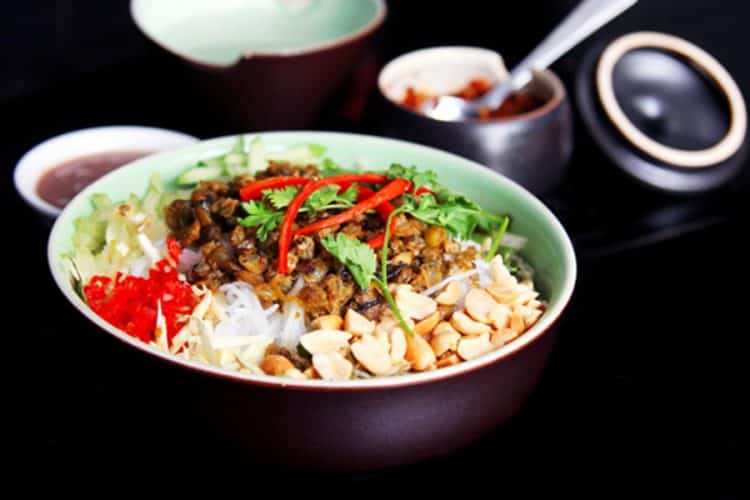
Com hen is a low-priced specialty you must try when visiting Hue. Made from river mussel, rice together with more than 13 different raw materials, com hen has a combined flavor including sweet, buttery, salty, sour, bitter and spicy flavors. To make com hen, firstly people soak fresh river mussel in rice water for a long time to remove impurities. Then, they boil mussels until they open their mouth. After that, gently scrape the meat off the shell. Mussel meat is fried with oil, dried bamboo shoot, rice vermicelli, white sesame, chili sauce and fish sauce. Fried mussels are put on the top of the bow of rice with peanut, salted shredded meat, fried pork rind. Com hen is served with a lot of fresh vegetable including banana flower, banana trunk, spicy vegetables, peppermint, and salads.
Where to eat com hen
Hoa Dong Restaurant Address: No. 64, Kiet 7 Ung Binh, Con Hen, Hue City Price: VND 8,000 – VND 20,000 Open: 06:30 – Close: 20:00
Bun, Chao, Com Hen Restaurant Address: No. 98, Nguyen Hue, Hue City Price: VND 10,000 – VND 22,000 Open: 07:00 – Close: 22:00
Tam Phuc Restaurant Address: Kiet 7 Ung Binh, Con Hen, Hue City Price: VND 15,000 – VND 33,000 Open: 07:00 – Close: 22:00
2. Hue Beef Noodle Soup – Bun Bo Hue

It’s no doubt that bun bo Hue is a key factor contributing to the golden reputation of Hue. Bun Bo Hue now appears in almost all regions of Vietnam, but its tastes vary a bit. Bun Bo Hue is greatly admired for its balance of spicy, sour, salty and sweet and the predominant flavors.
The consommé is made by simmering beef bone. Then, it is seasoned with fermented shrimp sauce, sugar, and spicy chili oil to enhance the flavor. A bow of Bun Bo Hue includes soft rice vermicelli (bun), some slices of medium beef, chunks of oxtail, boiled beef shank and two or three small cubs of congealed beef blood. Bun Bo Hue is often served with lime wedges, cilantro sprigs, spring onion s, raw sliced onions, chili sauce, banana flower, banana trunk, red cabbage, mint, basil, perilla, and Vietnamese coriander (rau răm).
Where to eat bun bo Hue
Bun Bo Hue O Cuong Chu Diep (Mrs. Cuong & Mr. Diep) Address: No. 06 Tran Thuc Nhan Street Price: VND 15,000 – VND 30,000 Open: 06:30 – Close: 11:00
Bun Bo Mrs. Phung (Bun Bo Mr. Vong) Address: No. 05 Nguyen Du Street Price: VND 20,000 – VND 45,000 Open: 15:00 – Close: 18:00
Cam Restaurant Address: No. 38 Tran Cao Van Street Price: VND 20,000 – VND 40,000 Open: 06:00 – Close: 10:00
3. Sweet Soup (Chè Huế) – The best street food in Hue

Chè Huế is a specialty appearing in every corner of Hue. Chè Huế, sometimes misunderstood as tea, is actually a sweet dessert with more than 36 types of different ingredients, colors, forms, and tastes. Chè Huế is often made by simmering red beans, green bean, black eye peas, lotus seeds, coconut milk together with many types of fruit.
Some popular types of Chè Huế are che bap (corn sweet soup), che hat sen (lotus seed), che troi nuoc (sticky rice ball and green pea paste), che khoai mon (taro), che buoi (grapefruit) and che dau do (red kidney bean). Despite many types, Chè Huế is divided into 2 main kinds: the royal sweet soup and alley sweet soup. Both kinds are scrumptious, gently sweet and have a good smell, which makes you can’t stop eating.
Where to eat chè Huế
Chè Huế Ngoc Hien Address: No. 65 Tran Hung Dao Street Price: VND 8,000 – VND 10,000 Open: 15:00 – Close: 21:300
Chè Huế Mr. Lac Address: No. 36 Thanh Tinh Street, Vi Da Ward Price: VND 5,000 – VND 11,000 Open: 12:30 – Close: 11:00
Che Mo Ton Dich Address: Opposite to Thuong Bac Park Price: VND 8,000 – VND 20,000 Open: 17:00 – Close: 22:00
3. Hue Royal Cuisine – The unique characteristics of the ancient capital

Royal Cuisine of Hue receives the golden fame for its sophistication and refinement. Hue Royal Cuisine is unique not only due to the delicate culinary process but also thanks to the sophisticated presentation that makes it look like an artwork.Enjoying Hue Royal Cuisine while immersing into the charming melody of Nha Nhac will be the unforgettable experience for many visitors.
_____Ton Nu Thi Ha (Hue Culinary Artisan) _____
Where to eat Hue Royal Cuisine
Royal Park Restaurant Address: No. 03 Nguyen Sinh Sac Street, Vi Da Ward Tel: (+84)-234-389-7202 Hotline: (+84) 913-492-356 Email: [email protected] Website: www.royalpark.com.vn Price: VND 550,000 – VND 1,100,000 Open: 07:00 – Close: 23:00
Where to live in Hue
Hue has a plethora of resorts, hotels, homestays, and hostels to choose from, along with the benefit of low prices garnering fairly high value. Compared to the rest of Vietnam, you’ll find accommodation priced slightly lower, while still maintaining excellent service, location, and amenities, regardless of hotel class.
1. Hue hotels
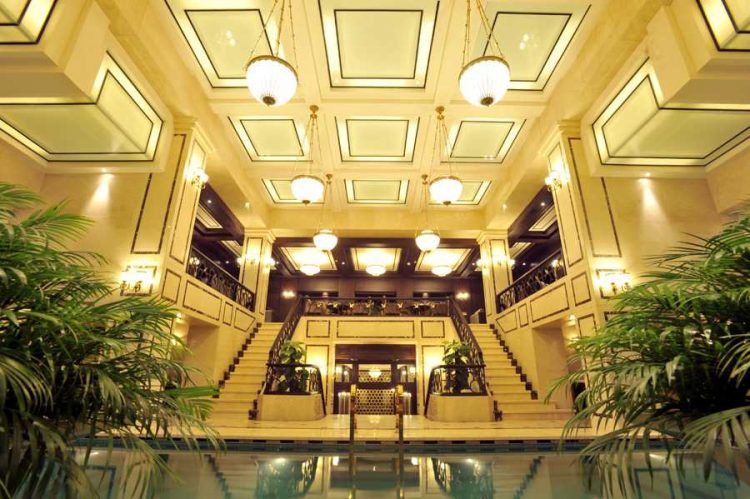
The most popular choice that most of tourists visiting Hue consider is staying at the hotel in city center. The center of Hue is small and most of hotels are located nearby on Le Loi Street, Nguyen Cong Tru Street, Vo Thi Sau Street, Nguyen Thai Hoc, and Ben Nghe Street south of Perfume River, which is called the backpacker area. This area is quite convenient as you can travel to various tourist attractions from there. Crossing the Trang Tien Bridge to see the Citadel and Dong Ba Market on foot is also easy.
This area in the center of Hue is where most of 2-star and 3-star hotels are located so room prices here are really reasonable. And of course, if you prefer, you can find a 4-star or 5-star hotel to ensure the most comfortable stay.
Recommended Hue hotels in a really convenient location: Amigo Hotel , Hue Garden Villa Hotel , Hotel Saigon Morin , Moonlight Hotel Hue , Eldora Hotel , Indochine Palace , Imperial Hotel Hue
2. Hue resorts
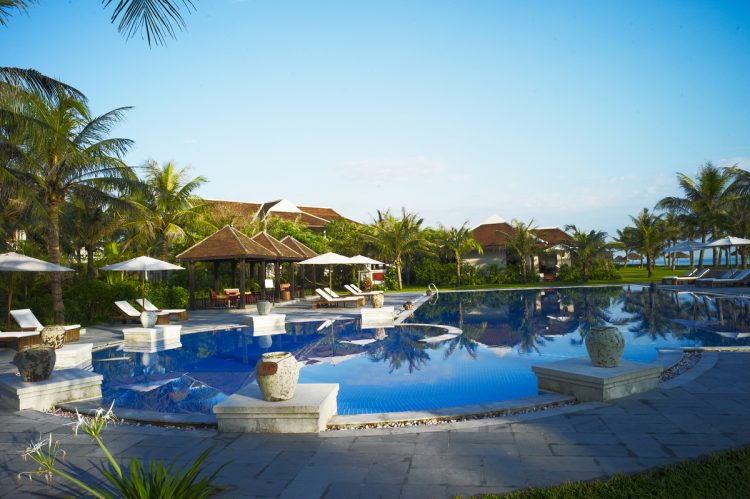
If the purpose of your trip is relaxing in the beautiful nature and enjoying the peaceful atmosphere, then staying at one of the resorts in Hue would be a perfect choice. There are plenty of quiet and enticing beaches nearby the city, including Thuan An and Lang Co. However, the room rates at high-class resorts in Hue are relatively high. These resorts are the place for your dream vacation in the ancient tropical paradise.
Some of the best resorts in Hue: Angsana Lang Co , Banyan Tree Lang Co , Vedana Lagoon Resort & Spa
3. Hue homestays
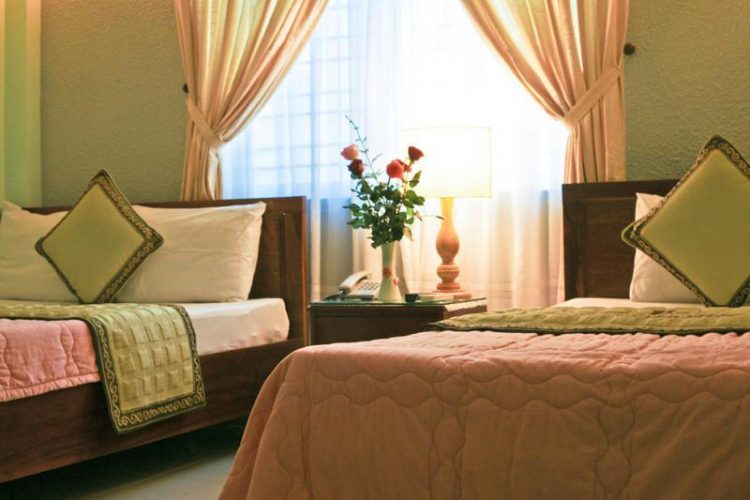
Homestays are popular in Hue because they are run by locals. Homestays in Hue meet the needs of travelers, offering a good service at affordable prices with friendly local people. Unlike the traditional homestay in other places, which must be shared with the host, most of homestays in Hue allow tourists to enjoy private space as they are like apartments separated from the owner.
Staying at a homestay in Hue is a good option for those who love history and culture. You will feel that the customs and lifestyle of the Hue people are still retained and handed down in these homestays. Typically, a standard homestay also has a nice small garden, so you can feel like being at home.
Homestays in Hue are very affordable. For the room rate from VND 200,000-350,000 per night, you can stay in a very nice and lovely space right in the heart of Hue City.
Some of the best Hue-style homestays: Citadel Homestay , Eva Homestay , Hue Sweethouse 2 Homestay
4. Hue hostels

There are a number of cheap and good hostels in Hue. Room prices are suitable for those who are traveling on a budget or just want to explore Hue and don’t care much about comfort of their stay. If you don’t mind much about the location, check for hostels in Vi Da Street or Nguyen Sinh Cung. Hostel room rates are usually around VND 200,000-250,000 per night.
Some of the best budget hostels in Hue: Shark Hostel , Amy Hostel Hue , DMZ Hostel Hue
Must-know tips when traveling to Hue
- When traveling by cyclo, remember to ask clearly whether the price covering the return trip before setting off.
- Take it into consideration when scrolling around Le Loi Street. This street is the center of expensive hotels, clubs, and shops. Almost all things have higher prices on this street due to its high renting fee.
- Be careful with some tourism operators who offer you to watch Nha Nhac or ca hue at a low price. The quality of this performance is quite poor.
YOU MAY ALSO LIKE

How to Spend 1 Day in Da Nang

How to Spend 2 Days in Da Nang

How to Spend 3 Days in Da Nang

Your Rough Guide to Hoi An

Cham Island: A Paradise for Divers and Much More

An Exciting Adventure to the My Son Sanctuary
__hanoi-water-puppets.jpg)
- Grand Tours Vietnam
- Halong bay and Cat Ba island
- Hanoi & Around
- Sapa & Northern Highland
- Central Coastline
- Saigon & Around
- Mekong Delta
__angkor-wat-blue-reflections.jpg)
- Grand Tours Cambodia
- Around Angkor & Siem Reap
- Around Phnom Penh & the Coast
__vientiane-buddha-park-monks.jpg)
- Grand Tours Laos
- Luang Prabang & the North
- Vientiane & the South
__bagan-dhammayazika-dusk.jpg)
- Grand Tours Myanmar
- Myanmar beach holiday
- Tour finder
- Local Pioneers
- Why Responsible Travel matters
- Making all tourism more sustainable
- Our role as a DMO
- Certification
- Our projects
- Mindful Travel Tips
- Refill Hanoi Info
- Refill Hanoi Map
- Trip Report
Everything you need to know before you go to Hue imperial city - Updated in 2020
- Sapa and Bac Ha
- Cat Ba Island
- North East Vietnam
- Ninh Binh and Tam Coc
- Hoian and Da Nang
- Quy Nhon and Nha Trang
- Mui Ne - Ho Tram- Vung Tau
- Ho Chi Minh City
- Phu Quoc and Con Dao island
- Dalat and Centre Highlands
- National Parks
- Wellness retreat
- Ly Son Island
- Family Travel
Hue imperial city is one of the most well-known destinations in the center of Vietnam. This destination attracts tourists by the historical and cultural values, as well as the charming natural landscapes. Let’s travel to Hue with Handspan Travel Indochina !

In this article, you can find some useful pieces of information below.
- General information about Hue imperial city
- How to get to Hue imperial city
- The best time to visit Hue
Attractions to visit in Hue imperial city
- Specialties in Hue imperial city
- Accommodations in Hue imperial city
General information about Hue imperial city
Regarding historical aspects, Hue was a capital city of the Nguyen Dynasty dating back from 1805 till 1945. The ancient capital is a home of many temples, pagodas, tombs, and palaces with impressive architectural styles. There’s a mistake if you don’t mention the Imperial City that is the walled citadel and royal palaces when traveling to Hue. The Imperial City served as a venue for significant court ceremonies, forebear worship, and the royal family’s residence. With a profound value of history, culture, and architecture, the Imperial City is officially recognized as a World Heritage Site by UNESCO.
Additionally, the tombs in which the Emperors’ mummy under the Nguyen Dynasty stored now are opened for sightseeing. Therefore, these tombs have magnificent architectural designs that make a deep impression on tourists’ minds. Amongst seven royal tombs, Minh Mang, Tu Duc, and Khai Dinh tombs are famous tombs. Moreover, another destination recommended for tourists is Thien Mu pagoda - the oldest and the most magnificent religious monument in Hue.
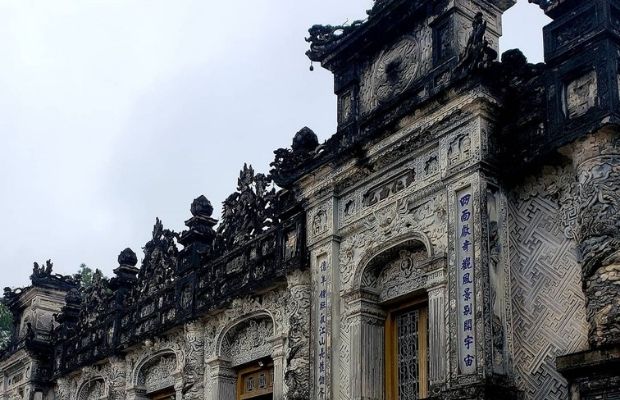
Khai Dinh Tomb
The ancient capital is also well-known for its sophisticated cuisine, which helps enrich Vietnamese culinary art. Several Hue specialties are mussel rice, Hue beef noodle soup, etc. which are worth tasting. Besides, Hue imperial city is considered as a festival city. As being first organized since 2000, festivals have been particular cultural affairs for residents. With local and foreign artists’ participation, festive activities have resuscitated many Vietnamese antique capital values. Visiting the main attractions in Hue and savoring many specialties here will bring you lots of memorable experiences.
How to get to Hue imperial city
By plane .
As a large city in the central part of Vietnam, Hue has Phu Bai airport helping communes become more convenient. For those who want to save time, the fastest way to travel is by plane. You will take a flight from 2 big cities, including Hanoi and Ho Chi Minh to travel to Hue imperial city.
- From Hanoi: Two airlines, including VietjetAir and Vietnam Airlines, have flight routes to Hue. It takes around 1 hour to get to Hue.
- From Ho Chi Minh: VietjetAir, Vietnam Airlines, and Jetstar have flight routes to Hue, with about 30 minutes for you to get to Hue.
Phu Bai Airport is 15km far from the city, and there are two ways to get to the center. Firstly, you can take a taxi, about VND 250.000 if you want to save time. If your luggage isn’t too heavy and you want to save money, choosing a shuttle bus is a smart choice. The price is about VND 50.000/one way/person.
By train
Taking a train is an exciting way for those spending more time contemplating natural beauty along the road. You can take a train to Hue imperial city from Hanoi and Ho Chi Minh city. Each day from Hanoi and Ho Chi Minh stations, there are five trains to get to Hue. You can choose a suitable train depending on your schedule as below information. It takes around 14 hours from Hanoi - Hue; 18 hours and 22 hours from HCM - Hue.
Besides the Thong Nhat train, there is SE18 to arrive at Danang from Hanoi and reach Hue at 10h00. If you visit Hue from Danang by train, it saves a lot of time and money within 3 hours, and the ticket fee ranges from VND 50.000 - 120.000/one way/person.
- SE1 & SE2 [Hanoi 19h30 - Hue 8h50] & [HCM 19h30 - Hue 15h25]
- SE3 & SE4 [Hanoi 22h00 - Hue 10h30] & [HCM 22h00 - Hue 16h40
- SE5 & SE6 [Hanoi 9h00 – Hue 22h42] & [HCM 22h00 – Hue 5h31]
- SE7 & SE8 [Hanoi 6h00 - Hue 19h47] & [HCM 6h00 - Hue 1h30]
- TN1 & TN2 [Hanoi 13h10 - Hue 3h40] & [HCM 13h10 - Hue 12h06]
By road
From Hanoi and Ho Chi Minh, there are many high-quality coaches taking you to go to Hue every day. The time is about 12 - 16 hours (from Hanoi) and 20 - 24 hours (from Ho Chi Minh).
- From Hanoi, there are some coach-providers like Hoang Long, Camel Travel, and The Sinh Tourist. Price ranges from VND 250.000 – 350.000/one way/person.
- From Ho Chi Minh, some coach-providers are Tam Minh Phuong, Minh Duc, Hoang Long, and Huong Ty. Price range from VND 400.000 - 600.000/one way/person.
- If you go to Hue from Danang, there are many choices like The Sinh Tourist, HAV Limousine, Huetourist, etc. Prices are about VND 80.000 - 180.000/one way/person.
You can read on How to get to Hue from Hanoi, How to get to Hue from Ho Chi Minh.
Different transportations at Hue imperial city
- Cyclo
Cyclo in Hue is quite convenient; it can carry goods or people, especially tourists. It is now the most common and suitable means of transportation for tourists to go around Hue imperial city. Taking a cyclo helps you have more time to discover and contemplate the ancient capital’s romantic beauty. Check out the best cycling routes in Hue that you might know for your trip.
- Bicycle/Motorbike
Travelers can easily find a bicycle or a motorbike for transporting around Hue imperial city at a reasonable price. Places for renting bikes lie in Hung Vuong, Le Loi, near Truong Tien bridge, Pham Ngu Lao, Western street, etc. With a map and a bike, the journey becomes more exciting and economical for travelers, especially adventure-seekers and youngsters.
If you aren’t good at reading maps or sometimes the weather isn’t favorable, taking a taxi is smart. There are some common taxi brands in Hue, such as Dong Ba (Tel: 0234.3.84.84.84), Mai Linh (Tel: 0234.3.89.89.89), Phu Xuan (Tel: 0234.3.87.87.87), etc.
- Private car
If you are traveling with a large group of people or your family with kids, renting a private car is perfect. You can choose anywhere to go or to stop at any time you want during your trip. The renting fee is about VND 500.000 - 900.000/per day.
The best time to visit Hue
There are two main seasons in Hue weather, including dry season and rainy season.
The dry season is usually from March to August, the temperature up to 35 Celcius to 40 Celcius degrees, so it’s pretty scorching and hot. However, from August to January, the temperature reduces sharply, from 18 Celcius to 20 Celcius degrees, sometimes lower than 10 Celcius degrees. The blood season is from October. Spring in Hue lasts from the end of January until the end of February. The weather in spring is cool, sometimes a bit cold, and beautiful with rays of sunlight through leaf canopies.
Tourists travel to Hue imperial city in different periods during the year. Domestic guests typically go to Hue from May to the end of September, while from October to the end of April, many foreigners choose to visit Hue. The best time for you to visit Hue imperial city is from September to November.
Besides, you can visit Hue in other periods. In March, the weather in Hue is quite cool, and precious little rain. Moreover, at the end of April, especially the 30th April occasion, Hue holds many festivals with impressive cultural activities. There is also an international firework festival organized in Danang during this time.
The Imperial City
- Time for sightseeing: From 6:30 - 17:30 (In the summer) and From 7:00 - 17:00 (In the winter)
- Price: VND 150.000/person
The Imperial City is a historical place that tourists must visit when traveling to Hue. Being the Nguyen Dynasty’s ancient capital for 143 years, Hue imperial city is recognized as a World Heritage Site by UNESCO. With an area of 520 ha, Hue imperial city is divided into two regions. They are places for residents and mandarins living and the Imperial Citadel for the Emperors and nobles living. The Imperial Citadel is the second citadel in which the Kings and mandarins worked under the Nguyen Dynasty. The last defense is Forbidden City, including many palaces where the Kings and royal families live. It took a long period to complete complex and sophisticated architectures inside the Imperial Citadel.

Hue Imperial Citadel
There are some critical architectural landmarks here:
- The Meridian Gate
As the main gate of the Imperial Citadel, Meridian Gate is for the Emperors to welcome the ambassadors. Built under Minh Mang King, Meridian Gate is a place to organize many events and significant ceremonies. Indeed, in 1945 Bao Dai King read the Abdication Declaration here.
- Hue Flag Tower
Hue Flag Tower, located in the northern citadel, is where the dynasty hangs the flag.
- Thai Hoa Palace
Considered as the power symbol of the Nguyen Dynasty, the Thai Hoa palace is organizing many essential rituals. Many significant events are the coronation ceremony, welcoming the ambassadors, and imperial courts two times a month.
- Temple of Literature - Thua Thien Hue Historical Museum
It plays as a university during feudal times. Under the Nguyen Dynasty, the Temple of Literature in Hue became the only university of Vietnam where many talented people studied. Nowadays, it has become Thua Thien Hue Historical Museum storing historic items through many stages, especially the revolution in Hue.
- Time for sightseeing: Morning: 7:30 - 11:00 & Afternoon: 13:30 - 17:00
- Ticket fee: VND 30.000/person
- Long An Palace - Hue Royal Antiquities Museum
Built as a place for relaxing and reading by Thien Tri King, Long An Palace becomes Hue Royal Antiquities Museum. This place stores items of palaces, which brings a close look into kings and royal families’ lives.
- Time for sightseeing: 7:00 - 17:00 every day (Closed on Monday)
- Ticket fee for visiting Imperial City and museums: VND 150.000/person.
Thien Mu Pagoda

Thien Mu Pagoda
With its natural beauty lying on Ha Khe Hill, Thien Mu Pagoda becomes an iconic Hue imperial city’s iconic image. Built-in 1601 by the first King under the Nguyen Dynasty - Nguyen Hoang, it was the most large-scale pagoda. Visiting Thien Mu Pagoda, you will see the magnificent Phuoc Duyen tower and listen to the unique sound of two-time ringtones every day (13:00 and 19:30). Each time hits continuously 108 chimes, making it very special.
Time for sightseeing: 7:00 - 17:00 every day.
Huong River
Stretching along Hue imperial city is a peaceful and twisty Huong River. As being an iconic symbol of the city, you can contemplate its marvelous beauty from many places. That can be an exceptional view from Thien Mu Pagoda, taking a dragon boat, etc. Each experience brings a specific image of the river.
Trang Tien Bridge
Being a symbol of Hue imperial city, the Trang Tien Bridge crossing over the Huong River is the pride of local people. If you have a chance to visit Hue, please don’t miss to explore the most beautiful moment of the bridge. The flamboyant red trees blossoming along the road bring a tranquil and romantic scene for the passer-by.

Huong River and Trang Tien Bridge
Dong Ba Market
Dong Ba is the most famous larger-scale market in Hue imperial city but in central Vietnam. You can find everything at Dong Ba market like food, daily supplies, especially Hue specialties, etc.
Tombs
Tombs of the Kings under the Nguyen Dynasty is a place you can’t miss during your trip. There are seven tombs in total amongst the 13 Kings of this dynasty. Each of them has a unique architectural style, along with Eastern feng shui, and carries the King’s specific characteristics. That contributes to the unusual excellence of the tombs.

Tu Duc Tomb
Time for sightseeing: 7:00 - 17:00 everyday
- Ticket fee: VND 100.000/ticket (Minh Mang, Tu Duc, Khai Dinh) - VND 40.000/ticket (Gia Long, Thieu Tri, Dong Khanh)
Thuan An Beach
As a small beach near Hue, Thuan An beach is ideal for beach-lovers yet not want to go far. Thuan An beach, which stretches over one kilometer, makes a great impression on stunning sunsets and sunrise landscapes. Just standing on the seashore, you can feel the fresh air and clear crystal water running through your feet.
Lang Co Gulf
Lang Co is a perfect choice if you’re looking for a serene space amongst high mountains and pristine beaches. You can immerse yourself in clear water and curving white-sandy beaches covered by Hai Van pass when coming here. Lang Co is renowned as one of the most beautiful gulfs in the world. You will have an excellent chance to relax after many days of working hard and stay away from bustling city life.
Tam Giang Lagoon
As being the largest lagoon in Southeast Asia, Tam Giang Lagoon, along with the Thai Duong Ha fishing village, becomes an isolated oasis in marvelous nature landscapes. Besides magnificent nature, you can explore the daily life of local people in the fishing village. The life here is pretty lively in the morning, yet sometimes peaceful. Tam Giang Lagoon is also one of the best places in Hue imperial city for tourists to enjoy the sunset.

Tam Giang Lagoon
Specialties in Hue imperial city
Hue beef noodles
The first specialty that you have to try is Hue beef noodles, Hue imperial city's icon. The authentic beef noodles in Hue must be different from the remixable beef noodles of somewhere along Vietnam. The ingredients include vermicelli, spacy broth as the favor of Hue people with pork-pie, and some fresh herbs. It makes delicious and authentic Hue beef noodles.
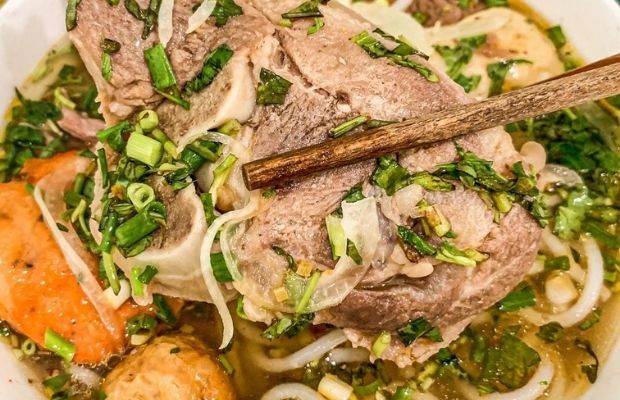
Hue beef noodles
Addresses suggested:
- No. 17 Ly Thuong Kiet, Hue.
- Tuyet Madam Eatery: No. 47 Nguyen Cong Tru, Hue
- Me Keo Eatery: No. 20 Bach Dang, Hue.
Mussel Rice
The next dish you must try to eat in Hue is mussel rice. It’s a typical dish here that you can see in many eateries in the street. You can enjoy a piece of tough and good mussel meat fried with fancy spices with white rice and pork rind. Besides, it is served with Hue shrimp paste, making it a perfect dish that satisfies any taste.
Addresses suggested:
- Nho Eatery: No. 28 Pham Hong Thai, Hue.
- Eateries at Con Hen, Vi Da Ward, Hue.
Various Hue cakes
Cakes in Hue are very famous such as “Banh beo” (bloating fern-shaped cakes), “Banh bot loc” (dumplings), “Banh it” (“naked” small stuffed glutinous rice flour balls, and “banh nam” (flat rice flour dumpling from Hue). Those kinds of cakes are made from simple ingredients but have a great attraction to tourists. They become a favorite dish for both local people and tourists at any time.
- Ba Do Eatery: No. 08 Nguyen Binh Khiem, Hue
- No. 109 Le Huan
- Food stalls at Tay Loc Market, Dong Ba Market
Sweet soups
Sweet soups seem to be nosh dishes of cuisines of different parts of Vietnam. You can easily see many sweet soup stalls in any street of Hue. A glass of delicious sweet soup with various flavors satisfies your bud of taste. There are many well-known sweet soups such as corn, grilled pork wrapped in cassava flour, taro paste, etc.
Address suggested:
- Che Ngoc Hien at No. 65 Tran Hung Dao, Hue
- Che Thanh at No. 78 Mai Thuc Loan, Phu Hau Ward, Hue
- Che Mo Ton Dich in front of Thuong Bac Park, Hue
Hue sour shrimp paste
Hue people always have an everlasting passion for “mắm,” a macerated fish or shrimp sauce. Amongst them, one of the most favorite spices by many tourists is sour shrimp paste. The unique thing here is that fresh shrimp merged into white wine, which gradually turns dark red. The sour shrimp paste tastes best when served with boiled-pork, rice paper, and fresh herbs.
Address suggested: Tom chua To Viet at No. 95 Chi Lang, Hue.
Nam Pho Bread Soup
The bread soup is not strange to local people, but it has a unique Nam Pho village flavor. A bowl of flavored dressing, served full of crabs and shrimps, satisfies every food lover.
- Quan Thuy at No. 16 Pham Hong Thai
- Quan O Thu at No. 374 Chi Lang
Accommodations in Hue Imperial City
Recently, accommodations in Hue have grown rapidly from homestays, hotels to luxurious resorts. Read on the lists of accommodations below for your memorable journey in Hue.
Homestay Mosaic Garden
- Address: Van Duong Village, Thuy Van Ward, Huong Thuy Town, Hue
- Price from VND 200.000 - 500.000/person/night
Homestay Mosaic Garden is an accommodation designed as modern and simple architectures, bringing tranquility and close-nature for living spaces. The contemporary architectural styles bring the harmony of colors for the house. You can enjoy authentic Hue dishes made by the owner.
EMT Homestay
- Address: No. 33 Nguyen Truong To, Phuoc Vinh, Hue.
- Price from VND 350.000/person/night
EMT homestay satisfies guests with its peace and the harmony with the living space of local people. The bonus point is that EMT homestay is very close to many famous attractions such as Bao Quoc Pagoda, Hue Imperial City, etc. With the reasonable price, the homestay is ideal for groups of friends and families to relax. You can feel like your home is full of furniture, comfortable, and excellent service compared to Hue’s luxurious hotels.
EMM Hotel Hue
Lying in Hue imperial city center, EMM Hotel is worth staying in for its modern design and fully-furnished rooms. All rooms are well-equipped with air-conditioners, bath-tub, TV, and a private balcony, along with 24/24 services. Especially, Spice Viet is one of the best restaurants for you to enjoy authentic Hue specialties.
- Address: No. 15 Ly Thuong Kiet, Hue
- Price from VND 900.000 - 3.400.000/room/night
Alba Spa Hotel Hue
Nestled in the heart of Hue, Alba Spa Hotel is a peaceful accommodation for your mind, body, and soul. With its modern facilities and excellent services, Alba offers a distinctive spa hotel concept and health-care benefits for guests. Staying at Alba Spa Hotel brings you comfort and relaxation during the time in Hue, the imperial city. Furthermore, it’s home to the most significant hot and cold jacuzzi in Vietnam, promising to bring wonderful experiences. If you’re looking for an authentic cuisine experience, Madame Chau Restaurant, here is a perfect choice for you to discover local and foreign gastronomies.
- Address: No. 29 Tran Quang Khai, Phu Hoi, Hue.
- Price from VND 800.000 - 1.700.000/room/night
Pilgrimage Village Resort & Spa Hue
- Address: No. 130 Minh Mang, Thuy Xuan, Hue.
- Price from VND 1.500.000/room/night.
With the harmonious combination of traditional and conventional design, Pilgrimage Village has become a perfect resort for you to stay. Pilgrimage Village resort features 99 rooms, three restaurants, 4 bars, one spa, and other sports services. Besides, you can see specific Hue traditional cultures through exciting activities here. So Pilgrimage Village is considered one of the best resorts offering fully-furnished rooms, good cuisines, and excellent services.
Vedana Lagoon Resort & Spa Hue
- Address: Zone 1 Phu Loc, Hue
- Price from VND 1.000.000 - 3.300.000/room/night
Vedana Lagoon Resort carries modern architectural design, accompanied with traditional decorations. Staying at Vedana Resort, you can enjoy various therapy treatments and beauty spa. Besides, some healthcare classes are organized daily for tourists to join, such as Tai Chi and Yoga. You can find everything in one place, from luxurious rooms to various health-care services and water sports. So Vedana Lagoon is one of the best resorts in Hue that is highly recommended by tourists.
The other experience to discover Hue imperial city
- In peak seasons of tourism in Hue, like festivals, the number of tourists visiting this city increases. That leads to hotel rooms in Hue fall into overloading. Do not forget to book hotels in advance to make sure you have a suitable place to stay.
- There are some specialties in Hue that you can buy as a souvenir, such as a poem conical hats, fermented pork roll, sesame candy, etc.
- The complex of Hue Imperial City has a large area, so you’d determine which destinations you want to go to first. It can help you to save time and energy.
- If your taste isn’t too spicy, you should talk to the cook before eating something.
- Before using tourism services, shopping, and eating, you have to make sure you get the price first.
- Hue imperial city
The most viewed videos
- Traditions & Customs in Vietnam
- Low season .Vs. High season. Everything you need to know
- Sapa through each season - What is the best time to visit Sapa?
- 10 things to do in Vietnam before Têt, the Lunar New Year
- New luxury train between Hanoi and Ho Chi Minh City
You might also enjoy
- Chol Chnam Thmay Festival in Cambodia - A unique festival of the Khmer People
- Celebrating culture and community: Bunpimay Festival in Laos - Handspan Travel Indochina
- Exploring the top 09 amazing ecotourism sites in Vietnam - Handspan Travel Indochina
- Exploring the unique culture in the Mekong Delta region of Vietnam - Handspan Travel Indochina
- Exploring Xeo Quyt Relic, the hidden gem of Dong Thap - Handspan Travel Indochina
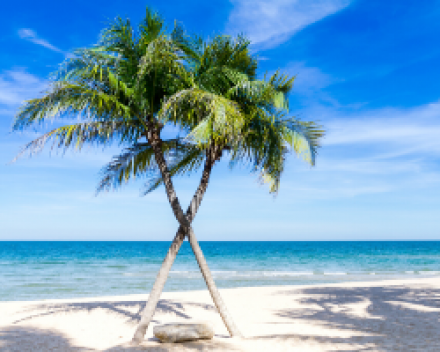
- Hanoi Head Office - 78 Ma May, Hanoi
- Phone: +84 24 3926 2828
- Fax: +84 24 3926 2792
- Email: [email protected]
- [Hot Line in English & Vietnamese only]
Skype Live Chat
- Annie, Nguyen (Mrs.)
- Huong, Nguyen (Mrs.)
Indochina highlights
- Cruise Halong bay
- Explore Angkor temples
- Experience Luang Prabang
- Discover Myanmar
- Booking terms and conditions
Location map
- Tour Package
- Responsible travel
- Tour catalog
- Customize a tour

Destinations
The hue citadel (hue imperial city).
Hue Imperial City (Hue Citadel) in Vietnam has been compared with the thousand-year-old wonders of humanity in the UNESCO World Cultural Heritage list. The Imperial City of Hue consists of a huge complex with hundreds of Vietnam War monuments and ruins. Travelers that enter Hue Citadel can see the Imperial City, Forbidden Purple City, king tombs, a library, and a museum, a flag tower, pagodas, and temples, all of which provide fascinating knowledge and experience.
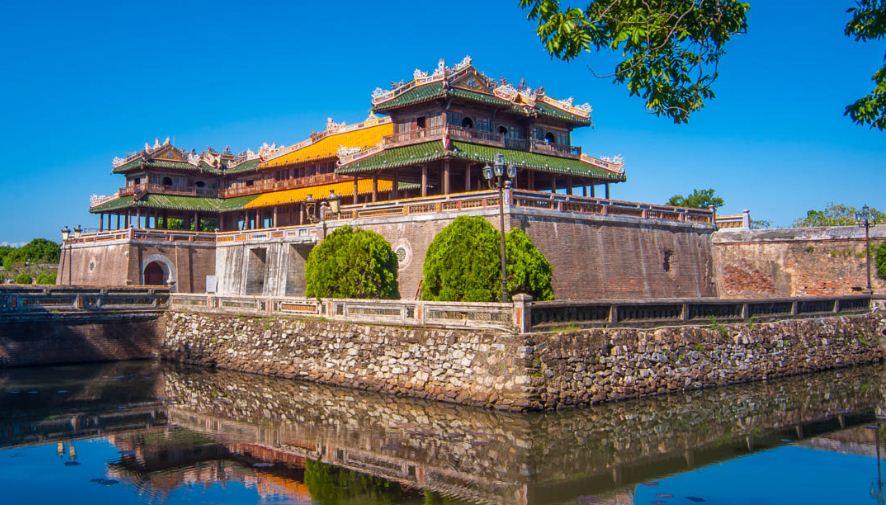
Gia Long, the king who established the Nguyen Dynasty, wanted to construct the magnificent edifice in 1803. Under Minh Mang's reign, the Hue Imperial City (Hue Citadel) was finally completed in 27 years, from 1805 to 1832, making it the most gigantic edifice ever erected in modern Vietnamese history, using thousands of employees, millions of cubic meters of rock, and a significant amount of onerous duty. With a total land area of 520 acres, the edifice is located on the northern bank of the Huong River , turning south. The site was designated as a UNESCO World Heritage Site in 1993, with the remaining structures being actively restored and protected following the Vietnam War's damage.
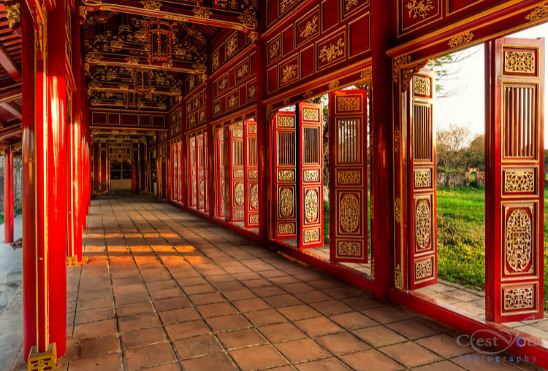
The Hue Imperial City spans a 10 kilometer-circle, a height of 6.6 meters, and a thickness of 21 meters, with forts placed in a meandering pattern, accompanied by cannons, artillery, and ammunition. Initially, the stronghold was constructed entirely of earth, which was later covered with bricks. The intricate canal system that surrounds the city serves not only as a protective barrier but also as a waterway with over seven kilometers of length.
Hue Imperial City is divided into two main portions, excluding dwellings and mansions, by ten beautiful gates: The Citadel and The Forbidden City. The former was used to safeguard the key palaces on the inside, while the latter was used to house the emperor and his family as well as the court. All of the ancient Eastern structures, such as stately palaces, tombs, and museums, are arranged in a pleasing manner to create an extremely entertaining attraction right in the center of Vietnam.
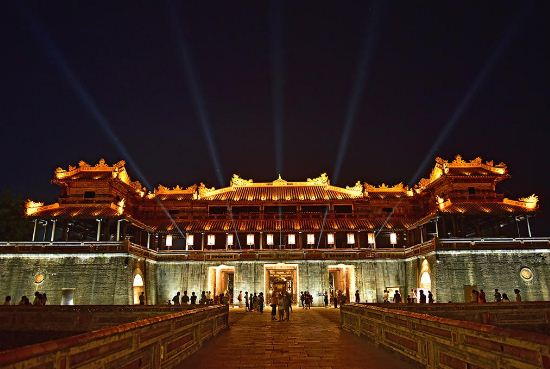
The Hue Imperial City is easily accessible. Head straight to 1A Highway from Phu Bai International Airport, and then you'll be standing next to a large gate heading inside, and all that's left for you to do is marvel at the majesty of Hue's Imperial City.
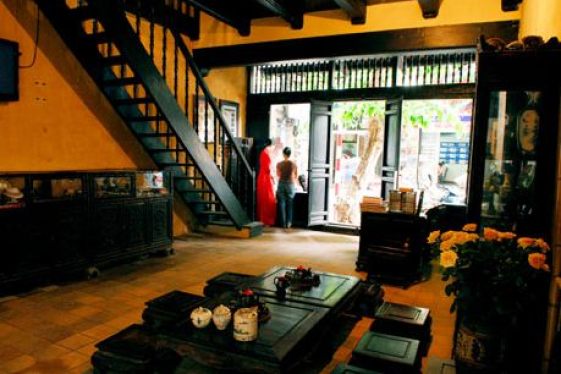
Hanoi Heritage Ancient House
Despite of being built in the late of the Twentieth century, the Hanoi Ancient House ( Heritage House ) is quite intact with typical architecture of ancient house.
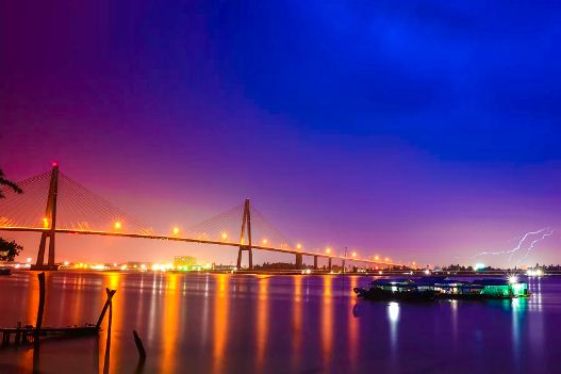
Rach Mieu Cable-Stayed Bridge
The Rach Mieu Bridge, which spans the Tien River and connects the provinces of Tien Giang ( My Tho ) and Ben Tre, is a cable-stayed bridge. This is the first...
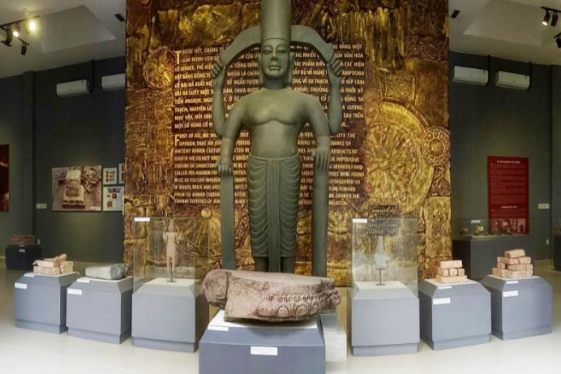
Oc Eo Archeologic Site
Oc Eo - Ba The archaeological site lies in Oc Eo town, Thoai Son district, An Giang province, in the southwest of Vietnam. Long Xuyen city, An Giang province, is 40...
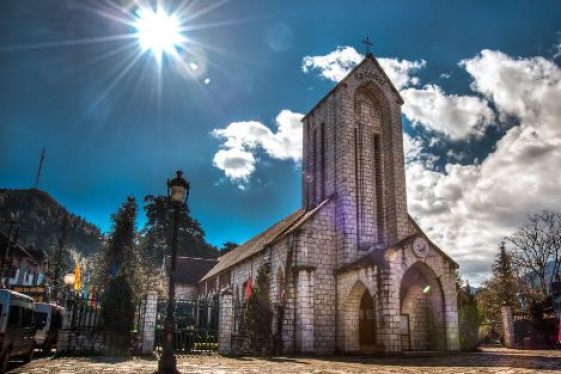
Church of Stone Sapa
Sapa Stone Church, also known as the Holy Rosary Church, is located in the middle of Sapa town and was built by the French in the early twentieth century. The French...
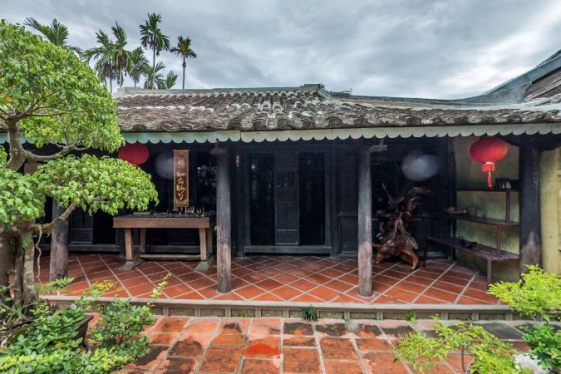
Phu Vinh Old Village
Phu Vinh ancient village is around 6 kilometers from Nha Trang city in Khanh Hoa province's Vinh Thanh commune. The community has been around for about 200 years, and...
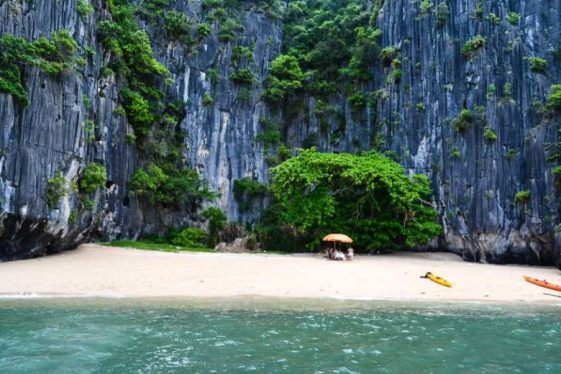
Cong Do Island in Bai Tu Long Bay
Cong Do Island lies inside Bai Tu Long Bay and is located in the southeast of Ha Long Bay, 13 sea miles from the Bai Chay cruise terminal. The island is 23 363 km2 in size...
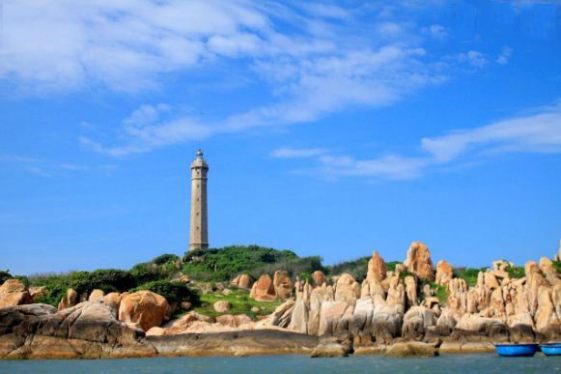
Hon Khoai (Potato Island)
Hon Khoai, Hon Sao, Hon Doi Moi, Hon Da Le, and Hon Tuong are the five islands that make up Hon Khoai in Cau Mau province, Mekong Delta. Hon Khoai is the largest of them all....
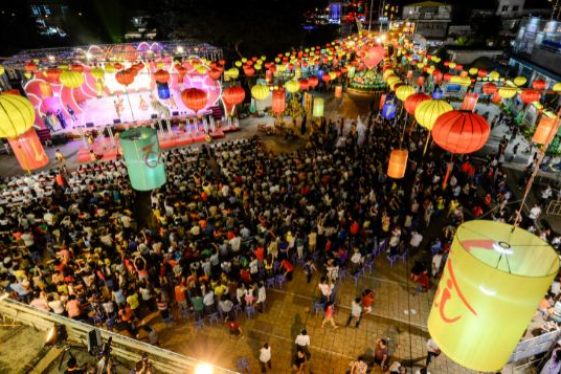
Chinatown of Saigon (Cho Lon)
Cho Lon in Ho Chi Minh City ( Saigon ) is Vietnam's largest Chinatown, with roots reaching back to 1778. It is also a historically and culturally significant...
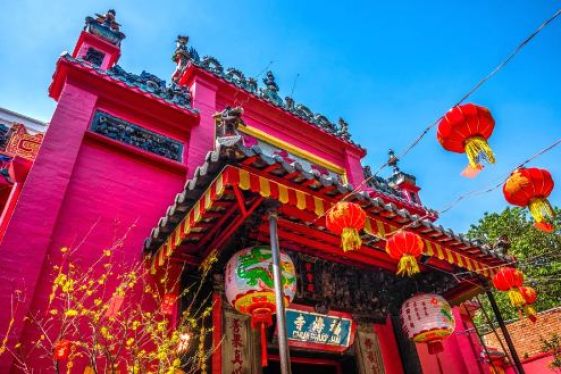
Jade Emperor Pagoda (or Tortoise Pagoda)
Dating back more than 100 years, the Emperor Jade Pagoda ( or Tortoise Pagoda ) is one of the five most important pagodas in Buddhist life in Ho Chi Minh City ( Saigon ).
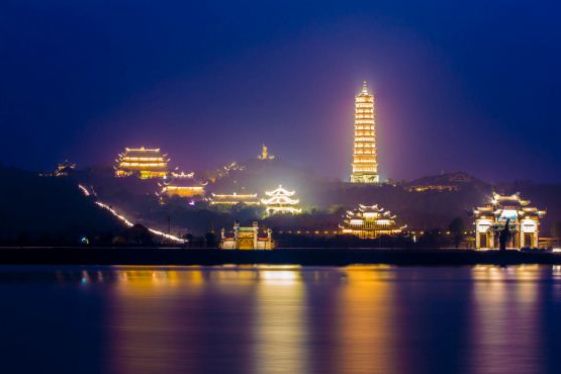
Bai Dinh Pagoda of Ninh Binh
Bai Dinh Pagoda is known for its enormous size and is a collection of Buddhist architectural monuments that include new, massive, and intimidating temples in the...
- Mekong Delta
- Ho Chi Minh City
Most popular tours

Vietnam Honeymoon In Romance
From: Contact
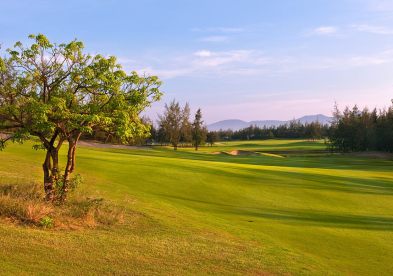
Ho Chi Minh – Danang Golf Package 5 Days
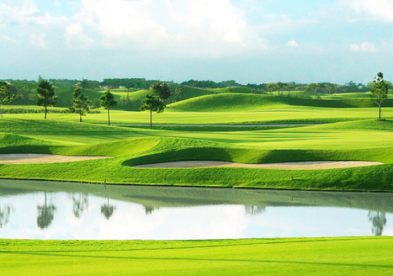
Nha Trang – Danang – Saigon Golf Week
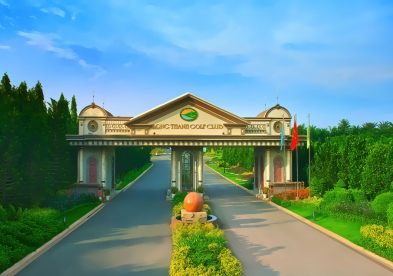
Ho Chi Minh Golf Package 4 Days
Viet leading travel, booking with confidence.
Join to get special offers & great promotions

- [email protected]
- +84349825119

- Terms and conditions
- Hanoi Tours
- Ninh Binh Tours
- Hoi An Tours
- Da Nang tours
- Phong Nha Cave Tours
- Southern Tours
- Package Tours
- Vietnam Shore Excursions
- Car Rental Tours
- Car Rental Full Day
- Vietnam Limousine
Hue Imperial City of the Nguyen Dynasty

Located in the center of Vietnam, Hue served as the capital of the Nguyen Dynasty from 1802 to 1945. This wonderful place comprises a lot of cultural monuments including palaces, temples, and tombs. Especially, Hue Imperial City ( Hue Citadel ), which is a UNESCO Heritage Site , has been one of the most outstanding structures that feudal palace lovers should not miss.
Table of Contents
1. Hue Citadel’s History
This Hue citadel complex was the place where the 9 Nguyen Lords and 13 Nguyen Dynasty Emperors chose to live and govern the country. To be accurate, in 1803, Emperor Gia Long himself examined the terrain to choose a suitable place to build this massive complex. In fact, it took 31 years to complete from 1802 to 1833.

Located on the North bank of the Perfume River, in the center of the city which is 10.000 m in circumference. Fascinatingly, based on geographic and Fengshui principles. The emperors constructed the Hue City Citadel facing the South and picked Ngu Binh mountain as the front screen.
Besides, the Emperor planned the architectural system in accordance with the well-proportioned principle. Moreover, surrounding the citadel of Hue, there is a total of 10 gates and a 7 km long moat for decoration, protection, and a natural air-conditioner as well.
2. Imperial City Hue Vietnam map
Please refer to Hue Imperial City map – Hue Citadel map below:
3. Hue citadel’s structure
Hue Citadel consists of an area of 500 ha and includes three ramparts. The first area is the Kinh Thanh Hue ( Hue Citadel ). In reality, Emperor Gia Long ordered builders to construct it in the year 1805. Regardless of the time and natural disasters, this building was stable with 140 huge constructions.
Specifically, it is 9 kilometers in circumference with 10 gates. Additionally, 24 bastions were set up on the top of the walls with defensive aims. The second area behind Noon Gate is the Royal City . As you know, it is considered the most crucial part of the citadel since this is the place to hold some grand ceremonies and put the shrines.
The working area of the Emperor and mandarins. Moreover, the meetings about internal affairs happened here as well. The last section is the Hue Forbidden City . It was built in 1803 to be the private residence of emperors, the royal family, and eunuchs.
At first, Gia Long named it Cung Thanh, and then he changed it to Tu Cam Thanh in 1821. Around it, there are brick walls 3 meters high and 0.7 meters thick.
4. Hue Imperial City palace views 360 looked from the outside
5. What to see at Hue Imperial City?
5.1. noon gate.

It is the iconic symbol of the formal Royal City. It was the main gate to enter the Royal city. The Noon Gate Hue was the last monument built in 1833 with 5 entrances. Specifically, the central gate and yellow door were only for the emperor. On the right for civil mandarins and on the left for military mandarins.
On two wings, there are 2 more gates for soldiers, horses, and elephants. Interestingly, it is a U-shaped building made of huge wooden doors, stone foundations, and brick.
5.2 Ngu Phung palace
On the Noon Gate is the Ngu Phung palace. This special building consists of 100 columns, Its roofs are tiled in the yin-yang style. Remarkably, the yellow royal tiles area only for the Emperor, and the green royal tiles were roofed for the mandarins and royalties.
The decoration topic is dragons, the symbol of the power of the Emperor. To be specific, the palace had been used as a stage for major royal ceremonies.
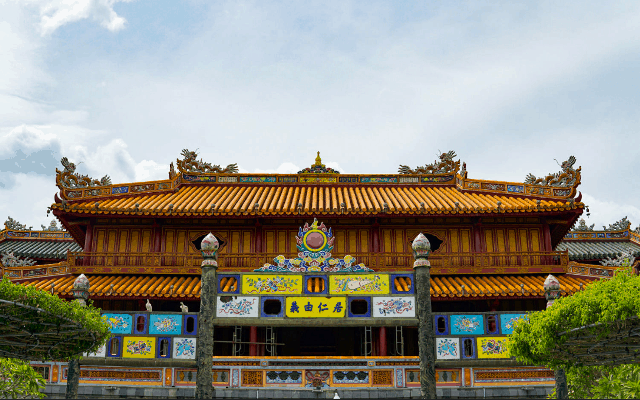
This special construction, which is the most powerful symbol of the Nguyen Dynasty, is the historic witness of a lot of battles especially the Tet Mau Than Offensive in 1968.
Nowadays, thanks to the gifted craftwork and enthusiastic support, it appears stunning with a new appearance.
5.3 Thai Hoa Palace (Supreme Harmony Palace)

In this most important palace, only twice a month, following the Lunar calendar, Emperor worked inside with the 4 highest-ranking mandarins, other mandarins were in the royal courtyard, entering inside to do business with the emperor. Thai Hoa Palace was only used for some special ceremonies such as the coronation of 13 Emperors, the Emperor’s birthday, and significant meetings with envoys from other countries.
Even though it was under renovation, and large-scale reconstruction, it remains its main historic beauty. Distinctively, the palace’s roof is famous for its unique style. It comprises the upper roof, the lower one, and the eaves. On a closer look, at the roof, there are many dragons, suns, and moon images. Honestly, they symbolize the emperor and Oriental philosophy.
5.4 Duyet Thi Duong Royal Theater
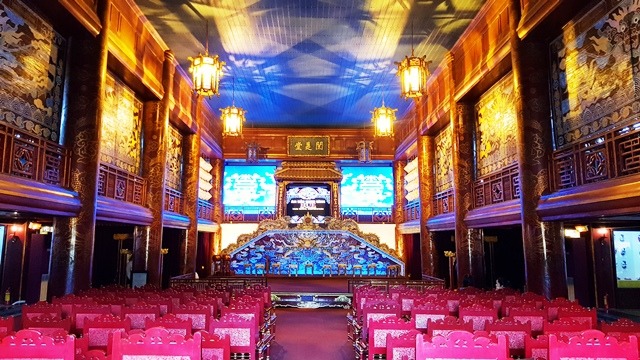
Under the reign of the Gia Long Emperor, they constructed this building for Emperors and royal family members to entertain and enjoy conventional art performances, especially royal dance, dramas, and royal court music.
Furthermore, Duyet Thi Duong theater is the place for royal banquets and nowadays, for special festivals, this theater is the venue to display Hue Royal Court music, which is a Unesco world Masterpiece of Oral and Intangible heritage.
5.5 The To Temple (The Royal Family Temple)
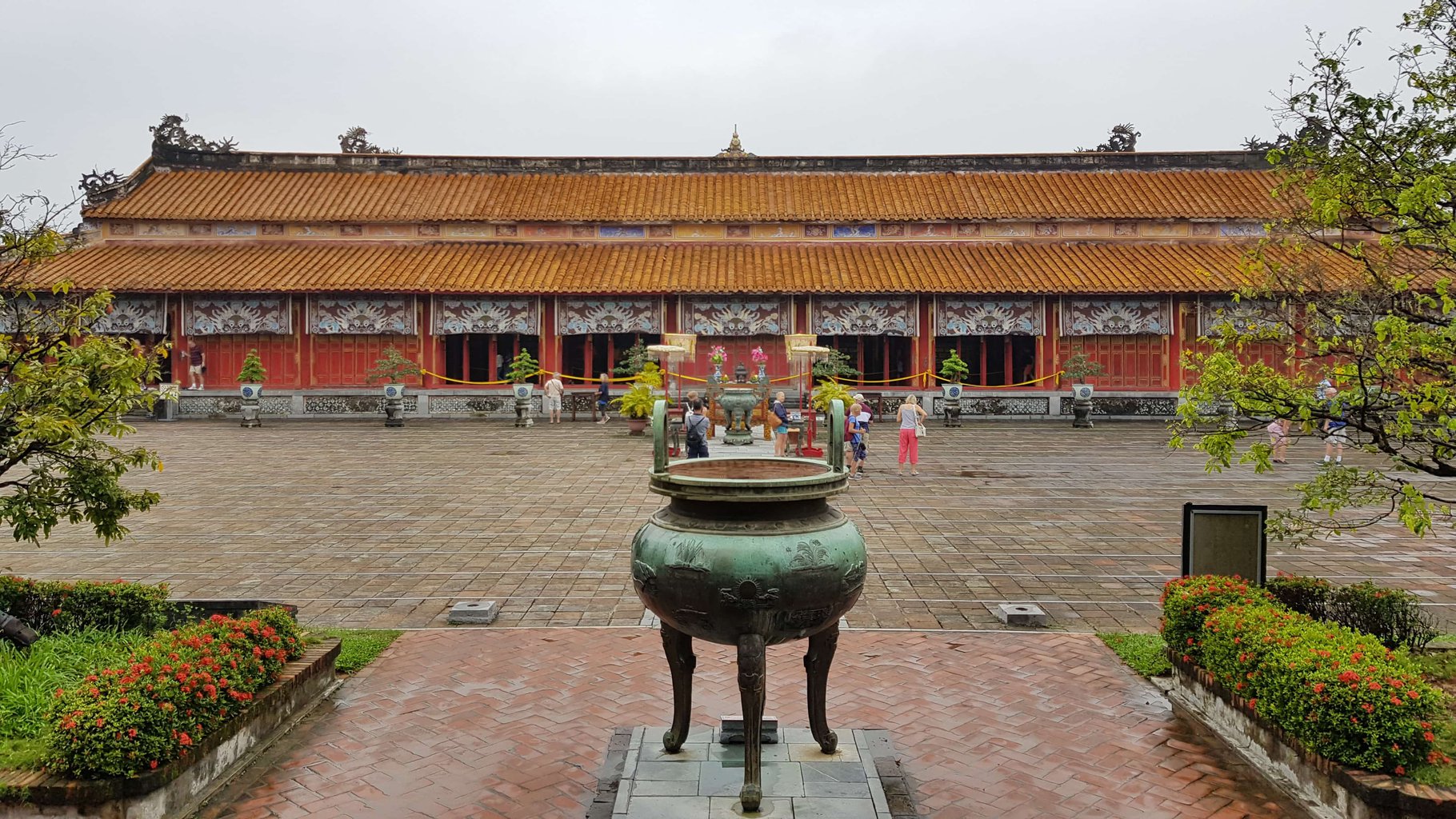
It was constructed in 1821 by Minh Mang Emperor in order to worship Emperor Gia Long, the founder of the Nguyen dynasty. Lately, they worship almost Emperors of the Nguyen Dynasty .
3 deposed Emperors such as Duc Duc, Hiep Hoa, and Bao Dai are not allowed to be worshiped. In the past, women could not enter.
View more: Hue Royal Tombs Tour
5.6 Cung Dien Tho
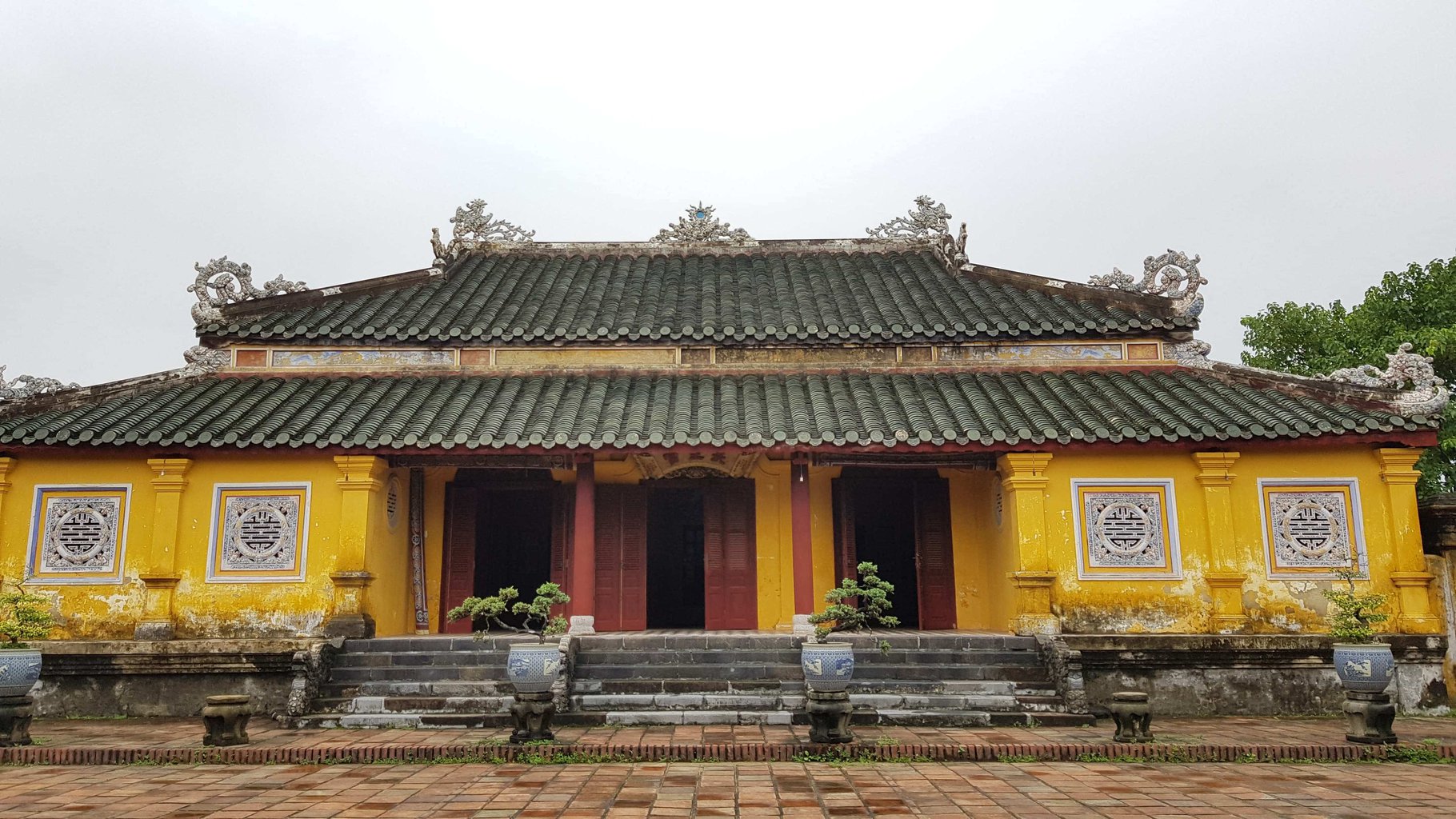
It was the private residence area of the Emperor’s mother and grandmother. it is the most massive building which is kept intact nowadays. Accurately, this construction consists of over 10 buildings that were covered with rectangular-shaped walls.
The buildings in this place were connected with a roofed corridor system. Every day, the Emperor walked in this corridor to visit his mom.
6. Things to know before visiting Hue Citadel
6.1. hue citadel – vietnam entrance fee.
To explore the complex of Imperial Hue City, you have to buy an entrance ticket. Your ticket will a big contribution to the conservation, and rebuilding of the Unesco Heritage. Hue Imperial City entrance fee costs VND 200.000/ person ( approximately USD 8.7 ) for adults and VND 40.000 (roughly 1.7 USD ) for kids from 5 to 12 years old. Children under 5 years old are free of charge.
HUE Entrance Fee Monuments in 2023
Some reference information about the Hue entrance fee is just advice from Culture Pham Travel . The Hue entrance fee will be different depending on the season, time, children, as well as group policy…If you join the tours of Culture Pham Travel . Entrance fees will be included in the tour fee.
6.2. Citadel Hue Vietnam opening hours
Honestly, the Hue Imperial City is so massive that you can spend half a day discovering it. Therefore, you can visit this place from 7 a.m to 5 p.m. It opens every day even during the Lunar New Year ( Tet holiday ).
In April and June, there are many colorful festivals such as Kite or Ao Dai festivals, and both of them attract a huge number of foreign and domestic visitors. Therefore, if you come here on these special occasions, you might experience many interesting cultural activities.
7. Amazing activities in Hue imperial city.
If tourists wish to be the Emperor, prince, or princess in the modern time, their desire can be true when they come to Hue historic citadel. In this ancient place, they have the chance to put on Imperial clothes to take photos.
Additionally, the journey is pretty long and tourists may feel tired on boiling days, you can take the electric golf cars with 8 seats to help reduce their exhaust at affordable prices. Moreover, there are some royal music performances in the royal city that you can enjoy for free.
With a group of 8 people, you will get a free souvenir photo from the local photographers in the citadel. These days, you can get the audio guide service with multi-languages so you can easily enjoy and spend your time in Hue Imperial city as much as you like.
8. How to get to Hue Citadel?
There are many ways to get to Hue Citadel such as walking, booking grab bikes, or catching a cyclo. Another way to enjoy a sense of authentic experience and deeply understand is with a knowledgeable local tour guide, let’s join Hue imperial city guide: Hue city tour 1 day | Hue City Tours full day with Culture Pham Travel .
It is advisable to bring sunglasses, suncream, and as well as boiled water with you. Besides, don’t forget to take your umbrella or raincoat in case it rains.
Especially, the Hue Citadel will be more sparkling in Hue Festival . Plus, it will be more interesting if you wear the Hue Imperial City dress code such as Ao Dai. Let’s join us to explore Hue Imperial City with us!
Culture Pham Travel
14 thoughts on “ Hue Imperial City of the Nguyen Dynasty ”
Pingback: HUE TOURS AND THINGS TO DO IN HUE - Culture Pham Travel
Pingback: [Update] ENTRANCE FEES IN HUE - VIET NAM 2020 - Culture Pham Travel
Pingback: The Best Things To Do In Hue in 2020 - Culture Pham Travel
Pingback: THINGS TO DO IN HUE VIETNAM 2020 - Culture Pham Travel
Pingback: Duyet Thi Duong Theater-Hue Royal Theater - Culture Pham Travel
Pingback: An Hien Garden House Hue - Culture Pham Travel
Pingback: Tu Dam Pagoda in Hue City - Phong Nha Locals Travel & Transport
Pingback: Hue Private Cars - Hue Car Rental - Hoi An Private Taxi
Pingback: Thai Hoa Palace In Hue Imperial City - Phong Nha Locals Travel & Transport
Pingback: Tomb Of King Thieu Tri In Hue, Vietnam - Phong Nha Locals Travel & Transport
Pingback: Perfume River Hue - Huong River Vietnam Travel Guide - Phong Nha Locals Travel & Transport
Pingback: Thai Hoa Palace - Nguyen Dynasty Magnificent Architecture - Culture Pham Travel
Pingback: Khai Dinh Tomb Hue Vietnam - Culture Pham Travel
Pingback: Transfer from Phong Nha to Hue - Phong Nha Private Car Blog
Leave a Reply Cancel reply
You must be logged in to post a comment.

Username or email address *
Password *
Log in Remember me
Lost your password?

Sign Up Today
Start your 14 day free trial today

The History Hit Miscellany of Facts, Figures and Fascinating Finds
Imperial City of Hue
Hue, Thua Thien-Hue Province, Vietnam
The Imperial City of Hue was the capital of Vietnam from 1802 to 1945 and is now a complex of monuments listed as a UNESCO World Heritage Site.

Peta Stamper
20 jul 2021.

About Imperial City of Hue
The Imperial City of Hue was the capital of Vietnam from 1802 to 1945 and of vital importance to the last Vietnamese royal house of the Nguyen Dynasty. As the country’s political, cultural and religious centre for this period, Hue boasts an array of architectural treasures and UNESCO has described it as an “outstanding example of an eastern feudal capital”.
Of particular significance is the way in which the city was integrated within its natural surroundings.
Imperial City of Hue history
Nguyen Anh ascended the throne of a newly unified Vietnam in 1789 and immediately proclaimed himself Emperor Gia Long with Hue. The new ruler consulted divination to decide where a new city should be built, and in 1804 construction began on the Imperial City of Hue with thousands of workers ordered to build the citadel and moat.
The city suffered in 1947 when the Viet Minh seized the citadel. A French counter attack besieged the city and a 6-week battle destroyed many major buildings and the Imperial Palace was burned. Later, during the Battle of Hue in 1968, US troops were ordered to hold shelling on the city because of its heritage. However, these restrictions were gradually lifted.
Imperial City of Hue today
Listed as a World Heritage Site since 1993, the site of the Imperial City of Hue is actually a vast complex of monuments spread over 4 kilometres and encompassing some 140 constructions of varying sizes including temples, pavilions, a library and even a theatre. This was all protected by three circles of impressive ramparts reinforced by 24 bastions and pierced by 10 intricately decorated gates.
Many sources refer to the city as the citadel, but the Hue Citadel is just one aspect of its remains, within which are set the Imperial Residence, the Imperial City or Hoang Thanh and the Forbidden Purple City or Tu Cam Thanh as well as administrative and military structures.
Beyond its Citadel, the Imperial City of Hue has an array of sites, including fortresses such as Tran Hai Thanh and Tran Binh Dai. Further out, one can find its spiritual quarter with its temples and tombs.
Getting to the Imperial City of Hue
Located in Thanh pho, Hue, the Imperial City sits opposite the river from the new buildings and accommodation and therefore is an easy walk away. Otherwise you can use the Grab app to hop into a taxi there.
Featured In

Vietnam Historic Sites
Known for its stunning natural beauty, complex history, and famous hospitality, Vietnam is home to a number of key sites for any history lover.

Related Articles

Would JFK Have Gone to Vietnam?

17 Important Figures in the Vietnam War
Watch and listen.

Seymour Hersh on My Lai, Watergate, Abu Ghraib & Trump

Why Vietnam?
You may also like.

5 Fascinating Historic Sites in Vietnam

The World’s Most Notorious Historic Prisons

Ho Chi Minh Mausoleum

Ho Chi Minh Museum

Hoa Lo Prison

Egypt’s 6 Cultural UNESCO World Heritage Sites

Historic Centre of the City of Pienza

Historic Centre of Siena

Historic Centre of Florence

Venice and its Lagoon

Historic Centre of San Gimignano

Historic Cairo

Regio V, Pompeii

IMAGES
VIDEO
COMMENTS
The Imperial City Of Hue Opening Hours. The opening hours for the Imperial City of Hue are from 8:00am-5:30pm Friday to Wednesday. On Thursdays, the Imperial City of Hue opens at 8:00am and closes at 10:00pm. This allows visitors to experience the Imperial City of Hue by night and be able to see the grounds in a whole new way.
According to Tripadvisor travelers, these are the best ways to experience Hue Imperial City (The Citadel): Hue city tour with private english speaking driver: see royal tombs and more (From $29.99) Hue City Full-Day Tour (From $73.00) Hue full day guided tour with 5 must see places in Hue (From $62.57) Hue Imperial City Private Tour (From $130.00)
1 - Ngo Mon (Hue Noon Gate or Meridian Gate) 2 - Thai Hoa Palace in Hue Imperial City. 3 - Duyet Thi Hall in Hue Citadel. 4 - Can Chanh Palace in Hue Imperial City. 5 - Dien Tho Palace in Hue Imperial City. 6 - Long An Palace in Hue Citadel. III - Essential information about the Ancient Imperial City of Hue.
The Imperial City is not just a highlight of Hue, it's one of the most impressive heritage sights in all of Vietnam. It's worth visiting the Hue Imperial City for its art and architecture, and to explore the history of this pivotal era. The Imperial City still takes up quite a large area of central Hue and it's certainly the most ...
Hue Imperial City Highlights and boat trip: PRIVATE Full-day Tour from Da Nang. 1. Historical Tours. from . $147.00. per adult (price varies by group size) Sight-Seeing Travel Bus from Hoi An to Hue. 3. Historical Tours. from . $12.17. per adult. Hue City Tour From Da Nang. 12. Historical Tours. from .
How to get to Hue Imperial City Transportation guide. Hue is about 100 km from Da Nang, and the journey takes approximately 2 hours to 2 hours and 30 minutes.. The best way to travel from Danang to Hue is by train, as you can enjoy the scenery of Hai Van Pass along the way.. Traveling by bus is another option to get from Da Nang to Hue.
Bun bo Hue is the city's signature dish, comprising an intensely flavoursome oxtail broth, vermicelli noodles, beef, pork and fresh herbs, infused with lemongrass, chilli and shrimp paste. Banh khoai, banh beo and nem lui are also ubiquitous. One of the best ways to experience Hue's culinary delights is to join a street food cyclo tour ...
The Imperial City is located inside the Citadel. It was recognized in 1993 as a UNESCO World Heritage Site. The city of Hue will be the capital, as this place was chosen very carefully. The river and mountains surrounding Hue were said to resemble snakes and lions. It was the perfect place to recreate a version of Beijing's Forbidden City.
Book your tickets online for Hue Imperial City (The Citadel), Hue: See 11,142 reviews, articles, and 14,177 photos of Hue Imperial City (The Citadel), ranked No.5 on Tripadvisor among 100 attractions in Hue.
The massive Hue Citadel is the most well-known and iconic site in Hue. Begun in 1805 by Emperor Gia Long, it is actually a sprawling complex comprised of the Imperial City, several museums, lakes, and beautiful gardens, all laid out in a series of concentric circles. We also visit Hue Royal Antiques Museum.
Taking a day trip is the best way to explore the Imperial City of Hue from Da Nang. The tour includes roundtrip transfer from the hotel, entrance tickets, lunch and a local knowledgeable guide. In addition to the walled city, visitors also have the chance to learn about Vietnamese history in 19 th and 20 th century in other places.
Travelers short on time in Central Vietnam can explore one of its finest historic attractions, the UNESCO-listed Hue Imperial City, on an easy day trip from Danang. History enthusiasts will love the many palaces, tombs, pagodas, and other Hue Dynasty structures in the ancient city. Learn more about its history on a guided group tour.
Visit Thien Mu pagoda - The oldest pogoda in Hue city. Then you will transfer by car to visit: Hue Imperial Citadel - the home of Vietnam's last royal dynasty - the Nguyen Dynasty. Having lunch with local Restaurant. Transfer by car to visit: Khai Dinh King's Tomb - which is a blend of Western and Eastern architecture.
The history of Hue imperial city; When to travel to Hue. 1. Weather in Hue; 2. When is the best time to visit Hue, Vietnam; How to travel to Hue. 1. Getting to Hue; 2. Getting around Hue; What to do and see in Hue. 1. The Citadel 2. Hue's Royal Tombs and Pagodas; 3. Vong Canh Hill; 4. Nam Giao Esplanade; 5. An Dinh Palace; 6. Off the Beaten ...
Price: VND 150.000/person. The Imperial City is a historical place that tourists must visit when traveling to Hue. Being the Nguyen Dynasty's ancient capital for 143 years, Hue imperial city is recognized as a World Heritage Site by UNESCO. With an area of 520 ha, Hue imperial city is divided into two regions.
First, let me take you back to the early 19th century when the citadel was first built. Thousands of workers were instructed to build ramparts and dig a 10 km (6.2 miles) long moat surrounding the 500 hectare (1.93 square miles) area. It took them around 30 years to complete. It was in the honor of Nguyen Anh, the Emperor Gia Long.
Set out on a fascinating journey through the historical wonders of Hue Imperial City with a full-day trip from Hoi An/Da Nang. The trip offers a chance to explore the city's rich historical significance and take in the local culture. Visitors can marvel at the architectural wonders of the city, which showcase a blend of traditional Vietnamese and colonial influences.
Nơi yêu thích nhất miền Trung Việt Nam. The Imperial City of Huế is a walled enclosure within the citadel of the city of Huế, the former imperial capital of Vietnam during the Nguyễn dynasty. It contains the palaces that housed the imperial family, as well as shrines, gardens, and villas for mandarins1.
Set out on a captivating journey through Hue's rich history and vibrant culture with the Imperial City Sightseeing Trip. This tour offers a deep dive into the historical significance and architectural beauty of Hue's most iconic landmarks. Visitors will be awe-inspired by the Hue Imperial City, which served as the home of Vietnam's last royal dynasty.
Under Minh Mang's reign, the Hue Imperial City (Hue Citadel) was finally completed in 27 years, from 1805 to 1832, making it the most gigantic edifice ever erected in modern Vietnamese history, using thousands of employees, millions of cubic meters of rock, and a significant amount of onerous duty. With a total land area of 520 acres, the ...
The Hue Imperial City Walking Tour is the best option for you. Booking our Hue Imperial City Tour, you will have 2.5 hours exploring the complex of Hue Imperial Citadel (Hue Citadel, Hue Royal City & Forbidden City). Our excellent local guide will tell you a lot of stories and interesting information about the royal life of 13 Emperors ...
Hue Imperial City- Culture Pham Travel. Located on the North bank of the Perfume River, in the center of the city which is 10.000 m in circumference. Fascinatingly, based on geographic and Fengshui principles. The emperors constructed the Hue City Citadel facing the South and picked Ngu Binh mountain as the front screen.
The Imperial City of Hue was the capital of Vietnam from 1802 to 1945 and of vital importance to the last Vietnamese royal house of the Nguyen Dynasty. As the country's political, cultural and religious centre for this period, Hue boasts an array of architectural treasures and UNESCO has described it as an "outstanding example of an eastern feudal capital".